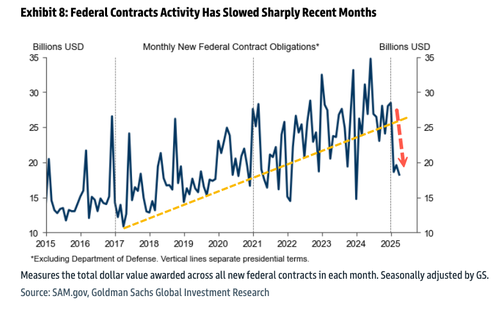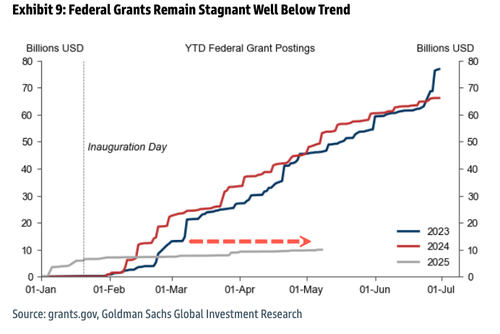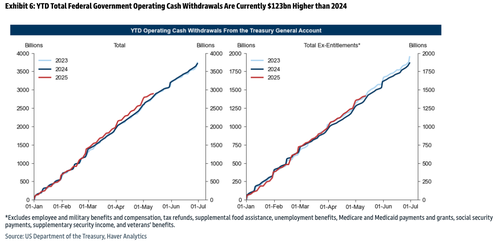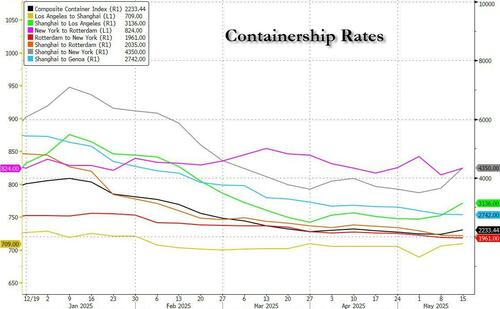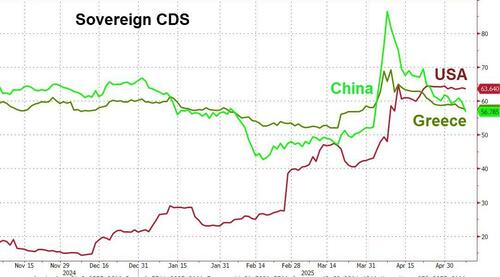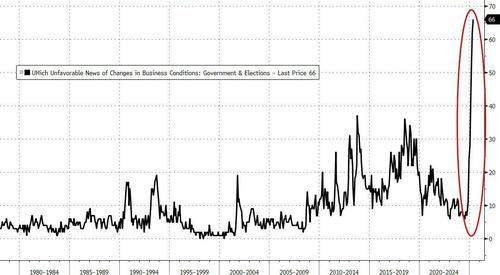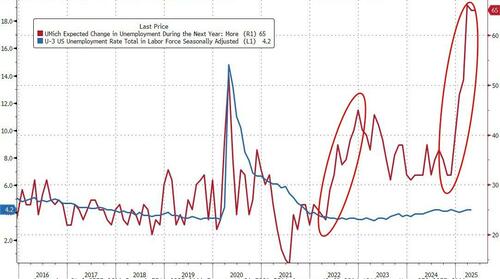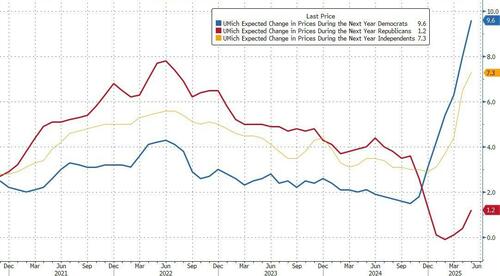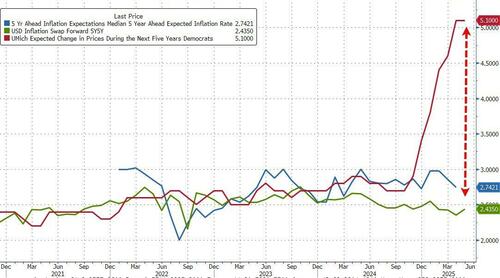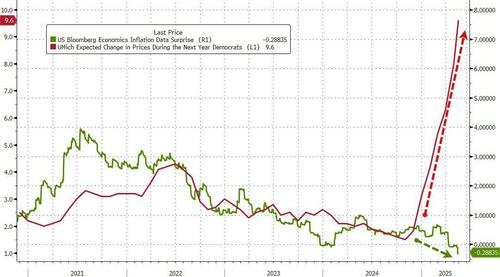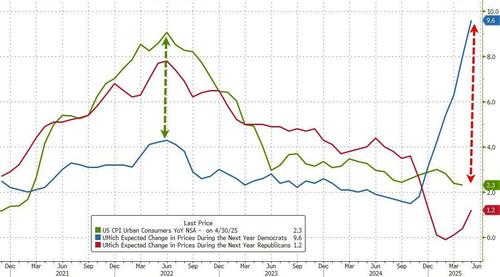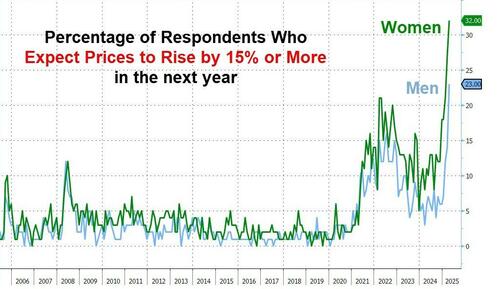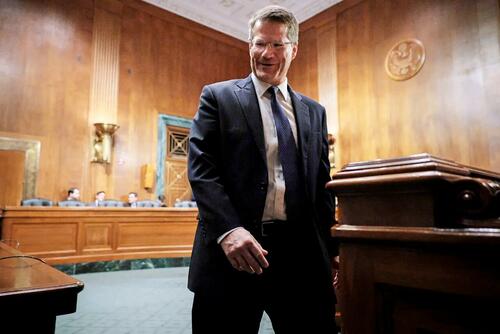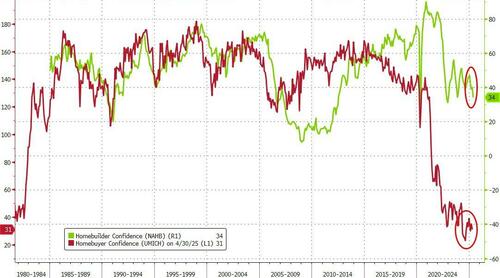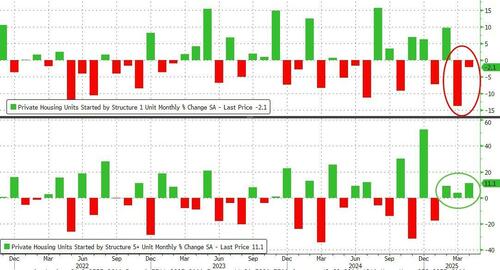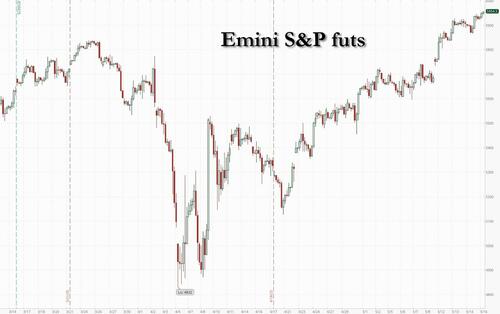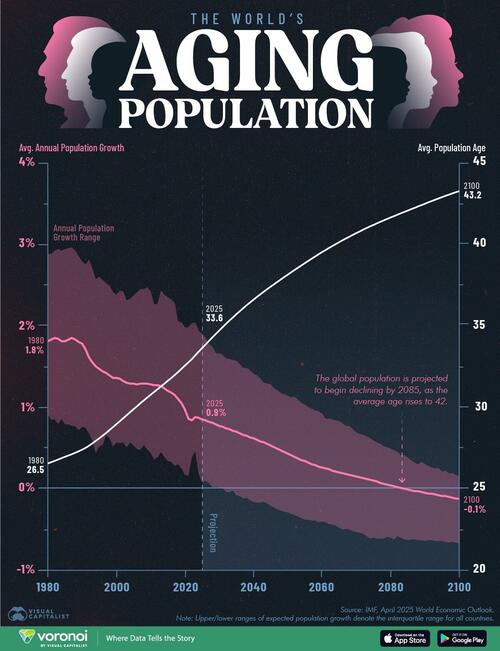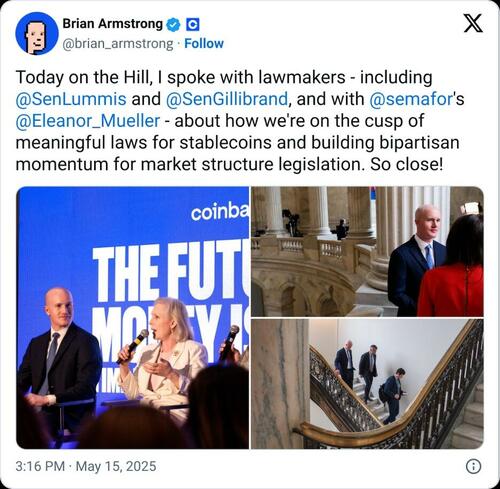Celibacy is always, shall we say, an affront to what man normally thinks. It is something that can be done, and is only credible, if there is a God and if celibacy is my doorway into the kingdom of God.
Distinction Matter - Subscribed Feeds
-
Site: Zero HedgeHow Legal Immigration Is Keeping Farms AfloatTyler Durden Fri, 05/16/2025 - 21:30
Authored by Darlene McCormick Sanchez via The Epoch Times (emphasis ours),
LAKE VILLAGE, Ark.—On a breezy day, sun and shadow dance across Mencer farms, turning it into a patchwork of green in the fertile Arkansas Delta.
It is humid here in the deep South, where the clock seems to run slower and the temperature hotter than in other places.
 Joe Mencer, owner of Mencer Farms in Lake Village, Ark., on April 29, 2025. Samira Bouaou/The Epoch Times
Joe Mencer, owner of Mencer Farms in Lake Village, Ark., on April 29, 2025. Samira Bouaou/The Epoch Times
Lake Village is a small town sitting along Lake Chicot, an abandoned channel of the Mississippi River. Over thousands of years, flooding deposited rich alluvial soil, making it ideal for crops such as rice, cotton, soybeans, and corn.
As a child, William Mencer’s grandfather handed him a cowboy hat and a garden hoe to dig up the pigweeds growing between the crop rows.
The 31-year-old farmer remembers spending long, sweltering days alongside the farmworkers, his hands growing rough and calloused with the effort.
“So I learned, you know, what it was like for these workers,” he told The Epoch Times.
He vowed to escape the sweat and toil of the fields by going to law school and working in an office. But the family farm drew him back like a love song.
Now he is partnering with his father, Joe Mencer, to keep the farm afloat with temporary agriculture workers through the H-2A visa program.
The fourth-generation family farm, which costs $4 million per year to operate, includes 6,000 acres that they own and lease.
While some may claim agriculture needs illegal immigrants to pick crops and work the fields, Joe Mencer told The Epoch Times that they’ve never had an illegal immigrant come looking for work.
They can’t get anyone local to work either, meaning that if they didn’t have the guest farm workers, they couldn’t stay in business.
What Is the H-2A Visa?
It costs more to bring in temporary legal workers than it would if they could find enough people locally to work. But without temporary migrant workers, William Mencer said local farms would go bust, affecting the nation’s food security.
The process has become much more complex since the Mencers began using the guest worker program back in the 1980s.
So much so that the younger Mencer started a small law practice helping other farmers obtain the labor they sorely needed.
He also shares his knowledge with other farmers as a member of the Arkansas Farm Bureau.
The process of hiring workers through the program, sometimes called a guest worker program, starts early in the year for the Mencer family.
 William Mencer, who works on his fourth-generation family farm, at Mencer Farms in Lake Village, Ark., on April 29, 2025. He partners with his father to keep the farm running with the help of temporary agricultural workers through the H-2A visa program. Samira Bouaou/The Epoch Times
William Mencer, who works on his fourth-generation family farm, at Mencer Farms in Lake Village, Ark., on April 29, 2025. He partners with his father to keep the farm running with the help of temporary agricultural workers through the H-2A visa program. Samira Bouaou/The Epoch Times
The paperwork needs to be filed 60 to 75 days before their start date, which is mid- to late-February, he said.
It costs as much as $5,000 to bring in several guest workers from Mexico to the United States, he said, noting that the cost doesn’t include the housing and transportation provided to the workers.
Most return home in mid-December, but they are eligible to stay for up to three years in certain situations when agricultural work is available.
The program requires the Mencers to advertise their farm jobs locally before they can be given to guest workers.
Joe Mencer, 65, noted that the rules call for him to fire any foreign worker he’s brought over if an American shows up and wants the job.
Tangled in Red Tape
The process to petition for workers with the U.S. Citizenship and Immigration Service is antiquated, with all communications taking place via mail, according to William Mencer.
The government does not offer online services, email, or a phone number. If there’s a problem, then the farm’s labor source is jeopardized because of the lack of communication, he said.
“Sometimes things get lost in the mail. You know, literally,” he said.
One of his client’s petition paperwork didn’t arrive in the mail. So they filed a claim for the lost package and resubmitted the paperwork.
This time, the paperwork made it to the Dallas office, but the postal carrier found the original package and shipped it, too.
With both petitions filed with the government, it almost took an act of Congress to clear it up.
The younger Mencer sent a letter explaining what happened with the evidence to the government officials, just like he would in court, but the office didn’t respond.
He enlisted the help of his congressman to clear things up. By the time it was all done, his client was behind by a month in getting guest workers.
It makes him wonder if the difficulty and red tape is “by design.”
 Joe Mencer, owner of Mencer Farms in Lake Village, Ark., on April 29, 2025. The Mencer family began using the H-2A visa program in the 1980s to bring in foreign workers. The program, often called the guest worker program, requires employers to first advertise farm jobs locally before hiring foreign labor. Samira Bouaou/The Epoch Times
Joe Mencer, owner of Mencer Farms in Lake Village, Ark., on April 29, 2025. The Mencer family began using the H-2A visa program in the 1980s to bring in foreign workers. The program, often called the guest worker program, requires employers to first advertise farm jobs locally before hiring foreign labor. Samira Bouaou/The Epoch Times
The workers are so important that the Mencers keep them busy even when the weather is bad, although it doesn’t help their bottom line.
When there’s no field work, they cut firewood for use in the winter months.
Joe Mencer said he realized a few years back that his son’s law degree would be helpful on the farm, especially given the increasing complexity of the H2A visa program.
Guest Worker Success
The Mencers said their farm couldn’t operate without H-2A visa workers, although the labor cost is higher than using local workers.
Farmers’ margins are already slim because of increased production costs for fertilizer, herbicides, seed, and fuel.
José Mondragon, who started as an H-2A visa worker, is now a green-card holder. He has worked for the Mencer family for nearly 30 years.
Others, such as Gabino Mondragon (no relation to José Mondragon) are H-2A visa holders who have only been working at the farm for a few years.
José Mondragon lives with his wife in a little house on the farm surrounded by flowers and trees. The 57-year-old has deep roots in the land, even serving as a pallbearer when Joe Mencer’s father passed away.
In late April, he operated a self-driving orange Case Magnum row crop tractor, which plowed the earth between the corn rows to improve irrigation.
José Mondragon said he’s seen American workers quit after two or three months, long before the crops are harvested in the fall. The lack of local workers can open the door for temporary visa workers, which is good for everyone, he said.
“The people [are] asking us if we have some opportunities to come with my boss, and we say we will ask him,” he said.
José Mondragon said some people come to the United States illegally because they get into trouble with the law back home or to escape the cartels. Others come to make more money to help support their families in their native countries.
Workers from Mexico make $14.83 per hour on the Mencer farm as legal workers, with the wage set by the government for each state.
 Green card holder Jose Delores Mondragon operates a tractor at Mencer Farms in Lake Village, Ark., on April 29, 2025.
Green card holder Jose Delores Mondragon operates a tractor at Mencer Farms in Lake Village, Ark., on April 29, 2025.
José Mondragon said human smugglers, known as coyotes, charge people big money to cross the southern border illegally.
Gabino Mondragon has been working at the Mencer farm on a guest visa for two years. He is experienced at running a spreader for nitrogen fertilizer for corn. One truckload of fertilizer can cost $20,000, according to William Mencer, so having a skilled operator is critical.
Gabino Mondragon believes that more people in Mexico would like to apply for an H-2A visa. Still, if they are caught coming into America illegally, they won’t be eligible unless they get a waiver. It would depend on their record.
The Mencers brought Gabino Mondragon’s family over on an H-4 visa so they could live close by while he worked.
The H-4 nonimmigrant visa allows the spouse and unmarried children younger than 21 years of age to accompany the primary visa holder to the United States.
It’s also an excellent opportunity for Gabino Mondragon’s family because his children are going to school and learning English.
“If our people are happy, it just reinforces that it’s a good thing for everybody,” William Mencer said.
Hanging by a Thread
The high cost of labor, diesel, and chemicals is making it extremely difficult for family farms to stay in business, according to William Mencer.
“We’ve been in four or five really bad years now,” he said.
Some farmers are faced with losing their farms to foreclosure by banks over crop production loans, finding a different line of work, or selling out.
Read the rest here...
-
Site: Zero HedgeFederal Contract Activity Slows As DOGE's Cost-Cutting Measures Take EffectTyler Durden Fri, 05/16/2025 - 21:00
President Donald Trump and Elon Musk's DOGE (Department of Government Efficiency) have exposed widespread federal waste and mismanagement that Congress long ignored. Despite the existence of oversight bodies like the Government Accountability Office, it took an executive order to uncover billions of dollars in egregious federal waste.
DOGE's drive to cut waste and root out fraud in the bloated federal bureaucracy has already resulted in nearly 300,000 job cuts and an estimated $160 billion in savings. As detailed in our series of reports, DOGE's actions are delivering tangible results—helping to reduce the nation's overall funding requirements.
The debt-fueled spending spree under the Biden-Harris regime placed the nation on a crash course to financial ruin—but recent corrective actions by the Trump administration and DOGE, for now, have helped steer the trajectory away from a financial crisis.
Readers may recall some of those tangible DOGE-related results:
-
US Treasury Unexpectedly Reports Sharp Drop In Debt Borrowing Needs, Rates Slide
-
US Treasury Shocks With Second Biggest Budget Surplus In History
-
Jobless Claims Jumped Last Week As 'DOGE Actions' Spark Biggest YTD Layoffs Since 2020
-
Is DOGE Starting To Work? 'Deep TriState' Jobless Claims Surged Last Week
Some progresshttps://t.co/hNCBVYB4YV
— Elon Musk (@elonmusk) April 11, 2025Everything outlined above points to a solid start for DOGE, which has already uncovered hundreds of billions in waste, fraud, and abuse. However, that progress could be undone unless Congress moves to lock in those spending cuts through the reconciliation bill.
DOGE has identified hundreds of billions of dollars of waste, fraud, and abuse, but unless Congress makes those spending cuts permanent through the reconciliation process, all that work will have been for nothing.@Paul_S_Mullen pic.twitter.com/7Y8j4T5ehJ
— Heritage Foundation (@Heritage) May 5, 2025Another measure of DOGE's early success is the 20.5% reduction in non-defense federal obligations compared to 2024 levels—a decline that signals reduced future cash outlays as these obligations come due.
"Persistent government-wide contract reviews for wasteful spend, consistent with the DOGE Cost Efficiency Executive Order, are bearing fruit," DOGE's official X account wrote.
Adding to the visible signs of progress, Goldman chief economist Jan Hatzius, along with analysts Alec Phillips and others, noted Thursday that cash withdrawals from the Treasury General Account across several federal agencies continue to fall below 2023 and 2024 levels—yet another encouraging sign of success.
Also, new monthly federal contract obligations have sharply slowed under DOGE after four years of large spikes under the Biden-Harris regime.
"Notably, new federal contracts data has undershot trend in recent months and stood at $18.2bn in April (compared to $31.1bn in April 2024). Total government grant awards remain stagnated at Inauguration Day levels," the analysts said.
More color here.
However, Hatzius and his team noted that year-to-date cash withdrawals from the Treasury General Account remain $123 billion above 2024 levels.
The early results of DOGE mark a shift in federal accountability. In just months, DOGE has uncovered hundreds of billions in waste, slashed nearly 300,000 federal jobs, and driven $160 billion in savings. Yet why did it take an executive order from the president to have a group take a deep dive into how federal agencies spend their money?
But this progress is not guaranteed. Without congressional action to lock in these cuts through reconciliation, the swamp remains open for the bureaucratic bloat to return. The message is clear: DOGE is working, but can only be sustained through political action.
-
Site: Zero HedgeJordan's King Warned US Against Assassinating Syria's Sharaa Before Trump MeetingTyler Durden Fri, 05/16/2025 - 20:30
Jordan’s King Abdullah II warned the US against assassinating President Ahmed al-Sharaa before the new Syrian leader met with President Donald Trump, a US senator said on Thursday.
The remarkable statement by a US senator reveals the deep hostility toward Sharaa in some circles of the Trump administration. It reaffirms Trump's own statements that he has been lobbied directly by foreign leaders to give Sharaa a chance, while his own advisors are skeptical.
"I have been concerned by some rumors that I have heard in…some foreign policy circles of the administration that one option that’s been suggested is assassinating the new leader of the Syrian government, Ahmed al-Sharaa," Democratic Senator Jeanne Shaheen said in a Senate hearing on Thursday.
 US Senator Jeanne Shaheen, via AP
US Senator Jeanne Shaheen, via AP
According to Shaheen, Jordan’s King Abdullah II heard about the alleged discussions to assassinate Sharaa and warned against it.
“One of the things that was pointed out to us by King Abdullah was that a change in leadership of that kind would create an all-out civil war in Syria. That would not be good to take advantage of the opportunity we have to move that country forward,” Shaheen said.
Shaheen met with King Abdullah in Washington, DC, in May, suggesting that those discussions may have taken place just before Trump cancelled sanctions on Syria and met Sharaa. Shaheen made the remarks during her questioning of Joel Rayburn, Trump’s nominee for undersecretary of state for the Near East, the top Middle East position in the State Department.
The admission by Shaheen is remarkable, given the events of this week. Trump surprised his own senior officials and Israel by announcing he was lifting all sanctions on Syria. Trump then held a meeting with Sharaa in Riyadh on Wednesday.
Speaking to reporters on Air Force One after the meeting, Trump showered praise on Sharaa, saying he was a “young, attractive guy. Tough guy. Strong past. Very strong past. Fighter”.
Asked to comment on the assassination "option", Rayburn replied, “I’m not familiar with efforts like that, but that's clearly not in line with the president's intention…or his description of Sharaa in the past couple of days.”
Blindsided
Trump’s decision to remove all US sanctions on Syria, going back to 1979, was met with thunderous applause in Riyadh, but has annoyed members of the US government. Some in the US State Department who have advocated for sanctions relief also felt sidelined.
It must have been a tense meeting yesterday in Damascus between HTS chief Jolani and the head of Iraqi intelligence. Especially for the Iraqi delegation a hard pill to swallow as Jolani before his time in Syria was in Iraq with Zarqawi blowing up Iraqis. pic.twitter.com/mojl2jTmEd
— Jenan Moussa (@jenanmoussa) December 27, 2024Just a few days before the announcement, the State Department’s Syrian advisors were briefing foreign counterparts that the Trump administration was set to keep sanctions on the new government in Damascus, one regional official told Middle East Eye.
Meanwhile, hardline members of Trump’s National Security Council have told counterparts privately that they would try to drag out the sanctions relief process to obtain concessions from Sharaa, one current and one former US official told MEE.
Democratic Senator Chris Murphy warned on Thursday about members of Trump’s administration working to “undermine” his decision. Rayburn’s hearing was notable because he was seen as hard line on Syria when he served as envoy to the country during Trump’s first term in office.
“I support the President’s goals and his initiative as he laid out,” Rayburn said. “It offers a golden opportunity to turn the page…the president is taking a bold move…he has expectations.”
The White House says it wants Sharaa to expel Palestinian fighters and foreign fighters from Syria, and combat the Islamic State militant group. Trump also said he discussed Syria normalizing ties with Israel. "I told him, 'I hope you’re going to join when it’s straightened out.’ He said, ‘Yes.’ But they have a lot of work to do," Trump said, according to a White House pool report.
Sharaa was the commander of Hayat Tahrir al-Sham or HTS, an Islamist group which toppled the decades-long Assad dynasty in December 2024. Sharaa participated in the Iraq insurgency after the US’s 2003 invasion and served time in a US prison. He once pledged allegiance to al-Qaeda.
The Biden administration removed a $10m bounty on Sharaa's head in early 2025, but he is still designated a "global terrorist". That designation is likely to be removed now, given Trump's order, experts say.
Sharaa’s closest foreign ally is Turkey, but his country has also been moving towards the Gulf states. On Tuesday, Trump told the world he was asked to remove sanctions and had two advocates to credit, President Recep Tayyip Erdogan in Turkey and Saudi Crown Prince Mohammed bin Salman.
The UAE has been holding indirect talks between Israel and Syria to de-escalate tensions. Israel has been striking Syria for months and occupies a swath of southwestern Syria. The Trump administration lobbied Israel and Turkey to enter deconfliction talks in Syria earlier this year.
Ali al-Rifai, director of public relations in Syria's information ministry, was asked by Kan News after Trump’s announcment about the prospect of his country joining the Abraham Accords, the agreement curated by Trump in 2020 that saw a number of Arab countries recognise Israel. “Peace with everyone, without exception,” he responded.
-
Site: RT - News
The US president says he will impose new restrictions if Moscow fails to reach a peace deal with Kiev
US President Donald Trump has said Washington will impose new sanctions on Russia if it fails to reach a peace settlement with Ukraine. His remarks came shortly after the two countries held their first direct negotiations since 2022.
In an interview aired on Friday, Fox News anchor Bret Baier asked Trump whether he would introduce new sanctions on Moscow. “Honestly, I will if we’re not going to make a deal,” the president said. “Nobody uses leverage better than me.”
Trump added that the US would assess the outcome of Friday’s Russia-Ukraine talks in Istanbul. “We’ll see what happens. It will be crushing for Russia because they’re having a hard time with the economy,” he claimed. He also argued that his plan to boost domestic oil production would lower global prices, undermining Russia’s energy exports.
Read more Ukraine conflict could have ended in weeks – Russia’s top negotiator
Ukraine conflict could have ended in weeks – Russia’s top negotiator
Trump claimed that Russian President Vladimir Putin is “tired” from the conflict and said he would schedule a meeting with him sometime in the future. “I have a very good relationship with Putin. I think we’ll make a deal. We have to get together.”
As Trump has been trying to broker a deal between Russia and Ukraine, a group of senators led by Lindsey Graham has drafted a bill to impose sanctions on Moscow and levy tariffs on countries that purchase Russian oil, gas, and uranium.
The head of Russia’s negotiating team in Istanbul, Vladimir Medinsky, said the two sides had agreed upon a major prisoner swap involving 1,000 POWs from each side, as well as continuing contacts once each side has prepared a detailed ceasefire proposal.
-
Site: Zero HedgeThe Rise And Fall Of Synthetic Food DyesTyler Durden Fri, 05/16/2025 - 20:00
Authored by Marina Zhang via The Epoch Times (emphasis ours),
In 1856, 18-year-old chemist William Henry Perkin was experimenting with coal tar-derived compounds in a crude laboratory in his attic.
His teacher, August Wilhelm von Hofmann, had published a hypothesis on how it might be possible to make a prized malaria drug using chemicals from coal tar, and as his assistant, Perkin was hoping that he would be the one to discover it.
Illustration by The Epoch Times, Shutterstock
The experiment was a failure. Rather than the prized drug, Perkin created a thick brown sludge. However, when he went to wash out the beakers with alcohol, it left behind a bright purple residue.
The residue became the world’s first-ever mauve synthetic dye.
Before the invention of synthetic dyes, people obtained dyes through organic materials such as plants, clay, minerals, or certain animals such as insects and squid.
Natural dyes such as those from clay tended to fade quickly, and those that were long-lasting, such as natural indigo dyes, required an arduous extraction process that made them expensive.
However, Perkin’s mauve dye was stable and easy to make.
Mauve dye became an instant hit in the UK and globally. Consumers were seized by “mauve measles.” Everyone wanted a piece of it, including Queen Victoria, a fashion icon at the time who ordered mauve gowns, hats, and gloves.
Perkin’s discovery and commercial success prompted chemists in Europe to find more dyes in coal tar; magenta was discovered in 1858, methyl violet in 1861, and Bismarck brown in 1863.
Synthetic dyes would soon be added to everything—clothing, plastics, wood, and food.
The rapid innovation was not without consequences. Many dyes were found to be harmful within decades of discovery. More than a century later, the United States recently announced the removal of synthetic dyes from food.
Dyes in Food
For centuries, people have colored food to make it appear more appealing. Butter, for example, is not always yellow. Depending on the cattle feed, breed, and period of lactation, the color of butter can fluctuate seasonally, from bright yellow in the summer to pale white in the winter.
“Dairy farmers colored butter with carrot juice and extracts of plant seeds, called annatto, to give them a uniform yellow all year round,” Ai Hisano, an associate professor at the University of Tokyo specializing in cultural and business history, wrote in the Business History Review.
Butter is made at a factory in a biological treatment plant in Albertville, France, on April 26, 2016 (L); Butter melts on toast. Jean-Pierre clatot/AFP via Getty Images, Scott Olson/Getty Images
Natural colors, unlike artificial ones, are susceptible to changing pH, temperature, and moisture. They can change in hue and intensity, and yellows can become pale.
The practice of mass coloring and striving for uniformity likely emerged as a result of industrialization in the late 19th century, when packaged and processed foods became widely available, according to Hisano.
“Mass production and industrialization required easier, more convenient ways of making food, and using coal-tar dyes was one of the solutions for creating more standardized food products,” Hisano told The Epoch Times.
Since packaged foods lose freshness, they may lose color or look less natural. So previously, some companies would add compounds such as potassium nitrate and sodium sulfites to products such as meats to preserve their color. These compounds were relatively harmless.
More lurid examples include toxic metals such as lead used to color cheese and candies. Copper arsenate was added to pickles and old tea to make them look green and fresh, and reports of deaths resulted from lead and copper adulteration.
Dye companies started producing synthetic food dyes in the 1870s. Food regulation began in the 1880s. The Bureau of Chemistry, a branch of the Agriculture Department that would later become the Food and Drug Administration (FDA), looked into food adulteration and modification.
Dairy products such as butter and cheese were the first foods authorized by the federal government for artificial coloring.
Just as synthetic food dyes are a prime target of current Health Secretary Robert F. Kennedy Jr. and FDA Commissioner Martin Makary, they weren’t popular with Bureau of Chemistry head Harvey Wiley, who wrote in 1907, “All such dyeing materials are reprehensible, both on account of the danger to health and deception.”
Despite Wiley’s criticisms, by the time his book “Foods and Their Adulteration” was written, practically all the butter on the market was artificially colored.
“The object of coloring butter is, undoubtedly, to make it appear in the eyes of the consumer better than it really is, and to this extent can only be regarded as an attempt to deceive,” Wiley wrote, arguing that if the cows were properly fed during winter, they would naturally produce butter of the appealing yellow shade.
“The natural tint of butter is as much more attractive than the artificial as any natural color is superior to the artificial.”
The FDA
The previous year, in 1906, Congress passed the Food and Drugs Act, prohibiting the use of poisonous or dangerous colors in food. The FDA was formed on the same day the bill was made into law.
After the prohibition, the FDA approved seven synthetic food dyes—most of which would be banned in the 1950s after new animal studies indicated their toxic effects.
However, the FDA has always given greater scrutiny to synthetic dyes than to natural ones. Synthetic food dyes must be given an FDA certification before they can be used, but there is no requirement for natural dyes. While the FDA regulates synthetic dyes as a food additive, natural dyes can be regulated as generally recognized as safe, which is a less stringent authorization procedure.
In 1938, new laws were passed requiring all food dyes, whether synthetic or natural, to be listed on product labels.
By the 1950s, as oil and gas replaced coal as the main sources of energy, food dyes were no longer made with coal tar derivatives; they were made with petroleum-based compounds instead.
These new petroleum-based food dyes are considered very similar in composition and chemistry to their earlier coal tar counterparts, food scientist Bryan Quoc Le told The Epoch Times.
“Petroleum is cheaper, safer, and available in greater quantities,” he said.
The use of synthetic food dyes has been steadily increasing every decade. Data based on FDA dye certification suggest that food dye consumption has increased fivefold since 1955.
A 2016 study estimated that more than 40 percent of grocery store products that were marketed to children contain artificial colors.
Many packaged snacks contain synthetic food dyes. Scott Olson/Getty Images, Justin Sullivan/Getty Images
Cancer Concern
By the time Wiley became the first head commissioner of the FDA, experts were in contention over which food dye was riskier than the other. Over the following decades, dyes that were initially approved were gradually whittled down to the six remaining dyes of today.
In 1950, many children fell ill after eating Halloween candy containing Orange No. 1, a synthetic food dye. Rep. James Delaney (D-N.Y.) began holding hearings that prompted the FDA to reevaluate all approved color additives.
The hearing also led to the passing of the Delaney Clause, which prohibits the FDA from approving any food additive that can cause cancer in either humans or animals.
Orange No. 1 and several other approved dyes were removed after evidence of animal carcinogenicity.
The Delaney Clause was what prompted the removal of Red No. 3 in January under the Trump administration.
Professor Lorne Hofseth, director of the Center for Colon Cancer Research and associate dean for research in the College of Pharmacy at the University of South Carolina, is one of the few researchers in the United States studying the health effects of synthetic food dyes.
These dyes are xenobiotics, which are substances that are foreign to the human body, and “anything foreign to your body will cause an immune reaction—it just will,” he told The Epoch Times.
“So if you’re consuming these synthetic food diets from childhood to your adulthood, over years and years and years and years, that’s going to cause a low-grade, chronic inflammation.”
Hofseth has tested the effects of food dyes by sprinkling red, yellow, and blue food dyes on cells in his laboratory and observed DNA damage. “DNA damage is intimately linked to carcinogenesis,” he said.
His research showed that mice exposed to Red No. 40 through a high-fat diet for 10 months developed dysbiosis—an unhealthy imbalance in gut microbes and inflammation indicative of damaged DNA in their gut cells.
“This evidence supports the hypothesis that Red 40 is a dangerous compound that dysregulates key players involved in the development of [early-onset colorectal cancer],” Hofseth and his colleagues wrote in a 2023 study published in Toxicology Reports.
The mechanism of how food dyes cause cancer remains to be elucidated.
Hofseth speculates that the biological effects of red and yellow dyes may be attributed to the fact that they are what’s known as azo dyes. The gut hosts bacteria that can break down azo compounds into bioactive compounds that may alter DNA. Hofseth said he believes that if these bioactive compounds impair the gut, they may also contribute to the behavioral problems reported in some children after consuming food dyes.
Behavioral Problems
While the link between food dyes and cancer may remain elusive, the link between food dyes and behavioral problems in some children is much more accepted.
Rebecca Bevans, a professor of psychology at Western Nevada College, started looking into food dyes after her son became suicidal at the age of 7.
Read the rest here...
-
Site: Zero HedgeBiden-Hur Tape Drops, And Boy Is It Rough - Listen To All Five Hours HereTyler Durden Fri, 05/16/2025 - 19:47
Update: Listen to all five hours of the Hur-Biden interview below:
* * *
A segment of former President Joe Biden's October 2023 interview with special counsel Robert Hur just dropped, and boy is it rough.
Biden couldn't remember details such as when his son Beau died, when he left office as vice president, what year Donald Trump was elected, and why he had classified documents in his possession that he shouldn't have had.
According to Axios, which released the recording, Biden frequently slurred words or muttered, and "appears to validate Hur's assertion that jurors in a trial likely would have viewed Biden as "a sympathetic, well-meaning, elderly man with a poor memory."
Listen:
Hur elected not to prosecute Biden for mishandling classified documents based partly on the former president's pea-soup brain - angering Republicans as Trump was facing his own charges of mishandling classified information.
It's also of course notable because the MSM insisted Biden was "sharp," and slammed Hur's assertions as politically motivated.
Tapper says here that the footage of Biden freezing on stage was not a "Cheap fake". Exact words.
— Stephen L. Miller (@redsteeze) May 16, 2025
Okay so when he does he pull Brian Stelter on his show and ask him why he called it that, echoing the White house? When does the media pull Karine Jean-Pierre out of hiding and ask… https://t.co/D0JaXwKv65The audio was from two three-hour sessions on Oct. 8 and 9, 2023 - which the Biden White House refused to release, arguing that they were protected "law enforcement materials," and that Republicans only sought to "chop them up, distort them, and use them for partisan political purposes."
Let's go to the tape...
FLASHBACK: Karine Jean-Pierre attacked Robert Hur — refusing to release the transcript or audio, while claiming he had a partisan agenda to push. pic.twitter.com/DLdZXa4n3O
— Townhall.com (@townhallcom) May 16, 2025Ian Sams:
— Townhall.com (@townhallcom) February 9, 2024
"To suggest that [Biden] couldn't remember when his son died is really out of bounds." pic.twitter.com/Roj31EBJyNDon’t forget the way the press tried to dismiss Hur’s report. https://t.co/9Sd2NdVWuw
— Drew Holden (@DrewHolden360) May 16, 2025How long did Axios have this recording? Before the election?
-
Site: Zero HedgeMississippi Has The Lowest Average Salaries In The US, D.C. The HighestTyler Durden Fri, 05/16/2025 - 19:30
While wages in the U.S. have grown in recent years, many families are still feeling the squeeze of high inflation. Pay levels vary widely not just by profession, but also by geography.
This graphic, via Visual Capitalist's Bruno Venditti, maps the average salary by U.S. state using the latest data from the Bureau of Labor Statistics, as of March 2025. The figures represent total private hourly earnings, not seasonally adjusted.
DC Tops the List
At the top of the list is Washington, DC, where workers earn an average of $52.89 per hour, far outpacing every state. This reflects the region’s concentration of high-paying jobs in government, law, and professional services.
Massachusetts comes in second at $42.50/hour, followed by Washington at $41.82, and California at $40.93. In common, these states are home to major tech, biotech, and finance hubs.
State/District Average hourly earnings District of Columbia $52.89 Massachusetts $42.50 Washington $41.82 California $40.93 Colorado $39.20 Connecticut $39.08 New York $38.71 Minnesota $38.25 New Jersey $37.98 Alaska $37.65 Hawaii $37.64 Oregon $36.58 Virginia $36.08 Rhode Island $36.01 Maryland $35.86 New Hampshire $35.55 Utah $35.18 Vermont $35.18 Illinois $35.02 Arizona $34.68 Texas $34.49 Florida $34.38 Wisconsin $34.26 North Dakota $34.18 Georgia $34.04 Idaho $34.03 North Carolina $33.59 Michigan $33.31 Ohio $33.24 Nebraska $32.77 Montana $32.73 Pennsylvania $32.66 Delaware $32.54 Missouri $32.45 Maine $32.22 Indiana $32.07 South Carolina $32.05 Nevada $31.72 Wyoming $31.59 Kansas $31.51 Alabama $31.24 South Dakota $31.16 Iowa $30.94 Tennessee $30.75 Oklahoma $30.65 Kentucky $30.18 Arkansas $29.95 West Virginia $29.86 New Mexico $29.19 Louisiana $29.17 Mississippi $28.25At the other end of the spectrum are Mississippi ($28.25) and Louisiana ($29.17)—the only two states with average wages below $30 per hour.
Northeastern states dominate the upper end of the scale, with Connecticut and New York joining Massachusetts above the $38/hour mark. In contrast, much of the South and Midwest sits closer to or below the national median. For example, Iowa ($30.94) and Indiana ($32.07) reflect more modest earnings common in the region.
When compared, the earnings gap between the highest (DC) and lowest (Mississippi) is more than $24 per hour. The federal minimum wage is currently $7.25 per hour for workers covered by the Fair Labor Standards Act (FLSA), though many states have set their own, often higher, minimum wage rates.
If you enjoyed this map, check out this map on Voronoi about the income needed to buy a home in every U.S. state.
-
Site: Zero HedgeWill Nuclear Fusion Soon Be The "Norm?"Tyler Durden Fri, 05/16/2025 - 19:05
Authored by Duggan Flanakin via RealClearEnergy,
The dream of humanity to imitate the forces that created their habitat has been alive for at least as far back as the time when humans with a single language decided to build a city with a tower that reached the heavens. For such a people, “nothing they plan will be impossible to them,” it is recorded.
For at least the same time frame, humanity has sought comfort through technology. While primitive heat producers like coal and wood are still used today, the discovery that petroleum, natural gas, and even moving water could generate a newly discovered phenomenon known as “electricity” transformed the industrial revolution into the modern era.
Not until the 1930s did German scientists build on Enrico Fermi’s discovery that neutrons could split atoms to recognize that splitting atoms would release significant energy – energy that could be used for both bombs and electricity generation. By the 1950s, scientists began building nuclear fission-based power plants that today provide about a tenth of the world’s electricity.
Scientists and engineers also began to envision the potential of nuclear fusion -- the reaction of light atomic nuclei powers the sun and the stars. Since that time, they have worked feverishly, but with little success, to replicate this energy-rich reaction using deuterium and tritium.
One group of scientists and engineers decided to try an alternative approach.
Founded in 1998, California-based TAE Technologies has been developing a reactor that runs on proton-boron aneutronic fusion – that is, a fusion reaction that fuses a hydrogen nucleus with non-radioactive boron-11 instead of fusing hydrogen isotopes of deuterium and tritium. Their goal is to develop commercial fusion power with the cleanest-possible environmental profile.
All efforts at fusion require chambers that can withstand temperatures of millions of degrees Celsius and immense pressure that are needed to fuse two isotopes together. To accomplish this requires huge amounts of energy – and until recently, more energy than the fusion produced.
Most fusion researchers, including those building the ITER project being built in France, rely on a donut-shaped tokamak reactor chamber, in which a stream of plasma must be held away from its walls by electromagnets for any energy to be produced. The tokamak design uses a toroidal magnetic field to contain the hydrogen plasma and keep it hot enough to ignite fusion.
Sadly, as with ITER, project costs have soared and timeframes have fallen by the wayside despite occasional breakthroughs. Over decades, tokamak designs became gigantic, with huge superconducting magnetic coils to generate containment fields; they also had huge, complex electromagnetic heating systems.
Spurred by the failures of wind and solar to fully satisfy the desire for “clean energy,” governments and private investors began investing heavily into fission and fusion projects. Oak Ridge, Tennessee, has tapped into a $60 million state fund intended to bolster both fission and fusion energy in atomic energy’s American birthplace.
New research at the University of Texas, in conjunction with Los Alamos National Laboratory and Type One Energy Group, uses symmetry theory to help engineers design magnetic confinement systems to reduce plasma leakage from tokamak magnetic fields.
The old method used for a stellarator reactor relied on perturbation theory. The new method, which relies on symmetry theory, is a game changer. It can also be used to identify holes in the tokamak magnetic field through which runaway electrons push through their surrounding walls and greatly reduce energy output.
The TAE Technology reactor is entirely different than any of the tokamak or stellarator fusion chambers. In 2017, the company introduced its fifth-generation reactor, named Norman, which was designed to keep plasma stable at 30 million C. Five years later the machine had proven capable of sustaining stable plasma at more than 75 million C.
That success enabled TAE to secure sufficient funding for its sixth-generation Copernicus reactor and to envision the birth of its commercial-ready Da Vinci reactor. But in between, TAE developed Norm.
Norm uses a different type of fusion reaction and a new reactor design that exclusively produces plasma using neutral beam injections. The TAE design dumps the toroidal field in favor of a linear magnetic field that is based on the “field-reversed configuration” (FRC) principle, a simpler, more efficient way to build a commercial reactor.
Instead of massive magnetic coils, FRC makes the plasma produce its own magnetic containment field. The process involves accelerating high-energy hydrogen ions and giving them a neutral charge, then injecting them as a beam into the plasma. That causes the beams to be re-ionized as the collision energy heats the plasma to set up internal toroidal currents.
Norm’s neutral beam injection system has cut the size, complexity, and cost, compared to that of Norman, by up to 50%. But not only is an FRC reactor smaller and less expensive to manufacture and operate, says TAE, it can also produce up to 100 times more fusion power output than a tokamak -- based on the same magnetic field strength and plasma volume.
The FRC reactor also can run on proton-boron aneutronic fusion, which, instead of producing a neutron it produces three alpha particles plus a lot of energy. The fewer neutrons also do less damage to the reactor; the energy being released as charged particles is easier to harness. Less shielding is required, and, perhaps best of all, boron-11 is relatively abundant and not radioactive.
So, while “Norm” may not be the final step in developing commercial fusion energy, TAE’s hope is that fusion energy will the “norm” as early as the mid-1930s. FRC technology has materially de-risked Copernicus, according to TAE CEO Michi Binderbauer.
If Norm is as advertised, it will accelerate the pathway to commercial hydrogen-boron fusion – a safe, clean, and virtually limitless energy source.
But is humanity ready for free energy to be the “norm?”
Duggan Flanakin is a senior policy analyst at the Committee For A Constructive Tomorrow who writes on a wide variety of public policy issues.
-
Site: Zero HedgeTrump Fumes After Supreme Court Rules Venezuelan Illegals Can't Be Deported (For Now)Tyler Durden Fri, 05/16/2025 - 18:51
Update (1715ET): President Trump took to TruthSocial to issue his brief but terse statement:
"THE SUPREME COURT WON’T ALLOW US TO GET CRIMINALS OUT OF OUR COUNTRY!"
* * *
The Supreme Court ruled this afternoon to keep in place its block on President Trump's deportations of (alleged) Venezuelan gang members under a 1798 law historically used only in wartime after their ACLU lawyers said the government was set to remove the men without judicial review in violation of a prior order by the justices.
The Supreme Court has previously issued two orders stemming from those cases.
Justices agreed that the president could rely on the centuries-old wartime law to remove immigrants from the country - provided they first have an opportunity to challenge those claims in court - and then temporarily blocked the government from deporting another group of Venezuelans in Texas while their lawyers scrambled to challenge the allegations against them.
In his proclamation invoking the Alien Enemies Act, Trump stated that “all Venezuelan citizens 14 years of age or older who are members of [Tren de Aragua], are within the United States, and are not actually naturalized or lawful permanent residents of the United States are liable to be apprehended, restrained, secured, and removed as Alien Enemies.”
The 7-2 decision clarified an unusual order issued by the justices in the early hours of April 19 that hit pause on any government plans to deport people held in northern Texas.
The Supreme Court delivered a blow to the Trump Administration in blocking deportations under the Alien Enemies Act. However, the Court only did so based on the lack of notice (24 hours) afforded by the Administration. It did not rule on the legality of the use of the AEA...
— Jonathan Turley (@JonathanTurley) May 16, 2025Over the dissents of conservative Justices Clarence Thomas and Samuel Alito, the justices in the latest unsigned decision slammed the Trump admin for only giving the detainees 24 hours to launch legal challenges.
“Notice roughly 24 hours before removal, devoid of information about how to exercise due process rights to contest that removal, surely does not pass muster,” the court wrote in its unsigned opinion.
“But it is not optimal for this Court, far removed from the circumstances on the ground, to determine in the first instance the precise process necessary to satisfy the Constitution in this case. We remand the case to the Fifth Circuit for that purpose,” the opinion continued.
However, as The Hill reports, the justices declined the ACLU’s additional request to leapfrog the lower courts to immediately take up the issue of whether President Trump can invoke the rarely used law outside of wartime.
Instead, the case will return to the lower courts alongside a handful of other challenges being brought by the civil rights group around the country.
So it’s legal for a president to ship millions of illegal aliens into our country but it’s illegal to send them home?
— Rep. Mike Collins (@RepMikeCollins) May 16, 2025
The system is broken. The Supreme Court failed us.
Whose country is this anymore?The issue could ultimately return to the justices, who directed the lower courts to act “expeditiously.”
Now, we all anxiously await President Trump's response to this decision...
-
Site: Zero HedgeBees Are Behind Our Food And Natural Medicines - And They're DisappearingTyler Durden Fri, 05/16/2025 - 18:40
Authored by Emma Suttie via The Epoch Times (emphasis ours),
Bees are dying—and at an alarming rate.
Between 2023 and 2024, US beekeepers lost an estimated 55.1 percent of their colonies—the worst loss in more than a decade and nearly 15 percent higher than the previous 13-year average.
 Lisa Schaetzle/Getty Images
Lisa Schaetzle/Getty Images
Bees pollinate three-quarters of the fruits, vegetables, and nuts we eat, and many of us rely on bee products for their nutrition and health-promoting gifts. If bees vanish, it’s scary to think of all we stand to lose. And some say that if the bees go, we go too.
Jeff Pettis, president of Apimondia—The International Federation of Beekeepers’ Associations—sums up the health benefits that bees offer humans in one word: huge.
Although two-thirds of our diet comes from carbohydrates—crops like rice, wheat, and corn—which are pollinated by wind rather than insects, many other important foods require bees.
“So we’re not going to starve if we don’t have bees. But literally, everything you can think of that’s nutritious—fruits, nuts, and vegetables—all of those are, we'll call it, animal-pollinated. The vast majority of those are pollinated by honey bees or other wild bees,” he told The Epoch Times.
Bees Pollinate
Ryan Burris is a third-generation beekeeper and the president of the California State Beekeepers Association. He points out that many people don’t realize how many fruits and vegetables we eat depend on bees for pollination.
“The biggest one, obviously, for beekeepers, is almonds. And then you have things like blueberries, watermelons, and stuff you don’t think about, like onions and carrots—all require pollination. There’s an estimated 100 crops that require pollination,” he told the Epoch Times.
Twenty thousand species of bees grace our planet, and 4000 species are native to the United States. Bees are some of our most well-known and beloved pollinators. One in every three bites of food you eat depends on pollinators to produce, and bees pollinate one in every four bites.
Beyond their critical role as pollinators, bees also gift us powerful products like honey, bee pollen, propolis, and royal jelly—each packed with nutritional and medicinal benefits.
Honey
The Ancient Egyptians may have been the world’s first beekeepers. They crafted clay hives and transported them on rafts along the Nile, allowing bees to pollinate whatever flowers were in season. Bees were deeply revered, and honey was considered sacred.
Throughout history, honey has played many roles—it was used in religious rituals, medicine, currency, and offerings to the gods. When archaeologists uncovered King Tutankhamun’s tomb, they found a sealed jar of honey more than 2,000 years old. Because honey doesn’t spoil, it was still safe to eat.
Honey offers a treasure trove of healing properties. It soothes a cough, benefits digestion and oral health, treats constipation and diarrhea, protects the heart, and has anticancer properties—in addition to being antibacterial, anti-inflammatory, antifungal, and a powerful antioxidant.
Jana Schmidt is a board-certified naturopathic doctor and master herbalist who keeps bees. She says not all honey is created equal, and knowing where your honey comes from is crucial, as many store-bought varieties are synthetically made or artificial. If you want the good stuff, go for raw, local honey—ideally straight from a beekeeper.
“Darker varieties have higher antioxidants than the lighter varieties,” she noted, saying bees make the darker types in the winter months when it’s cold, and they need more nutrition—which is passed to us when we eat it.
She says that honey added to tea before bed can help you sleep—something she did for her children when they were little.
“It helps regulate your sleep, but it also protects the teeth from the bacteria that causes cavities, which seems crazy because it’s sweet. You think, oh, that’s going to cause cavities, but actually, it protects the teeth,” she told The Epoch Times.
Studies have found that honey’s antibacterial properties fight harmful bacteria, such as Salmonella and E. coli. In addition, honey has been studied for its potential benefits against cancer—including breast, liver, and colorectal cancers, where it has shown cytotoxic effects on cancer cells, the ability to inhibit cancer cell growth, and prevent the formation of new blood vessels that tumors need to grow.
Raw honey is a potential source of Clostridium botulinum spores, which can cause botulism—especially in babies. Therefore, it’s generally recommended that infants under one year of age should not be fed raw honey.
Bees are prolific producers of a diverse array of products with numerous potential health benefits, according to experts.
Bee Pollen
Honeybees collect pollen from flowers and mix it with their saliva, which contains special enzymes. They then store it in comb cells inside their hives. Once the pollen is stored and processed in the hive, it is called beebread, or ambrosia—a vital food for the bees—containing proteins, fats, vitamins, and minerals they need. When beebread is stored, it undergoes a natural fermentation process, which preserves it and makes its nutrients easier to absorb.
 Bee pollen. hanif66/Shutterstock
Bee pollen. hanif66/Shutterstock
“To me, it’s God’s perfect multivitamin because it has every vitamin and mineral known for human nutrition. It has approximately 96 different nutrients and bioavailable energy. It’s antibacterial, antifungal, antiviral, and the most digestible protein per ounce than anything else out there,” Schmidt said.
Bee pollen offers a source of sustained energy throughout the day and not a spike like you might get from sugar or caffeine, she said.
“I don’t drink coffee or anything like that. I just take my bee pollen in the morning, and I’m good to go,” she beamed.
There is growing scientific interest in bee pollen, particularly because of its antimicrobial properties, which can fight a wide variety of pathogens, including bacteria and fungi. This ability is notable because some bacteria are becoming resistant to antibiotics. Bee pollen (beebread) seems able to fight microbes without creating resistance, which some scientists believe is because it contains several different natural compounds that work synergistically. Bee pollen also supports the body’s good bacteria, benefiting healthy gut microbes—behaving like a prebiotic.
Schmidt adds that as a natural fertility specialist, bee pollen is her number one fertility supplement.
“If you think about it, it’s the fertility for the plants. Why wouldn’t it be fertility for us, too? So sometimes that’s all it takes. The couple start taking bee pollen, and bam, they’re fertile. So that’s been pretty fun to be a part of.”
Studies have found that bee pollen has other wide-ranging medicinal benefits to humans, including:
- Benefiting metabolic syndrome disorders
- Preventing obesity
- Combating liver disorders
- Cardioprotective effects
- Lowering uric acid
- Detoxifying (based on animal studies)
- Regulating ovarian functions
- Alleviating allergic reactions
- Improving digestion and absorption
- Stimulating the immune system
- Improving cognitive dysfunction
“It takes bees working eight hours a day, two to four weeks, to gather one teaspoon of pollen, Schmidt said. They work so hard. They visit over 2 million flowers to get one teaspoon of pollen. It’s pretty amazing.”
Propolis
Propolis, also known as “bee glue,” is a resinous substance bees gather from different types of plants. Bees use it as a type of construction material for the hive. It seals holes and cracks, improves structural integrity, smooths the inner surface of the hive, maintains a constant internal temperature of 95 degrees Fahrenheit, and protects the hive from the elements, predators, and pathogens. Once hardened, it helps create an antiseptic internal environment.
 Bee propolis. Ihor Hvozdetskyi/Shutterstock
Bee propolis. Ihor Hvozdetskyi/Shutterstock
Schmidt offers a long list of propolis’s benefits, particularly to the brain. These include reducing inflammation in the brain and oxidative stress, helping reduce the toxic effects of methylmercury—a highly toxic form of mercury—and aluminum in the brain, increasing synaptic efficiency, and protecting against neurodegeneration and cognitive impairment.
She adds that it is a great prebiotic and excellent for gut health.
“Anytime there’s an infection, and you’re not quite sure what it is, I usually go to propolis—it just boosts your immune system like nothing else I’ve ever used,” she said.
Studies have revealed that this amazing substance has many applications for human health and has the following medicinal properties:
- Antioxidant
- Anti-inflammatory
- Antiulcer
- Anticancer
- Immunomodulatory
- Neuroprotective
- Anti-allergic
- Cardioprotective
- Antidiabetic
Studies in humans and animals have shown propolis to possess powerful healing properties beneficial in multiple acute and chronic diseases—from autoimmune diseases like Type 2 diabetes and rheumatoid arthritis to cardiovascular disease, cancer, and COVID-19.
In a 2021 randomized, controlled clinical trial, 124 hospitalized patients with COVID-19 were split into three groups. Two groups received Brazilian green propolis—400 or 800 milligrams daily—in addition to regular treatment—while the third group did not receive propolis.
The researchers found that patients who received propolis were released from the hospital five to six days sooner, and those who received 800 mg of daily propolis had less kidney damage associated with COVID-19. Thus, the study authors concluded that propolis is a safe and effective adjunct treatment for patients with COVID-19.
Royal Jelly
Humans have used royal jelly as a powerful medicine for millennia. It is extremely popular and highly regarded in Chinese medicine—in ancient times and today. Royal jelly is an overall tonic that promotes the robust development of bones, teeth, and the brain. It also helps boost fertility for women and soothe the symptoms of menopause.
 Royal jelly. Bin Zhu/Shutterstock
Royal jelly. Bin Zhu/Shutterstock
Royal jelly is a white milky substance secreted by worker bees to feed the queen bee larvae. Worker bee larvae get a different type—called worker jelly that contains fewer nutrients. According to one study, the higher quality royal jelly fed to the queen allows her to live a long life (up to five years) and lay 2,500 eggs daily. In comparison, worker bees only live about 45 days and, although female, do not reproduce.
Rich in proteins, carbohydrates, fats, vitamins, and minerals, royal jelly is a vital food source for bees. Today, humans use it as a dietary supplement, medicine, and ingredient in cosmetic and skincare products.
Studies have shown royal jelly to have the following medicinal properties:
- Antioxidant
- Anti-lipidemic
- Antiproliferative
- Antimicrobial
- Neuroprotective
- Anti-inflammatory
- Immunomodulatory
- Antiaging
- Estrogenic activities
Despite its medicinal benefits, Schmidt says that she does not recommend royal jelly because of how it is harvested, as it hurts the bees and the hive only to collect a tiny amount.
“I just don’t like the practice overall ... I feel like it takes it a step beyond what we should be doing to live well with the bees,” she said.
A 2023 study investigated the effect of royal jelly on liver enzymes and glycemic indices. The researchers found that royal jelly did not significantly affect adults’ glycemic profile or liver function. However, in trials with a longer duration of 8 or more weeks, and those conducted in “non-healthy” populations, there was a significant reduction in serum fasting blood glucose —a measurement of glucose in the blood after fasting. Higher fasting blood glucose levels are a characteristic sign of both prediabetes and Type 2 diabetes.
Why Bees Are Dying
We have all heard about the alarming decline in bee numbers in recent years.
Pettis says the reasons that bees are dying is such huge numbers are multifaceted and complex.
The first, he says, is that bees are losing their natural habitat. A significant reason for this is the rise of monoculture—when farmers plant only one kind of crop in their fields. This lack of diversity limits the flowers available for bees, making it harder for them to get all the nutrients they need to stay healthy and thrive.
“Roundup Ready crops, like corn, soybeans, all these—they create very sterile fields so there are no weeds—and a lot of those weeds are really good for bees,” he said.
Pettis says the second reason is pesticide exposure and the third is pests and diseases affecting bees. He says they all combine in different ways to affect bees and reduce their numbers, making beekeeping more challenging.
“We’ve had a number of exotic things come into the U.S.—two parasitic mites, and then the beetle from Africa, and now we have some invasive hornets coming in from Asia. It’s just one thing after another,” he said.
“It’s really hard to survive when you have all these stressors lining up, one right behind the other.”
Some readers may be wondering about colony collapse disorder.
“I was actually very involved in colony collapse disorder, which is now 20 years old, and we never came up with a single definitive thing. It was just a combination of things that were killing managed honeybees,” Pettis said.
Mites, particularly the varroa mite—which is aptly named Varroa destructor—have become an enormous challenge for beekeepers.
“The varroa mite—Varroa destructor—is the main killer of honey bees because they feed on the bee as it’s growing,” Burris said.
These tiny parasitic mites feed on bee fat and blood, which bees need for energy and a healthy immune system. They also spread viruses, particularly the deformed wing virus, which causes bees to be born with shriveled wings that will never fly.
Burris adds that federal and state regulators do not want honeybees on public lands as they fear they may hurt native pollinators, though he notes they don’t have evidence to support those concerns.
He says they’re arguing about food supply and demand problems without considering that native pollinators and honey bees have different feeding habits.
“They’re not taking into account the size of the honeybee, the size of a native pollinator, the size of their tongues, and how they extract nectar—how they obtain pollen,” he said.
Pesticides, which include insecticides and herbicides, are also detrimental to bees.
“Roundup and other weed killers that contain glyphosate are incredibly harmful to our bodies, but also the bees,” Schmidt said.
A relatively recent class of insecticides called neonicotinoids, or neonics, are the world’s most widely used insecticides and possibly one of the most deadly. They work by making every part of the treated plant toxic while poisoning the soil, surrounding water, and wildlife. They affect the bees’ nervous system, interfering with their ability to learn, remember, and navigate, meaning many exposed bees can’t find their way back to the hive and eventually die.
Since their introduction in the last two decades, neonicotinoids’ widespread use has made U.S. agriculture increasingly destructive to insect life. Neonicotinoids are responsible for 92 percent of this increase in danger to insects.
These deadly insecticides don’t just kill bees. Neonics are linked to losses of birds and fish and birth defects in white-tailed deer. Increasing evidence has also shown that neonics affect human health, especially children. One study found neonics in the urine of half of children 3 to 5 years old, and a 2020 Swiss study found neonics in every sample of plasma and spinal fluid of children receiving treatment for leukemia and non-Hodgkin lymphoma.
How We Can Help Bees
Thankfully, there are things we can all do to help bees and support these essential pollinators.
- Plant native flowers and trees, especially ones that bloom through summer, as bees need food from spring through fall.
- Buy local honey, and honey made 100 percent in the United States to support U.S. beekeepers.
- Avoid using insecticides or pesticides around your yard and use natural methods instead. Schmidt says using vinegar and water with a bit of salt kills weeds without harming anything else.
- Allow an area of your yard or garden to be overgrown or less cut back to provide food and nesting habitats for bees.
- Plant a bee garden with native flowers to attract bees and other pollinators.
- Create a bee watering station with filtered water using a deep plate with pebbles or marbles near flowering plants to give bees a safe place to drink.
- Create a bee house you can hang in your yard to give bees a place to live.
- Keep hives away from sources of wifi radiation and EMFs, which adversely affect bees.
- If you notice a swarm of bees on your property, contact a local beekeeping association, university agriculture department, or local beekeeper to collect them, not an exterminator.
- Encourage state legislators to support laws that support and protect bees.
- Spread awareness about bees and how we can support them.
Schmidt reveres the tiny pollinators that provide us with so much.
“You know, we use the term beekeeping, but I really feel like they keep us—like they know what to do, we just need to provide a nice habitat for them, and they do all the work—they just give and give.”
-
Site: RT - News
The offensive, dubbed Gideon’s Chariots, reportedly aims to “conquer” the entire Palestinian enclave
The Israel Defense Forces (IDF) has announced a new bombing campaign in Gaza aimed at defeating Hamas. The offensive comes after a ceasefire brokered by the US, Egypt, and Qatar expired in March.
“Over the past day, the IDF launched extensive attacks and mobilized forces to seize strategic areas in the Gaza Strip, as part of the opening moves of Operation Gideon’s Chariots and the expansion of the campaign in Gaza,” the military said in a statement on Friday evening.
The IDF reiterated its goals of securing the release of the remaining hostages and achieving “the defeat of Hamas.”
“IDF troops in the Southern Command will continue to operate to protect Israeli citizens and realize the goals of the war,” the Israeli army added.
According to the Times of Israel, the IDF aims to “conquer” Gaza, relocate the Palestinian population to the southern part of the enclave, and prevent “terror groups” from seizing humanitarian aid.
Al Jazeera reports that at least 115 Palestinians have been killed since dawn on Friday.
במהלך היממה האחרונה צה"ל החל בתקיפות נרחבות והניע כוחות לתפיסת שטחים שולטים בשטח רצועת עזה, זאת כחלק ממהלכי הפתיחה למבצע "מרכבות גדעון" והרחבת המערכה בעזה, להשגת כל מטרות המלחמה בעזה, לרבות שחרור החטופים והכרעת החמאס.
— צבא ההגנה לישראל (@idfonline) May 16, 2025
כוחות צה"ל בפיקוד הדרום ימשיכו לפעול בכדי להגן על אזרחי ישראל… pic.twitter.com/WtK8Iy6XyGThe ceasefire between Israel and Hamas broke down in March after the sides failed to agree on implementing the second phase of the truce.
Israel declared war on Hamas following a surprise attack by Palestinian militants on October 7, 2023, which killed around 1,200 people and resulted in over 200 hostages being taken. More than 53,000 Palestinians have been killed since the conflict began, and human rights organizations have accused Israel of genocide.
-
Site: LifeNews
Pro-Life Americans were sorely disappointed today when a House committee voted down the reconciliation bill that has language to defund the Planned Parenthood abortion business.
But House Majority Leader Steve Scalise says he thinks the fiscal policy issues that prompted a handful of pro-life Republican lawmakers to defeat the bill will be resolved and the House will pass the bill next week.
Scalise explained how this one big, beautiful bill will go to the Budget Committee on Sunday night before heading to the Rules Committee, and then the House Floor.
“So Sunday night, the Budget Committee will go back in,” he said in an interview with Fox News. “They’re going to meet.”
SUPPORT LIFENEWS! If you want to help fight abortion, please donate to LifeNews.com!
“Look, we’re talking to those members who voted no today. We’re going to work through it. There were some questions they had for the Trump Administration. We were working on getting them some of those questions answered,” Scalise explained.
“We’re going to get the bill passed. Then, ultimately, by next week, Tuesday, Wednesday, Thursday, on the House Floor, that bill will pass,” he added.” One big, beautiful bill will pass the House, and then it goes to the Senate, and they get to start their process. Although we’ve been keeping Senator Thune, Senator Crapo, all the other members of their leadership informed every step of the way, so they know what’s in this bill. Hopefully, they won’t have to start over from scratch.”
“[It could pass the Budget Committee by] Sunday night. It goes to Rules [Committee], goes to the floor – Tuesday, Wednesday, Thursday, somewhere in there. As fast as we can get it done. Let’s get it done,” the pro-life congressman added.
The bill failed in this morning’s vote in a 16-21 vote, with Reps. Ralph Norman (R-SC), Chip Roy (R-TX), Josh Brecheen (R-OK), Andrew Clyde (R-GA), and Lloyd Smucker (R-PA) joining all Democrats in voting down the bill.
The House Energy and Commerce Committee signed off on the bill earlier this week.
The good news for pro-life Americans is that the measure includes language to defund Planned Parenthood and Big Abortion. The abortion giant just announced that it killed over 420,000 babies in aboritons in its most recent year and mamade over $2 billion.
There were several amendments by pro-abortion Demcorats to take out the pro-life language in that committee. They all failed.
Nearly all committee Republicans voted against an amendment brought by pro-abortion Democrat Rep. Lizzie Fletcher to strike the language that would prohibit Planned Parenthood from receiving federal funds, even through Medicaid payments. Republican Reps. Mariannette Miller-Meeks and Gabe Evans did not vote on the amendment.
Susan B. Anthony Pro-Life America, a leading pro-life group, celebrated that vote.
“We congratulate Energy and Commerce Committee Chairman Brett Guthrie and House GOP allies for their hard work on a budget that serves moms, babies and taxpayers alike. SBA will proudly score in favor of this ‘one big beautiful bill’ that includes the vital priority of stopping forced funding of the abortion industry. To no one’s surprise, pro-abortion Democrats peddled lies and ran cover for abortion businesses like Planned Parenthood,” the group told LifeNews.
“Their taxpayer funding increased almost $100 million in one year, hitting $792.2 million in 2023, as health care like pap smears and breast exams plummeted – all while ending a record 402,230 babies’ lives,” it added. “We applaud pro-life congresswomen Harshbarger, Houchin, Fedorchak and Lee for speaking out during the debate to set the record straight and defeat a Democrat amendment that would have kept funneling money to Big Abortion. The Big Abortion industry is focused on profits, politics and lawfare, not providing quality services for low-income women in a safe environment. Patients are far better off going to community health centers that outnumber Planned Parenthood 15:1, where Medicaid recipients among others can get much more comprehensive care.”
Last week, a few Republicans in the House and Senate expressed their reservations about defunding Planned Parenthood within the budget bill. Asked about that, President Donald Trump expressed confidence that Republicans will resolve internal disagreements to advance legislation defunding Planned Parenthood.
“I don’t know yet. I have to see because you’re just telling me that for the first time, we’ll work something out,” Trump said in response.
The reconciliation process, which allows legislation to pass the Senate with a simple majority, offers Republicans a rare opportunity to strip federal funding from Planned Parenthood, the nation’s largest abortion business. Pro-life groups argue that taxpayer dollars, even if not directly funding abortions, indirectly subsidize Planned Parenthood’s operations, which include killing over 390,000 babies every year.
Pro-life advocates emphasize that community health centers, which outnumber Planned Parenthood clinics and provide comprehensive care without abortions, can absorb patients if funding is redirected.
House Speaker Mike Johnson, a staunch pro-life advocate, has signaled that defunding “big abortion” is a priority in the reconciliation bill, which also addresses Trump’s agenda on taxes, border security, and energy.
The Hyde Amendment already prohibits federal funds from directly paying for abortions, except in cases of rape, incest, or to save the mother’s life. However, Planned Parenthood receives approximately $700 million annually through Medicaid reimbursements and Title X grants. Pro-life leaders argue this funding frees up resources for Planned Parenthood’s abortion operations.
The reconciliation bill, which allows legislation to pass with a simple majority in both chambers, is seen as a critical opportunity to strip federal funding from Planned Parenthood, the nation’s largest abortion business. The abortion company received nearly $700 million in taxpayer funds in its 2022-2023 fiscal year, killing 392,715 babies in abortions, according to its annual report.
Meanwhile, Representative Mary Miller (R-Ill.) is waging a fierce campaign among her Republican colleagues to make defunding Planned Parenthood a non-negotiable piece of the final proposal.
Miller sent a passionate letter to Rep. Brett Guthrie (R-Ky.), chairman of the House Committee on Energy and Commerce, obtained by Breitbart News. In it, she urged Guthrie to “use every legislative option available to cease all federal funds going to Planned Parenthood,” exposing the organization’s deep entanglement in abortion and transgender treatments. “Abortions and transgender treatments have exploded in clinics across the country,” she wrote.
Citing the Charlotte Lozier Institute, Miller highlighted that “abortions made up 97.1% of Planned Parenthood’s pregnancy services from 2021-2022, performing nearly 400,000 abortions.” She also underscored the crisis in her home state, noting, “In 2023, my home state of Illinois performed 72,143 abortions, the most in our history since the state started reporting abortion totals in 1973.” Miller laid bare Planned Parenthood’s financial empire, stating, “Due to a lack of decisive Congressional action, Planned Parenthood has become a federally funded health network with private assets valued at $2.5 billion. Recent numbers show that Planned Parenthood received nearly $700 million in taxpayer revenue from 2022-2023.”
Her letter concluded with a call to action: “It is essential that we protect taxpayer dollars and stop funding this organization. President Trump has already issued an Executive Order that implements such a plan. Therefore, I urge you to do everything possible to ensure Planned Parenthood never receives another penny of taxpayer dollars.”
Speaking to Breitbart, Miller doubled down, declaring, “Planned Parenthood is a multi-billion-dollar abortion business that continues to receive millions in federal funding.” She praised Trump’s leadership, stating, “President Trump had it right when he issued an Executive Order to cut off taxpayer dollars from abortion providers like Planned Parenthood,” and insisted, “it’s time for Congress to make that policy permanent. I urge the Energy and Commerce Committee to ensure that not another dime of American tax dollars goes to this murder-for-profit organization.”

The post Steve Scalise: House Will Pass Bill to Defund Planned Parenthood Next Week appeared first on LifeNews.com.
-
Site: Real Jew News
Episode 80: White Culture And The Church
May 16 2025___________________________________
More Vids!
+BN Vids Archive! HERE!
___________________________________
Support The Brother Nathanael Foundation!
Br Nathanael Fnd Is Tax Exempt/EIN 27-2983459

Or Send Your Contribution To:
The Brother Nathanael Foundation, POB 547, Priest River, ID 83856
E-mail: brothernathanaelfoundation([at])yahoo[dot]com
Scroll Down For Comments
-
Site: non veni pacem
Have you noticed the “Republicans” can’t seem to cut a single dollar from the budget? The whole DOGE thing was smoke and mirrors. The current budget proposal would add another $10T to the debt over the next four years. Quite the Big Beautiful Bill, isn’t it? Good for Moody’s. Drop the bomb and see if it shakes any sense into them. -nvp
Moody’s downgrades United States credit rating, citing growth in government debt
Moody’s Ratings cut the United States’ sovereign credit rating down one notch to Aa1 from Aaa, the highest possible, citing the growing burden of financing the federal government’s budget deficit and the rising cost of rolling over existing debt amid high interest rates.
“This one-notch downgrade on our 21-notch rating scale reflects the increase over more than a decade in government debt and interest payment ratios to levels that are significantly higher than similarly rated sovereigns,” the rating agency said in a statement.
The decision to lower the United States credit profile would be expected, at the margin, to lift the yield that investors demand in order to buy U.S. Treasury debt to reflect more risk, and could dampen sentiment toward owning U.S. assets, including stocks. That said, all the major credit rating agencies continue to give the United States their second-highest available rating.
The yield on the benchmark 10-year Treasury note climbed 3 basis points in after-hours trading, trading at 4.48%. The iShares 20+ Year Treasury Bond ETF — a proxy for longer term debt prices — fell about 1% in after hours trading, while the SPDR S&P 500 ETF Trust that tracks the benchmark index for U.S. stocks dropped 0.4%.
Moody’s had been a holdout in keeping U.S. sovereign debt at the highest credit rating possible, and brings the 116-year-old agency into line with its rivals. Standard & Poor’s downgraded the U.S. to AA+ from AAA in August 2011, and Fitch Ratings also cut the U.S. rating to AA+ from AAA, in August 2023.
“Successive U.S. administrations and Congress have failed to agree on measures to reverse the trend of large annual fiscal deficits and growing interest costs,” Moody’s analysts said in a statement. “We do not believe that material multi-year reductions in mandatory spending and deficits will result from current fiscal proposals under consideration.”
-
Site: Zero HedgeHapag-Lloyd Sees 50% Surge In Container Bookings From China To The USTyler Durden Fri, 05/16/2025 - 18:15
Bt Stuart Chirls of Freightwaves
Hapag-Lloyd saw container bookings from China to the United States jump by 50% following the break in the tariff battle between the trading partners.
In comments during an earnings call, Chief Executive Rolf Habben Jansen explained that while recent bookings were down 20%-30%, there has been “a surge of over 50% in recent days,” though he noted the difficulty in predicting exact growth patterns.
“We expect capacity to return fairly swiftly. We have deployed smaller ships instead of doing blanks [canceled sailings], and we will reverse that soon. Within the next couple of weeks, we will deploy bigger ships again, and others may also increase capacity as the quarter progresses.”
The CEO also confirmed that upsizing vessels can be accomplished without significant disruption due to the simplified Gemini network with Maersk, and that it “won’t materially change overall costs,” with no current issues regarding mispositioning of containers.
Profit increased 45% to $469 million on revenue that was up 15% year over year to $5.3 billion in the first quarter, driven by a 9% increase in liner shipping volumes, marking the highest year-on-year growth in several years.
Liner shipping saw revenues of $5.2 billion on volume of 3.3 million twenty-foot equivalent units and an average freight rate of $1,480 per TEU, both of which were 9% higher y/y on strong demand. Earnings before interest, taxes, depreciation and amortization rose by 18%, to $1.1 billion, and earnings before interest and taxes were up by 25%, to $472 million.
The successful launch of the Gemini network saw schedule reliability of 90%, a remarkable figure in an industry that is usually around 65%.
The carrier faced operational challenges during the quarter, including ongoing rerouting of ships away from the Red Sea and around the Cape of Good Hope, as well as disruptions at various ports. These challenges increased operational costs and impacted efficiency but were effectively managed to minimize adverse effects on overall performance.
-
Site: Zero HedgeAmerica's Next Top Migrant: White House Denies Noem Backing DHS Citizenship Game ShowTyler Durden Fri, 05/16/2025 - 17:50
The White House has denied a report that DHS Secretary Kristi Noem is backing a proposal for a reality TV series that pits immigrants against each other for the grand prize: a fast-track to U.S. citizenship.
According to a 35-page pitch obtained by DailyMail.com, the Department of Homeland Security has been in contact with reality TV producer Rob Worsoff - known for Duck Dynasty and Millionaire Matchmaker - on a show called The American. The show would take a dozen pre-vetted immigrants on a cross-country journey aboard a train, competing in “cultural” challenges like assembling a Model T Ford in Detroit, rolling logs in Wisconsin, and digging clams in Maine.
Contestants would be greeted in New York City at Ellis Island by “a famous, naturalized American who was also born in another country,” the pitch reads, with names like Sofia Vergara, Ryan Reynolds, and Mila Kunis floated as possible hosts. Each contestant would receive a personalized baseball glove before hitting the rails aboard “The Citizen Ship.”
"Along the way, we will be reminded what it means to be American – through the eyes of the people who want it most," Worsoff’s pitch says.
There’d be elimination rounds, dramatic town halls, and viewer voting tallied by U.S. Citizenship and Immigration Services staff - yes, actual DHS employees, according to the proposal. The live finale would see the train stop in Washington, D.C., with the winner sworn in on Capitol Hill as Thunderbird jets roar overhead. "There won't be a dry eye within 10 miles!" the pitch promises.
Game show prizes? Think red-white-and-blue Americana: 1 million American Airlines points, a $10,000 Starbucks gift card, or a lifetime supply of 76 gasoline.
Tricia McLaughlin, DHS’s top spokesperson, confirmed the department had a call with Worsoff last week. "I think it's a good idea," she said. Though she claimed Noem “is yet to be briefed,” DailyMail.com reports Noem supports the show and wants to move forward.
DHS Distances
That said, DHS on Friday confirmed that it had received the pitch - but a spokesperson denied the Mail's report that Noem was involved. In a statement to the Epoch Times, DHS Assistan Secretary Tricia McLaughlin called the Mail's reporting "completely false," and denied claims that Noem had either "backed" or "reviewed" the plan.
"The Department of Homeland Security receives hundreds of television show pitches a year, ranging from documentaries surrounding ICE and CBP border operation to white collar investigations by HSI," she said, referring to Immigration and Customs Enforcement, Customs and Border Protection, and Homeland Security Investigations.
TV show proposals undergo “a thorough vetting process prior to denial or approval,” McLaughlin said, adding that the reality TV “show in question is in the very beginning stages of that vetting process and has not received approval or denial by staff.”
Separately, McLaughlin told news outlets that she had spoken with the producer of the proposed reality show. -Epoch Times
Worsoff, a Canadian-born producer, said, “I’m not affiliated with any political ideology. As an immigrant myself, I am merely trying to make a show that celebrates the immigration process.”
The proposal also includes themed challenges like mining for gold in San Francisco, launching rockets in Cape Canaveral, and rafting down the Arkansas River. “We'll join in the laughter, tears, frustration, and joy – hearing their backstories – as we are reminded how amazing it is to be American,” the pitch reads.
Even the losers would have “a leg-up” in the naturalization process, the proposal notes.
For a secretary already accused of turning immigration enforcement into a branding exercise, The American is on-brand. Whether the public buys into her vision — or sees it as one more cringe photo op — remains to be seen.
Side note - the book 'Running Man' takes place in 2025...
-
Site: Zero HedgeUS Drug Overdose Deaths Fall Nearly 27 Percent To Lowest Level In 5 YearsTyler Durden Fri, 05/16/2025 - 17:25
Authored by Tom Ozimek via The Epoch Times (emphasis ours),
Drug overdose deaths in the United States dropped sharply in 2024, falling to their lowest level since before the pandemic, according to provisional data released on May 14 by the Centers for Disease Control and Prevention (CDC).
 Packets of fentanyl and methamphetamine seized from a truck crossing into Arizona from Mexico are displayed during a news conference at the Port of Nogales, Ariz., on Jan. 31, 2019. U.S. Customs and Border Protection/Reuters
Packets of fentanyl and methamphetamine seized from a truck crossing into Arizona from Mexico are displayed during a news conference at the Port of Nogales, Ariz., on Jan. 31, 2019. U.S. Customs and Border Protection/Reuters
The report estimates that 80,391 people died of a drug overdose in 2024—a 26.9 percent decline from 110,037 in 2023, marking the largest one-year drop since the agency began collecting comparable data more than four decades ago.
It’s the second consecutive annual decrease after overdose deaths surged during and after the COVID-19 pandemic. Social isolation, disruptions to treatment, and other factors helped push fatalities to a peak of nearly 115,000 in 2023.
All but two states—Nevada and South Dakota—recorded declines last year, with especially steep drops in hard-hit areas such as West Virginia, which reported a 43.5 percent decrease. While the final figures may shift slightly as data are finalized, the CDC data indicate an unmistakable downward trend.
The decline was driven almost entirely by a reduction in fentanyl-related deaths. The synthetic opioid—at least 50 times more potent than heroin—was linked to more than 76,000 deaths in 2023, but that number dropped to just over 48,000 in 2024.
Experts have cited several possible reasons for the downturn, including expanded access to the overdose reversal drug naloxone—sold as Narcan—which became available over the counter in 2023. It is now carried by most first responders. Increased use of addiction treatment medications and changes in drug supply patterns may also be factors.
Despite the improvement, the new data revealed troubling increases in deaths tied to stimulants such as methamphetamine and cocaine.
Fatalities involving meth rose from 29,456 to 37,096, while cocaine-related deaths jumped by about 8,000, reaching 30,833. Since overdose statistics often overlap—many deaths involve multiple substances—it remains unclear how many of these fatalities involved stimulants alone.
The Trump administration has intensified efforts to choke off the international supply chain responsible for flooding the country with synthetic opioids.
While most fentanyl consumed in the United States is manufactured in Mexico, the raw chemicals used to make it overwhelmingly come from China. A Pulitzer Prize-winning investigation by Reuters last year exposed how Chinese chemical suppliers and Mexican cartels continue to enable the epidemic.
Reporters were able to legally purchase all the chemicals and equipment needed to produce $3 million worth of fentanyl for just $3,600—exploiting a since-closed customs loophole known as the “de minimis” rule. That exemption had allowed goods valued at or under $800 to be imported duty-free.
A recent report from the House Select Committee on the Chinese Communist Party (CCP) found that Beijing is not only failing to stop the export of fentanyl precursors but is actively encouraging it.
According to the report, the Chinese regime offers tax rebates and state subsidies to companies producing illegal synthetic opioid components, fueling what lawmakers call a deliberate assault on the United States.
“Through its actions, as our report has revealed, the Chinese Communist Party is telling us that it wants more fentanyl entering our country,” Select Committee Chair Mike Gallagher (R-Wis.) said during an April 16, 2024, hearing. “It wants the chaos and devastation that has resulted from this epidemic. And yes, that means more dead Americans.”
In response, the Trump administration in February announced a new round of targeted tariffs on China’s synthetic drug supply chain, aiming to disrupt the production and export of fentanyl precursors.
-
Site: Zero HedgeMoody's Downgrades USA Credit Rating From AaaTyler Durden Fri, 05/16/2025 - 17:05
Earlier this week, we noted that short-dated USA sovereign CDS were trading wider than China and Greece as trade policy uncertainty and the debt ceiling 'X-date' loomed...
...well, it appears Moody's Rating Agency noted it too... because they just downgraded the Government of United States of America's (US) long-term issuer and senior unsecured ratings to Aa1 from Aaa and changed the outlook to stable from negative.
The one-notch cut comes more than a year after Moody’s changed its outlook on the US rating to negative, with Moody's joining Fitch Ratings and S&P Global Ratings in grading the world’s biggest economy below the top, triple-A position.
This one-notch downgrade on our 21-notch rating scale reflects the increase over more than a decade in government debt and interest payment ratios to levels that are significantly higher than similarly rated sovereigns.
Successive US administrations and Congress have failed to agree on measures to reverse the trend of large annual fiscal deficits and growing interest costs.
We do not believe that material multi-year reductions in mandatory spending and deficits will result from current fiscal proposals under consideration.
Over the next decade, we expect larger deficits as entitlement spending rises while government revenue remains broadly flat.
In turn, persistent, large fiscal deficits will drive the government's debt and interest burden higher.
The US' fiscal performance is likely to deteriorate relative to its own past and compared to other highly-rated sovereigns.
The stable outlook reflects balanced risks at Aa1.
The US retains exceptional credit strengths such as the size, resilience and dynamism of its economy and the role of the US dollar as global reserve currency. In addition, while recent months have been characterized by a degree of policy uncertainty, we expect that the US will continue its long history of very effective monetary policy led by an independent Federal Reserve.
The stable outlook also takes into account institutional features, including the constitutional separation of powers among the three branches of government that contributes to policy effectiveness over time and is relatively insensitive to events over a short period.
While these institutional arrangements can be tested at times, we expect them to remain strong and resilient.
The US' long-term local- and foreign-currency country ceilings remain at Aaa.
The Aaa local-currency ceiling reflects a small government footprint in the economy and extremely low risk of currency and balance of payment crises.
The foreign-currency ceiling at Aaa reflects the country's strong policy effectiveness and an open capital account, reducing transfer and convertibility risks.
RATIONALE FOR THE RATINGS DOWNGRADE TO Aa1
Over more than a decade, US federal debt has risen sharply due to continuous fiscal deficits.
During that time, federal spending has increased while tax cuts have reduced government revenues.
As deficits and debt have grown, and interest rates have risen, interest payments on government debt have increased markedly.
Without adjustments to taxation and spending, we expect budget flexibility to remain limited, with mandatory spending, including interest expense, projected to rise to around 78% of total spending by 2035 from about 73% in 2024.
If the 2017 Tax Cuts and Jobs Act is extended, which is our base case, it will add around $4 trillion to the federal fiscal primary (excluding interest payments) deficit over the next decade.
As a result, we expect federal deficits to widen, reaching nearly 9% of GDP by 2035, up from 6.4% in 2024, driven mainly by increased interest payments on debt, rising entitlement spending, and relatively low revenue generation.
We anticipate that the federal debt burden will rise to about 134% of GDP by 2035, compared to 98% in 2024.
Despite high demand for US Treasury assets, higher Treasury yields since 2021 have contributed to a decline in debt affordability.
Federal interest payments are likely to absorb around 30% of revenue by 2035, up from about 18% in 2024 and 9% in 2021. The US general government interest burden, which takes into account federal, state and local debt, absorbed 12% of revenue in 2024, compared to 1.6% for Aaa-rated sovereigns.
While we recognize the US' significant economic and financial strengths, we believe these no longer fully counterbalance the decline in fiscal metrics.
Moody's couldn't help but take a shot at Trump's tariffs:
The US economy is unique among the sovereigns we rate.
It combines very large scale, high average incomes, strong growth potential and a track-record of innovation that supports productivity and GDP growth.
While GDP growth is likely to slow in the short term as the economy adjusts to higher tariffs, we do not expect that the US' long-term growth will be significantly affected.
But they did say something positive...
Despite reserve diversification by central banks globally over the past twenty years, we expect the US dollar to remain the dominant global reserve currency for the foreseeable future.
...
Moreover, the resilience of the US sovereign rating to shocks is supported by strong monetary and macroeconomic policy institutions.
Although policy has been less predictable in recent months, relative to what has typically been the case in the US and other highly-rated sovereigns, we expect that monetary and macroeconomic policy effectiveness will remain very strong, preserving macroeconomic and financial stability through business cycles.
The timing is exceptional, as Republicans try to get Trump's 'big beautiful bill' out of committee... and as everyone knows, there's no such thing as a coincidence in Washington.
US equity markets are trading down after hours on the news:
Trump's gonna be pissed!!
-
Site: Zero HedgeTrump Tax Bill Fails To Advance As Conservative Holdouts Double Down On 'No'Tyler Durden Fri, 05/16/2025 - 17:00
Update (1210ET): The House Budget Committee has voted down the reconciliation bill by a vote of 16-21 - with GOP Reps. Clyde, Roy, Breechen, Norman and Smucker (who flipped his vote) all voting "no".
 Speaker Mike Johnson (L), President Donald Trump, Rep. Chip Roy (R-TX)
Speaker Mike Johnson (L), President Donald Trump, Rep. Chip Roy (R-TX)
"This bill falls profoundly short. It does not do what we say it does with respect to deficits," said Rep. Chip Roy.
Rep. Andrew Clyde (R-GA) said "I am unable to support this package in its current form, but I look forward to strengthening this bill to ensure that it does pass, so that we full all of our America First promises to the American people."
Whilst Ralph Norman (R-SC) said "Sadly, I’m a hard no until we get this ironed out."
According to Punchbowl's Jake Sherman, Smucker likely flipped "no" to preserve the ability to reconsider the bill at a later time.
House Budget Committee Chairman Rep. Jody Arrington (R-TX) said after the vote "I do not anticipate us coming back today."
* * *
A fiery intra-party fight exploded on Capitol Hill Friday as House Republicans clashed over President Donald Trump's mammoth "One Big Beautiful Bill," with Trump himself jumping into the fray to torch conservative holdouts as attention-hungry "grandstanders."
As the House Budget Committee met to advance the 1,116-plus-page megabill - packed with Trump’s signature proposals on taxes, Medicaid, and immigration - chaos broke out behind the scenes, and in front of the cameras, as hardline conservatives threatened to blow up the entire process.
"Republicans MUST UNITE behind ‘THE ONE, BIG BEAUTIFUL BILL!’" Trump posted on Truth Social. "We don’t need ‘GRANDSTANDERS’ in the Republican Party. STOP TALKING, AND GET IT DONE!"
The scorched-earth post came as the House Budget Committee met down to mark up the massive reconciliation bill, which bundles together much of Trump’s second-term policy wishlist: tax cuts, welfare reform, immigration crackdowns, and the death of Biden’s green energy subsidies.
But what was supposed to be a legislative victory lap turned into a high-stakes hostage crisis, with Speaker Mike Johnson (R-LA) caught between warring GOP factions, each demanding major changes and threatening to sink the bill if they don’t get their way.
Conservatives on the committee - Reps. Chip Roy, Ralph Norman, Andrew Clyde, and Josh Brecheen - signaled they were ready to vote against the bill unless major changes were made. Their demands include a faster phase-in of Medicaid work requirements, a ban on undocumented immigrants receiving federal benefits, and immediate termination of Inflation Reduction Act clean energy provisions.
"If they don’t [change it], I’m gonna vote no. We’ll kill it," Norman warned Thursday. "I don’t want to. But I will."
The vote is ongoing, with Roy and Norman both using their time during committee to voice their opposition, CNN's Sarah Farris reports.
Ok we're now at TWO no votes: Roy and Norman both used their time during committee to say they're opposed
— Sarah Ferris (@sarahnferris) May 16, 2025
Both Brecheen and Clyde supposed to speak now but neither are there to speak. If either opposes, it's done for today. https://t.co/pDIwEaw6zTThe tension spilled into full view Friday morning when Norman, Roy, and Clyde abruptly left the committee room moments before the markup was scheduled to begin, prompting immediate speculation they were staging a walkout. All three returned shortly afterward, saying little, but still signaling deep frustration.
Norman told reporters the situation was “very disappointing," adding “I hope they recess.”
Rep. Roy: “I'm not going home this weekend. I'm staying here all weekend and we're going to get this damn thing done but the right way.
— Rep. Chip Roy Press Office (@RepChipRoy) May 16, 2025
I'm not going to vote for a bad bill. I didn't come here to raise debt. I didn't come here to increase deficits. I didn't come here to cement… pic.twitter.com/0jcqR9cgz3Johnson, for his part, is trying to keep the circus moving. He has pledged to make some concessions - such as speeding up work requirement timelines and possibly harmonizing those across both Medicaid and SNAP - but every adjustment risks triggering a backlash from the other side of the GOP spectrum.
"If you push too hard on one side, the other side bulges out," opines Punchbowl News. "That’s exactly what’s happening here."
Very SALTy
Moderates are already howling over cuts to safety net programs and demanding changes of their own. Blue-state Republicans want the SALT deduction cap raised above the $30,000 ceiling currently in the bill. Rep. Don Bacon (R-NE) wants to remove language that would block legal refugees from getting food aid. And Florida Republicans are furious over a provision that clamps down on provider taxes - a method states use to draw more federal Medicaid dollars.
The markup itself became a theater of dysfunction - with Rep. Blake Moore (R-UT) joking about the fact that he went viral earlier this week for falling asleep during a late-night hearing. “I also appreciate that you schedule the markup during daylight hours,” he said. Chair Jodey Arrington (R-TX) fired back: “Some of the staff decided to chip in and equip your chair with an electric shocking mechanism... I hope that is also a bipartisan proposal.”
Unbelievable. Rep. Blake Moore falls asleep during a committee meeting and had to be woken up. pic.twitter.com/xSKPKkP628
— Thomas Sowell Quotes (@ThomasSowell) May 14, 2025But behind the laughs, the reality is grim. With Rep. Brandon Gill (R-TX) absent for the birth of his child, Johnson can’t afford even a single Republican defection if he wants the bill to make it out of committee.
Majority Leader Steve Scalise (R-LA) tried to downplay the drama, telling reporters, “The goal is to get it out of the committee today... because failure is not an option.”
How did we get here? These speed bumps aren’t surprising. This is a gigantic legislative grab-bag with lots of disparate priorities. We get that. It reminds us a bit of Build Back Better – which failed and led to the IRA, for what it’s worth. -Punchbowl News
Indeed, Speaker Johnson has tried to do what many before him could not: push through a comprehensive, everything-at-once bill that pleases both fire-breathing conservatives and centrist pragmatists. But by skipping the usual slow walk through committee education and member negotiations, he may have created a legislative trap for himself.
And of course, after all of this - the bill still has to get through the Senate...
Stay tuned for updates...
-
Site: LifeNews
A post-abortion woman named “Leena” tells the following story:
I’m now 21 years old, and I had my abortion 2 months ago… I was about six weeks pregnant.
It was, and has been, the hardest thing I’ve ever gone through in my life. I didn’t want to do it… I just felt stuck, like I had no choice.
My boyfriend and I had been together for only about six months, and were living together. We were not having protected sex, so my pregnancy was bound to happen.
He knew, before I did, that I was pregnant. He told me for a couple of weeks, and I kept saying, “Nah, nah… my period isn’t due yet.” But I was wrong.
One Saturday, I went to the grocery store to pick up my pregnancy test, and secretly took it that day. When the pink line came up fast, I was completely shocked. I walked out of the bathroom, not being able to speak, and just motioned for my boyfriend to go look in the bathroom.
SUPPORT LIFENEWS! If you want to help fight abortion, please donate to LifeNews.com!
The first thing he said to me was, “His name is Alex.” I was in more shock than he was, almost crying. But in the back of my mind, I was so happy. I’d always wanted a baby. I’d always imagined myself pregnant. It was finally happening for me.
For the next few days, my boyfriend told me he’d support me in whatever decision I made, whether it was to keep it, or have an abortion. I always said I didn’t know, but I secretly knew I wanted the baby. I figured, we’re both adults, we both work, and I’m planning on going back to school. To top it off, we’re in love and planned on getting married. I could do this.
But suddenly, he put down the line. I had to abort the baby. We weren’t ready financially or emotionally, he said. I didn’t want to. I cried, and cried.
I couldn’t function during the day. I made an appointment at the abortion clinic. I cried, and cried. The night before my appointment, I cried, and begged him to let me keep it.
There was nothing more I wanted than to keep this baby. I wish I would have been stronger. But I wasn’t, and I went through with it. The morning of my appointment was dark and rainy. We drove, and I was numb.
Once we got inside, I was shocked at how many women/girls were there. I cried from the time that they called my name, to the time I went under anesthesia.
It was the scariest thing I’ve ever been through. And I would never go through it again.
To this day, I hate seeing pregnant women. It can ruin my day to see one. Babies, even.
It breaks my heart to know that in February, I would have had my own. The worst thing is that I feel like I don’t have anyone to talk to.
My boyfriend and I are still together, but it’s not the same. He doesn’t understand what it feels like. God love him, he does try. But a man will never know what an abortion feels like.
The moment you find out your pregnant, you have an instant bond… something that no one will never be able to understand until they experience it themselves.
Did I do the right thing? I still ask myself that everyday. If I took away the emotions, I would say, “Yes.” I’m only 21 years old, and I still have my entire life.
I’m trying to get through school, and work full time to get through it. My boyfriend and I are broke. We are scraping by, with rent every month. Financially, we could not support a baby right now.
But, with the emotions? Yes, I wish I did have that baby. That was my child and, even without any money at all, that would be the love of my life… So its hard to say. Its over now, and I have to get on with my life.
I will always love that little boy with all of my heart and, someday, I’ll have him again. Till then, I just have to learn to be strong.
LifeNews Note: Sarah Terzo covered the abortion issue for over 13 years as a professional journalist. In this capacity, she has written nearly a thousand articles about abortion and read over 850 books on the topic. She has been researching and writing about abortion since attending The College of New Jersey (class of 1997) where she minored in Women’s Studies. This article originally appeared on Sarah Terzo’s Substack. You can read more of her articles here.

The post I Wanted to Keep My Baby, But My Boyfriend Pressured Me Into Abortion appeared first on LifeNews.com.
-
Site: Catholic ConclaveCardinal Bishop of Algiers, modernists to the rescue?During the days before the Conclave, in the normal and predictable whirlwind of voices and interviews that these occasions arouse, we had missed the interview given to the daily newspaper of the CEI "Avvenire", on April 29, 2025 (here), by His Eminence Cardinal Jean Paul Vesco, O.P., Cardinal Archbishop of AlgiersThe interview, as you will Catholic Conclavehttp://www.blogger.com/profile/06227218883606585321noreply@blogger.com0
-
Site: RT - News
James Comey knew exactly what his recent cryptic social media post meant, the US president has claimed
US President Donald Trump has accused former FBI director James Comey of posting a since-deleted social media post calling for his “assassination.”
Comey posted a photograph of seashells spelling out the numbers ‘86 47’ in a now-deleted Instagram post on Thursday. He captioned the cryptic post with “cool shell formation on my beach walk.”
White House officials and Republicans quickly interpreted the post as a coded threat to the 47th US president, arguing that the number 86 is intended as slang for ‘get rid of’ or ‘kill’.
Comey subsequently deleted the image and explained in a separate post: “I posted a picture earlier of some shells I saw on a beach walk, which I assumed were a political message. I didn’t realize some folks associate those numbers with violence. It never occurred to me but I oppose violence of any kind so I took the post down.”
Trump isn’t convinced.
“He knew exactly what that meant. A child knows what that meant,” he told Fox News in an interview on Friday.
That meant assassination. And it says it loud and clear.
“If you’re the FBI director… and you don't know what that meant? Now, he wasn’t very competent, but he was competent enough to know what that meant,” the president added.
Donald Trump Jr. also saw Comey’s Instagram post as a call to murder his father.
Just James Comey causally calling for my dad to be murdered.
— Donald Trump Jr. (@DonaldJTrumpJr) May 15, 2025
This is who the Dem-Media worships. Demented!!!! pic.twitter.com/4LUK6crHATDirector of National Intelligence Tulsi Gabbard said Comey could face legal consequences for the incident.
Read more Ex-FBI director Comey under investigation for ‘call to assassinate Trump’
Ex-FBI director Comey under investigation for ‘call to assassinate Trump’
“The rule of law says people like him who issue direct threats against the president of the United States, essentially issuing a call to assassinate him, must be held accountable under the law,” she said in an interview with Fox News on Friday.
Comey and Trump have been at odds for years. The US president fired him as the FBI director in 2017, during his first term in the White House. Trump later accused him of spreading “false statements and lies” and of being a “dirty cop.”
During his 2024 reelection campaign, Trump survived an assassination attempt when a gunman took shots at him during a rally in Butler, Pennsylvania. The would-be assassin grazed Trump’s ear with a bullet, killed a spectator in the crowd behind him, and injured several others. In addition, at least one other plot to kill Trump was foiled in the lead-up to last year’s election.
-
Site: Zero HedgeTrump's Trade War Lit A Fire Under YETI CoolersTyler Durden Fri, 05/16/2025 - 15:00
Our previous supply chain analysis revealed a list of major US brands that remained heavily exposed to China. The ongoing trade war has lit a fire under U.S. management teams, accelerating efforts to shift production—either through friend-shoring or reshoring—as it appears likely that some level of tariffs on Chinese goods will remain through the second half of the year.
The latest U.S. company highlighting its China exposure is drinkware brand YETI, which disclosed at an investor conference this week that shifting production out of China has become a top priority.
Goldman analysts Brooke Roach, Evan Dorschner, and others wrote in a note on Thursday about the top takeaways from their visit to YETI's headquarters in Austin, Texas, for an investor meeting.
Roach said their conversations with management revolved around :
-
U.S. growth;
-
Drinkware;
-
Product innovation and portfolio extension;
-
Supply chain transformation and tariffs;
-
International expansion
On US growth, the drinkware business, and the innovation pipeline, the analyst summarized their conversations with management:
-
U.S. growth opportunity: YETI continues to see immense growth opportunity in its core U.S. market. Within this, management expects growth to be driven by three components: (1) Stoking brand heat; (2) Continuing to build out the product portfolio; and (3) Expanding the depth of their channels. On product, management's tone was especially positive on the bags category as a driver, but they also highlighted continued extensions of their core hard cooler and drinkware portfolios through new form factors, use cases, sizes, and other diversification.
-
Drinkware: While drinkware remains an area of pressure for the business overall given headwinds in specific SKUs, the company continues to see growth opportunity for the category as a result of innovation and new form factors. Management sounded particularly constructive on improving upon core products (such as stackable products vs. original items in the same family), as well as ceramic coated drinkware items and the upcoming sports jug launch. The food and cooking categories are also an area of opportunity, with management noting that several recent launches (food storage and bowls) were top requested items from ambassadors and customers. The company also pointed out its historical ability to weather other drinkware cycles in the past. Looking ahead, the company remains focused on driving relevancy in the core through innovation, though SKU productivity remains a key priority as well.
-
Approach to innovation: The company is accelerating its innovation pipeline, with plans to launch 30 products this year and sustain the faster pace of innovation recently reached, while simultaneously building brand stories around new product launches. YETI discussed its approach to innovation, noting they have dedicated senior leaders who focus on each of their core growth opportunities: (1) softgoods; (2) C&E, and (3) food and beverage. The company highlighted that its current product portfolio provides opportunities for significant expansion in the shoulder areas of where they currently play, with products having connections to the core brand. Importantly, all products must have durability, performance, and design as core principles, as well as offer relevance to the consumer in multiple aspects of their life. YETI is thus focused on broader use cases outside of core outdoor categories (i.e. bags and backpacks rather than just the subcategory of hydration bags). Management noted several new innovations are on the horizon, including a broader rollout of their small soft coolers / lunchbag category and additional SKUs in the backpack category.
Here's where analysts and YETI management discussed tariffs, sourcing, and international strategy.
The key takeaway: tariff pressures have accelerated YETI's supply chain shift out of China, with production increasingly moving to Thailand, Malaysia, and other Southeast Asian countries equipped with full-scale manufacturing capabilities.
-
Tariff commentary: YETI highlighted tariff disruption did drive the company to rework its product development process, driving a faster innovation cycle and speed to market. The company noted that the tariff impact will depend on timing of purchases and capitalization of inventory on the balance sheet (with constraints focused on new launches with production in China), but that it can recapture a lot of the pressures as they continue to diversify and optimize their supply chain.
-
Sourcing: Shifting production out of China remains a key priority for YETI. The company clarified that its top partners have been building manufacturing facilities in Thailand and Malaysia which are now ramping. Beyond this, tertiary partners are also shifting production outside of China but are in earlier stages of the transition, with factories set to open in SE Asia. Net, the company expects to have four key partners and five factory facilities outside of China in their first wave of diversification which leverages existing suppliers. Importantly, management noted these facilities have full manufacturing capabilities (not just finishing and testing), are efficient (strong labor force / robotics capabilities), and have competitive costing to China sourcing (following initial start-up inefficiencies).
-
International: Management reiterated the Australian and Canadian markets continue to perform well overall, and struck a constructive tone regarding the company's potential in the UK. Germany is also a high-potential market but is in earlier stages of scaling compared to the UK. YETI also highlighted the whitespace it has in Asia which is largely an untapped market for the company.
Roach has a "Neutral" rating on YETI shares with a 12-month price target of $28.
On Tuesday, Aaron Jagdfeld, CEO of Generac Holdings, appeared on Bloomberg Television to discuss the company's long-term strategy to reduce reliance on Chinese supply chains. He outlined that Generac has been reducing its supply chain exposure to China since President Trump's first term and will reduce its 10% exposure to 5% in 18 months.
Seattle, Washington-based Wyze Labs, a popular seller on Amazon of smart home and wireless camera products, revealed on X earlier this month that their "first tariff bill" has "accelerated" efforts to leave China in two months, with serious consideration of restoring supply chains in the United States.
Trump's tariff shock is working. It has always been about pressuring corporate America to detach from cheap China supply chains and either friend-shore or re-shore.
. . .
Just a reminder...
In Hot Water: YETI Bars Conservative Group from Customizing Cups https://t.co/1EGUoSSiY1
— zerohedge (@zerohedge) March 28, 2025 -
-
Site: Zero HedgeNew College Grads Not Working Out, Most Hiring Managers Say: SurveyTyler Durden Fri, 05/16/2025 - 14:40
Authored by Mary Prenon via The Epoch Times,
Inappropriate attire, excessive use of cell phones, poor quality of work, and foul language are just a few of the reasons 65 percent of U.S. hiring managers gave for firing college graduates who had recently started their first job.
A Pollfish survey of 1,000 managers across America, reported by Resume.com, revealed the reasons that eight in 10 managers said newly hired college graduates did not work out during their first year on the job.
Excessive use of cell phones ranked as the top pet peeve of managers, at 78 percent. Some 61 percent of managers found their new hires were entitled or easily offended, while 57 percent noted these new employees were unprepared for the workplace. Lack of a work ethic scored 54 percent, followed by poor communication skills at 48 percent and lack of technical skills at 27 percent.
Other concerns managers had about the graduates included lateness, failure to turn in assignments on time, unprofessional behavior, and inappropriate dress and language. Seventy percent of companies surveyed noted that some hires had to be placed on performance improvement plans.
“Colleges don’t teach students how to behave in the workplace, and there is a lack of transitional support from both universities and employers,” Resume.org’s career coach Irina Pichura stated in the report.
“Most students graduate with little exposure to professional environments, so when they arrive at their first job, they’re often learning basic workplace norms for the first time. Colleges should have a workplace training program to support graduates’ transition to the workplace.”
Clark Lowe, CEO of O'Connor Company, a leading national commercial construction firm, agrees.
“Colleges do a disservice to students in not preparing them for work,” he told The Epoch Times. “Parenting has also been pushed off to the schools, and building of character has been pushed off to the workplace. That’s very frustrating!”
Lowe served as an adjunct professor for Mercy University in Dobbs Ferry, New York, for many years, teaching graduate business courses.
“A lot of professors have no work experience beyond teaching,” he said.
“They grow up in academia and stay there, but all of those degrees and certificates are not going to replace work experience.”
Based in Pinehurst, North Carolina, the O’Connor Company is a remote company with about 60 employees, including skilled construction workers, project managers, and staff in accounting, marketing, and administration. It develops nonresidential structures such as public and educational buildings.
Last year, the company hired 30 new employees and plans to add 10 more this year.
“The latest generation seems to be getting more and more entitled,” Lowe said.
He and his team have also had some problems with recent college graduates, especially those who had never held any type of job.
“In our experience, those people tend to be difficult to work with since the work ethic is not there and they have never learned what it’s like to earn their own paycheck,” he said.
Previous Work Experience Is a Must
Lowe looks for individuals who show initiative and drive and are excited about coming to work. Previous work experience is a must for his firm.
“We don’t care what type of work they did, whether it was in a gas station or retail store,” he said. “What’s important is that jobs teach them responsibility, time management, and a work ethic.”
Only 58 percent of companies responding to the Pollfish survey indicated they plan to hire from the class of 2025, and one in six hiring managers admit they’re hesitant to hire recent graduates at all. Of those managers who are open to hiring new Generation Z graduates, more than 50 percent are seeking qualities such as initiative, a positive attitude, a strong work ethic, adaptability, and openness to feedback.
Pichura also shared advice for recent graduates on how to demonstrate initiative during and after the hiring process.
“During the interview, candidates should come prepared with research and ideas,” she said.
She recommends using real examples, such as stories where the individual stepped up without being asked to solve a problem. She refers to the “Situation, Task, Action, Result” method as the “STAR” method.
Once hired, Pichura noted, a new employee should look for ways to take ownership of tasks, ask for feedback, and go beyond their role.
“Even in an entry-level role, new hires can stand out by looking for small ways to own tasks, solve problems, and offer solutions before being asked,” she said.
“Being reliable, meeting deadlines, and treating every task with care and intention builds trust and credibility early on.”
-
Site: Zero HedgeUMich Survey Suggests Women, Democrats, & Low-Income Americans Are Out Of Their TDS-Addled MindsTyler Durden Fri, 05/16/2025 - 14:30
Having embarrassed themselves with their TDS-driven cognitive dissonance over the past few months, Democrat-voting UMich respondents (and women, and low income Americans) in the preliminary May survey (a month after Liberation Day and also post-Pause and the massive meltup in stocks) turned the TDS-terror dial to '11'.
Consumer Expectations are now at their lowest since - drum roll please... May 1980...
Source: Bloomberg
Tariffs were spontaneously mentioned by nearly three-quarters of consumers, up from almost 60% in April; uncertainty over trade policy continues to dominate consumers’ thinking about the economy.
Note that interviews for this release were conducted between April 22 and May 13, closing two days after the announcement of a pause on some tariffs on imports from China.
The percentage of UMich respondents making unsolicited negative comments about news they've heard on government economic policy has surged to a record high of 66%!
Source: Bloomberg
The share of consumers expecting unemployment to rise in the year ahead increased for the sixth consecutive month and is now more than double the November 2024 reading and the highest since 2009.
Source: Bloomberg
Year-ahead inflation expectations surged from 6.7% last month to 7.3% this month, the highest reading since 1981 and marking five consecutive months of unusually large increases of 0.5 percentage points or more.
Source: Bloomberg
This month’s rise was seen across all three political affiliations. Long-run inflation expectations climbed from 4.4% in April to 4.6% in May, reflecting a particularly large jump among Democrats to a ridiculous 9.6% over the next year!!
Source: Bloomberg
Republicans did forecast a rise in their view of 5Y inflation expectations (while Democrats were flat at 5.1%)...
Source: Bloomberg
Spot the odd one out - UMich Democrats, The NY Fed, or The Market...
Source: Bloomberg
One more for fun - comparing Democrats view of the inflationary outlook to the 'hard' inflationary data...
Source: Bloomberg
Finally, given their historic track record (completely refusing to acknowledge the surge in inflation under Biden), should we simply be ignoring the manic Democrats screaming about inflation now?
Source: Bloomberg
The Republicans seemed to get it? But then again, they're all racist ignoramuses with no PhDs... so there's that, right!?
Sorry, one more that made us fucking laugh... one-third of women surveyed believe inflation over the next year will be 15% or higher...
Low-Income Americans are also terrified like never before...
So someone is lying: actual spending all time high while reported sentiment (based on 250 polled UMich respondents) is all time low.
Is the soft-data slump all driven by leftists imbibing mainstream media's desperate propaganda-fueled terror of what Trump is doing?
Perhaps that explains why soft survey data has started to turn back up to hard data reality in the last week as it's hard to hate and keep pushing out your depression-era forecasts when stocks are at record highs and jobless claims remain near record lows.
-
Site: Zero HedgeNightmare New Jersey Transit Strike Cripples Rail ServiceTyler Durden Fri, 05/16/2025 - 14:20
New Jersey was hit by its first statewide transit strike in over 40 years early Friday morning, as 450 unionized locomotive engineers walked off the job amid a contract dispute about pay. The strike brought NJ Transit's rail network to a halt and disrupted service for 350,000 commuters.
The Brotherhood of Locomotive Engineers and Trainmen (BLET) announced the strike late Thursday night on X, sharing a post that included a link detailing the breakdown in contract negotiations between its negotiators and NJ Transit negotiators over terms of the new contract for locomotive engineers.
BLET locomotive engineers on strike at NJ Transit. Read more here: https://t.co/DdRhKTf8bh pic.twitter.com/4SR1PqUDIO
— Brotherhood of Locomotive Engineers and Trainmen (@BLET) May 16, 2025"After 15-hours of non-stop contract talks today, no agreement on a wage increase was reached this evening between BLET and NJ Transit managers," the union wrote in a press release, adding, "NJ Transit managers walked out of the talks shortly before 10 p.m. and through their actions have forced a strike despite the transit agency having the funds for a raise."
Rail Teamsters from the @BLET are on strike at New Jersey Transit and picketing major terminals in Newark, New York Penn Station, and Atlantic City.
— Teamsters (@Teamsters) May 16, 2025
If NJT can spend half-a-billion dollars on lavish penthouse offices, they can come back to the table with a fair deal for their… pic.twitter.com/HXvPC4BHcCBLET members have been in talks with NJ Transit since 2019 about a new labor contract, but have failed to reach a deal every time.
"In August 2023, the members of the local union voted unanimously to grant the BLET National President the authority to call a strike when it became lawful to do so and if a deal had not been reached," the union said.
BLET National President Mark Wallace blasted NJ Transit:
"NJ Transit has a half-billion dollars for a swanky new headquarters and $53 million for decorating the interior of that unnecessary building. They gave away $20 million in revenue during a fare holiday last year. They have money for penthouse views and pet projects, just not for their front-line workers. Enough is enough. We will stay out until our members receive the fair pay that they deserve."
Wallace was quoted by the local media outlet NBC 4 New York as saying that engineers are committed to the strike until a fair deal is reached.
NBC 4 New York provided a breakdown of key points of the contract dispute:
-
The Brotherhood of Locomotive Engineers and Trainmen went on strike at 12:01 a.m. Friday, leaving some 350K NJ Transit riders impacted
-
The nation's third-largest transit system, NJ Transit, provides nearly 1 million weekday trips, including into New York City. More NJ Transit buses are being added, but supplemental service can only accommodate about 20% of the people who could be accommodated if the trains were running
-
The MTA and other transit agencies are also adding service to help mitigate impacts
-
Wages have been the main sticking point. The union claims its members earn an average of $113,000 a year and says an agreement could be reached if that went to $170,000. NJ Transit leadership disputes the union's data, saying engineers have average total earnings of $135,000 annually
-
The last time there was a transit strike was in 1983. That one lasted about a month
A BLET spokesman said the union "is ready to bargain" and "returns to the table now." Talks are now scheduled for Sunday and will include federal mediators.
Earlier, NJ Gov. Phil Murphy apologized to commuters whose daily commutes to work were abruptly disrupted and called the labor action a "slap in the face of every commuter."
New Jersey Governor Phil Murphy said, “the contract being negotiated at this moment is about the long-term future of NJ Transit,” but the state will not “cave” in order to end the first railroad strike in more than 40 years for the agency https://t.co/RoqnQYu4jk pic.twitter.com/gp0a7hp0hk
— Bloomberg TV (@BloombergTV) May 16, 2025The New York Times noted: "The abrupt suspension of all of New Jersey Transit's train service on Friday will make it harder for Gov. Philip D. Murphy to claim that he rescued the troubled transit agency."
-
-
Site: Zero HedgeDemocrats Are Digging Their Political Graves... And Trump Is Selling Them The ShovelTyler Durden Fri, 05/16/2025 - 14:00
Authored by Larry Kudlow via RealClearPolitics.com,
While Democrats are busy defending criminal gang members and terrorists from Tren De Aragua and MS-13, President Trump is putting on a command performance in the Middle East.
In a blockbuster speech yesterday at Riyadh, Saudi Arabia, Mr. Trump said this: “Before our eyes, a new generation of leaders is transcending the ancient conflicts and tired divisions of the past, and forging a future where the Middle East is defined by commerce, not chaos.”
Then, he urged the Saudis to join the Abraham Accords, telling them:
“It’s my fervent hope, wish, and even my dream, that Saudi Arabia — a place I have such respect for — will soon be joining the Abraham Accords. … You will be greatly honoring me and you will be greatly honoring all those people that have fought so hard for the Middle East.”
Then, he stunned the audience and drew a standing ovation by announcing that he’s lifting American sanctions on Syria.
Today, he met with the Syrian president, the first time an American president has done so in 25 years.
In between all of this, Mr. Trump has probably raised something around $2 trillion of investment from the Saudis and the Qataris.
Yet he also made it clear that Iran could never have a nuclear weapon.
Let me quote:
“Iran can have a much brighter future — but we will never allow them to threaten America and our allies with terrorism or a nuclear attack. The time is right now for them to choose.”
Plus, all that money Mr. Trump is raising to invest in America will be the beneficiary of the lowest taxes and regulations of any major country in the world.
That’s because another Trump success is the big, beautiful tax cut bill that just passed the House Ways and Means Committee under the excellent stewardship of its chairman, Congressman Jason Smith.
Of course, Democrats are gnashing their teeth at Mr. Trump’s flurry of new successes.
Not only his tax policies — but a number of trade and tariff deals, rock-bottom consumer inflation, a resilient economy, and a huge rebound in the stock market.
Democrats thought they could pound Mr. Trump with tariffs, but he has turned the tables on them with his adroit dealmaking.
And, as mentioned before, Democrats backing criminals and gangsters in their crusade to stop deportations are digging a deeper and deeper political grave for themselves.
And Mr. Trump is selling them the shovel.
-
Site: ChurchPOP
Saint Therese of Lisieux is one of the most beloved saints in the Catholic Church. Her spirituality focuses on simple acts of holiness, trust in God’s love and mercy, and finding beauty in the ordinary.
The Church celebrates the 100th anniversary of Saint Therese of Lisieux's canonization on May 17, 2025. Pope Pius XI canonized her on May 17, 1925!
Pope Saint John Paul II declared her a Doctor of the Church, and her feast day is celebrated on October 1.
Below you will find 14 timeless bits of wisdom from this remarkable saint in heaven:
 Caroline Perkins, ChurchPOP“True happiness on earth consists in being forgotten and in remaining completely ignorant of created things. I understood that all we accomplish, however brilliant, is worth nothing without love.” - Saint Therese of Lisieux
Caroline Perkins, ChurchPOP“True happiness on earth consists in being forgotten and in remaining completely ignorant of created things. I understood that all we accomplish, however brilliant, is worth nothing without love.” - Saint Therese of Lisieux Caroline Perkins, ChurchPOP“It is better to leave each one in his own opinion than to enter into arguments.” - Saint Therese of Lisieux
Caroline Perkins, ChurchPOP“It is better to leave each one in his own opinion than to enter into arguments.” - Saint Therese of Lisieux Caroline Perkins, ChurchPOP“Our Lord poured in the light of truth, which shines far brighter than the shadowy light of earthly pleasures. I would not exchange the ten minutes spent upon my act of charity for a thousand years of such worldly delights.” - Saint Therese of Lisieux
Caroline Perkins, ChurchPOP“Our Lord poured in the light of truth, which shines far brighter than the shadowy light of earthly pleasures. I would not exchange the ten minutes spent upon my act of charity for a thousand years of such worldly delights.” - Saint Therese of Lisieux Caroline Perkins, ChurchPOP“Sufferings gladly borne for others convert more people than sermons.” - Saint Therese of Lisieux
Caroline Perkins, ChurchPOP“Sufferings gladly borne for others convert more people than sermons.” - Saint Therese of Lisieux Caroline Perkins, ChurchPOP“One word or a pleasing smile is often enough to raise up a saddened and wounded soul.” - Saint Therese of Lisieux
Caroline Perkins, ChurchPOP“One word or a pleasing smile is often enough to raise up a saddened and wounded soul.” - Saint Therese of Lisieux Caroline Perkins, ChurchPOP“My whole strength lies in prayer and sacrifice, these are my invincible arms; they can move hearts far better than words.” - Saint Therese of Lisieux
Caroline Perkins, ChurchPOP“My whole strength lies in prayer and sacrifice, these are my invincible arms; they can move hearts far better than words.” - Saint Therese of Lisieux Caroline Perkins, ChurchPOP“For me, prayer is a surge of the heart; it is a simple look toward heaven; it is a cry of recognition and love; embracing both trial and joy.” - Saint Therese of Lisieux
Caroline Perkins, ChurchPOP“For me, prayer is a surge of the heart; it is a simple look toward heaven; it is a cry of recognition and love; embracing both trial and joy.” - Saint Therese of Lisieux Caroline Perkins, ChurchPOP“Jesus, help me to simplify my life by learning what you want me to be and becoming that person.” - Saint Therese of Lisieux
Caroline Perkins, ChurchPOP“Jesus, help me to simplify my life by learning what you want me to be and becoming that person.” - Saint Therese of Lisieux Caroline Perkins, ChurchPOP“If I did not suffer simply from moment to moment, I would find it impossible to be patient, but I look only at the present, forget the past, and am careful never to anticipate the future. When we surrender to discouragement or despair, it is usually because we are thinking too much of the past or the future.” - Saint Therese of Lisieux
Caroline Perkins, ChurchPOP“If I did not suffer simply from moment to moment, I would find it impossible to be patient, but I look only at the present, forget the past, and am careful never to anticipate the future. When we surrender to discouragement or despair, it is usually because we are thinking too much of the past or the future.” - Saint Therese of Lisieux Caroline Perkins, ChurchPOP“Receive Communion often, very often…there you have the sole remedy, if you want to be cured. Jesus has not put this attraction in your heart for nothing…” - Saint Therese of Lisieux
Caroline Perkins, ChurchPOP“Receive Communion often, very often…there you have the sole remedy, if you want to be cured. Jesus has not put this attraction in your heart for nothing…” - Saint Therese of Lisieux Caroline Perkins, ChurchPOP“Do you realize that Jesus is there in the tabernacle expressly for you – for you alone? He burns with the desire to come into your heart…don’t listen to the demon, laugh at him, and go without fear to receive the Jesus of peace and love…” - Saint Therese of Lisieux
Caroline Perkins, ChurchPOP“Do you realize that Jesus is there in the tabernacle expressly for you – for you alone? He burns with the desire to come into your heart…don’t listen to the demon, laugh at him, and go without fear to receive the Jesus of peace and love…” - Saint Therese of Lisieux Caroline Perkins, ChurchPOP“True charity consists in bearing all our neighbor’s defects–not being surprised at their weakness, but edified at their smallest virtues.” - Saint Therese of Lisieux
Caroline Perkins, ChurchPOP“True charity consists in bearing all our neighbor’s defects–not being surprised at their weakness, but edified at their smallest virtues.” - Saint Therese of Lisieux Caroline Perkins, ChurchPOP“Holiness consists simply in doing God’s will, and being just what God wants us to be.” - Saint Therese of Lisieux
Caroline Perkins, ChurchPOP“Holiness consists simply in doing God’s will, and being just what God wants us to be.” - Saint Therese of Lisieux Caroline Perkins, ChurchPOP“Miss no single opportunity of making some small sacrifice, here by a smiling look, thereby a kindly word; always doing the smallest right and doing it all for love.” - Saint Therese of Lisieux
Caroline Perkins, ChurchPOP“Miss no single opportunity of making some small sacrifice, here by a smiling look, thereby a kindly word; always doing the smallest right and doing it all for love.” - Saint Therese of LisieuxHere is Saint Therese of Lisieux’s prayer for priests. Remember to keep Pope Leo XIV in your prayers throughout his pontificate!
"O Jesus, eternal Priest,
Keep your priests within the shelter of Your Sacred Heart,
where none may touch them.
Keep unstained their anointed hands,
which daily touch Your Sacred Body.
Keep unsullied their lips,
daily purpled with your Precious Blood.
Keep pure and unearthly their hearts,
sealed with the sublime mark of the priesthood.
Let Your holy love surround them and
shield them from the world’s contagion.
Bless their labors with abundant fruit, and
may the souls to whom they minister be their joy and consolation here and in heaven their beautiful and everlasting crown. Amen" -
Site: RT - News
Karim Khan was seeking arrest warrants for Israeli leadership at the time the accusations surfaced, Alessandro Bruno told RT
The timing of the sexual assault allegations brought against International Criminal Court (ICC) Chief Prosecutor Karim Khan is extremely suspicious, geopolitical analyst Alessandro Bruno told RT in an interview on Friday.
The fact that the ICC’s head prosecutor was working on a high-profile case at the time, which involved the issuance of arrest warrants against the Israeli leadership, “raises many questions,” he added.
Last May, Khan announced that he would apply for arrest warrants for Israeli Prime Minister Benjamin Netanyahu and his then Defense Minister Yoav Gallant, as well as top figures in the Hamas leadership, for war crimes committed in the Gaza conflict. The ICC issued the warrants last November, around the time when accusations against Khan surfaced.
The Chief Prosecutor has since taken leave from his role, pending the outcome of an external investigation, multiple media outlets reported on Friday, citing the ICC. Khan has denied any wrongdoing.
“The timing of the allegations is, in my view, extremely suspicious. Extremely!” Bruno told RT on Friday.
Read more ICC chief prosecutor pushed for charges on Netanyahu after facing sex assault allegations – WSJ
ICC chief prosecutor pushed for charges on Netanyahu after facing sex assault allegations – WSJ
“The fact that the prosecutor was working on an important case concerning alleged genocide in Palestine and related accusations against the prime minister of Israel, I think I would have a little bit of skepticism as well,” he added.
Bruno suggested that, given Khan’s central role, the allegations could affect the ICC’s work on the case.
“The accusations could very much compromise the court’s decision, because he was the lead prosecutor on the case,” he said.
The analyst also noted that the scandal could further “undermine” the ICC’s credibility, especially in countries like Israel and the United States, neither of which are members of the court.
When asked why ICC member states Poland and Hungary refused to comply with the court’s arrest warrant for Netanyahu, Bruno replied that the judicial body mostly works against the leaders of developing countries.
READ MORE: ICC called on to investigate Biden
“It is a controversial body. It’s supposedly run by the UN, but it has had bite, interestingly enough, against dictators in developing countries,” Bruno said.
Former Philippines President Rodrigo Duterte was arrested in Manilla on an ICC warrant in March, and extradited to The Hague on charges of crimes against humanity. An overwhelming number of previous extraditions by the court involved individuals from African countries.
-
Site: RT - News
Washington will send out letters to some 150 countries instead of striking deals with each individually
Washington will inform 150 countries of updated tariff rates with the US by post within the coming weeks, US President Donald Trump announced on Friday. It is no longer feasible to meet individually with every country seeking a trade agreement, he explained.
On April 2, dubbed by the US president as ‘Liberation Day’, the White House imposed a baseline 10% tariff on all imported goods and additional surcharges on countries such as China, Mexico and Canada citing trade imbalances.
The US president indicated at the time that the White House would negotiate individual deals with all its trade partners in the following weeks, but he has now suggested that the administration will set terms unilaterally.
Speaking at a business roundtable in Saudi Arabia on Friday, Trump stated that the US will impose new tariff rates “over the next two to three weeks.” Washington had been approached by a large number of governments requesting individual deals but, Trump stressed, “it’s not possible to meet the number of people that want to see us.”
Read more EU nastier than China – Trump
EU nastier than China – Trump
“[W]e have, at the same time, 150 countries that want to make a deal,” he said.
Treasury Secretary Scott Bessent and Commerce Secretary Howard Lutnick would be responsible for sending out letters detailing the new tariff rates that will apply to each country, Trump said.
The new rates “would be very fair, but we’ll be telling people what they’ll be paying to do business in the United States.”
Major US retailers such as Walmart and Target have said they plan to raise prices in response to the rising cost of imports. Trump has dismissed the concerns, claiming any price hikes will be small and that businesses will adapt by shifting their supply chains.
The White House has not yet disclosed the content of the letters or the exact rates that will be applied. It is also unclear whether countries will be given a timeline or conditions under which the rates could change.
-
Site: RT - News
The sides have reached a mutual understanding to continue negotiations following discussions in Istanbul, Hakan Fidan has said
Moscow and Kiev have agreed in principle to hold follow-up negotiations to resolve the Ukraine conflict, according to Turkish Foreign Minister Hakan Fidan, who participated in the talks as an observer.
The announcement follows the meeting between the delegations in Istanbul on Friday, facilitated by Türkiye, marking the first direct negotiations between Russia and Ukraine in three years.
“The delegations of Russia and Ukraine have reached a principled agreement regarding a new meeting,” Fidan said on X (formerly Twitter).
Fidan stated that the parties have agreed to exchange 1,000 prisoners of war from each side, representing the largest such swap since the conflict escalated in 2022. Russia’s chief negotiator Vladimir Medinsky and Ukrainian Defence Minister Rustem Umerov confirmed the agreement.
Read more Topics discussed during Istanbul talks revealed
Topics discussed during Istanbul talks revealed
Both sides have also consented to share written proposals detailing conditions for a potential ceasefire, he added.
The talks followed a surprise invitation last Sunday by Russian President Vladimir Putin, to restart negotiations to resolve the conflict.
There is no set timeline for Russia and Ukraine to exchange ceasefire proposals, but a fundamental agreement to do so has been reached, a TASS source reported.
Türkiye has consistently positioned itself as a neutral mediator, leveraging its diplomatic relations with both Russia and Ukraine to facilitate dialogue.
In 2022, Medinsky’s team negotiated a potential peace deal. Its terms offered Kiev Russian security guarantees in exchange for neutrality and restrictions on its standing army. At the last moment Kiev unilaterally pulled out the negotiations. David Arakhamia, who headed the Ukrainian delegation, later revealed following the pre-approval of the draft treaty that then-British Prime Minister Boris Johnson had told Kiev to “just fight,” leading to the continuation of hostilities.
-
Site: RT - News
Washington reportedly plans to remove individuals with gender dysphoria from the US military via medical checks
The White House is planning to instruct senior military officials to identify people who are transgender or have gender dysphoria and make them undergo medical checks in a process which would lead to their dismissal from the armed services, the Associated Press reported on Thursday, citing senior defense officials.
The latest move comes amid a broader campaign to remove transgender service members from the American military, which US President Donald Trump launched shortly after his inauguration on January 20. Trump’s executive order declared that identifying as transgender “conflicts with a soldier’s commitment to an honorable, truthful, and disciplined lifestyle” and would hamper military preparedness.
The term “gender dysphoria” refers to psychological distress that results from an incongruence between one’s biological sex and one’s ‘gender identity’.
Read more US Supreme Court backs Trump’s transgender military ban
US Supreme Court backs Trump’s transgender military ban
According to officials who spoke to the news agency on condition of anonymity, commanders who become aware of service members with gender dysphoria — whether current, historical, or symptomatic — would be required to initiate individualized reviews of their medical records.
The news comes a week after the Supreme Court ruled that the White House is allowed to enforce its ban on transgender individuals in the military while other legal challenges proceed.
Earlier this month, the Pentagon issued a directive enforcing the immediate removal of around 1,000 openly transgender service members from the military, giving those affected until June 6 to resign voluntarily or face discharge. The department added that they would receive roughly double the amount of separation pay compared to those who do not come forward.
-
Site: RT - News
France, Spain, and Greece are reportedly pushing for bloc-wide restrictions to protect children from harmful content
France, Spain, and Greece are advocating for mandatory age verification on social media platforms such as Meta’s Facebook and Elon Musk’s X, Bloomberg reported on Friday.
The proposed rules would require all internet-connected devices to be equipped with age verification technology. Digital services ministers from the three EU member states are coordinating the initiative ahead of a meeting with their counterparts from the bloc on June 6, a document cited by Bloomberg said.
The three nations reportedly argue that the “lack of proper and widespread age-verification mechanisms” makes it difficult to effectively enforce age limits. They aim to leverage the economic power of the EU’s 450 million consumers to compel tech companies to implement robust verification systems, according to the report.
French President Emmanuel Macron confirmed on Tuesday his support for mandatory age verification for teenagers registering on social media platforms, stating that online networks have contributed to suffering and mental health issues among young people.
“We must protect our children,” he told TF1, adding that age verification on social networks should be imposed.
According to Bloomberg, the European Commission, along with several bloc members, is already developing pilot projects to boost parental controls and age verification. However, their efforts are being hindered by regulatory differences across EU countries and the ease with which users can access social networks from outside the bloc.
Read more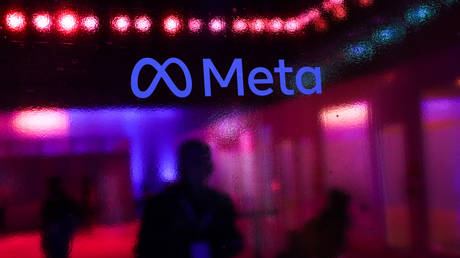 Moderators facing abuse at Meta’s new ‘secret site’ – report
Moderators facing abuse at Meta’s new ‘secret site’ – report
“One real ID for every social network user — that’s the only way to actually guarantee minors don’t access inappropriate content,” Spanish Prime Minister Pedro Sanchez said earlier this year.
Among the countries that have taken measures on the issue, Australia has banned social media access for users under the age of 16. In Spain, a comparable measure has been incorporated into a legislative bill, although it is awaiting parliamentary review and does not yet have a set timeline.
In Norway, the government has announced its intention to establish a minimum age of 15 for accessing social media. However, there is currently no defined timeline or concrete implementation plan in place.
Earlier this year, 200 schools in France started testing a “digital break” that prevents students up to the age of 15 from using smartphones during school hours.
In Russia, similar restrictions went into effect in September, banning students from using their cellphones in schools, except for emergency situations involving a risk to health or to life.
-
Site: RT - News
Gwyn Jenkins reportedly withheld evidence of extrajudicial SAS executions in Afghanistan instead of forwarding the matter to military police
The British government has appointed General Gwyn Jenkins as First Sea Lord and Chief of the Naval Staff. Approved by King Charles III on Thursday, the decision follows unresolved allegations that Jenkins had failed to report suspected war crimes in Afghanistan and later obstructed the relocation of key witnesses.
The general succeeds Admiral Ben Key, who stepped down last week amid an ongoing misconduct investigation. Media reports suggest that the probe centers on Key’s alleged affair with a more junior female colleague.
Jenkins came under scrutiny two years ago when the BBC reported that the then-Vice-Chief of the Defense Staff had failed to forward evidence of Special Air Service (SAS) soldiers executing handcuffed detainees in Afghanistan to the Royal Military Police.
At the time, Jenkins did not respond to the allegations. The UK Ministry of Defense stated that it was “not appropriate for us to comment on allegations which may be within the scope of the statutory inquiry.”
In April 2024, then-Prime Minister Rishi Sunak appointed Jenkins—then Vice-Chief of the Defense Staff—as National Security Adviser. However, the appointment was later reversed by the incoming government led by Keir Starmer. While Starmer declined to comment on individual appointments, he emphasized the need for an “open and transparent process” for future nominations. Media outlets attributed the reversal to Jenkins’ implication in the ongoing inquiry.
READ MORE: UK special forces had ‘golden pass’ to kill Afghan civilians – officer
Earlier this month, BBC Panorama reported that Jenkins had overseen the rejection of hundreds of relocation applications submitted by Afghan commandos who had served alongside British forces and possessed direct knowledge of UK military operations. The report stated that these rejections effectively blocked key witnesses from reaching Britain and testifying in the public inquiry into the Afghan conflict.
-
Site: Zero HedgeCharter-Cox $34.5 Billion Deal Leapfrogs Comcast As New Cable GiantTyler Durden Fri, 05/16/2025 - 09:15
Charter Communications has agreed to acquire Cox Communications in a blockbuster merger that will create the largest cable TV and broadband provider in the U.S., surpassing Comcast.
The transaction values Cox Communications at $34.5 billion, including $21.9 billion in equity and $12.6 billion in net debt and other obligations. According to a press release, the valuation aligns with Charter's enterprise value-to-2025 estimated Adjusted EBITDA multiple of 6.44x.
Charter, the second largest publicly traded cable company behind Comcast, was up 3% in premarket trading in New York from its Thursday close of $419.57. The Cox family privately holds Cox.
Charter will acquire Cox's commercial fiber, IT, and cloud businesses and contribute Cox's residential cable assets to Charter Holdings.
Cox Enterprises will become the largest shareholder of the combined entity's fully diluted shares outstanding with a 23% stake and have seats on the board.
"This combination will augment our ability to innovate and provide high-quality, competitively priced products, delivered with outstanding customer service, to millions of homes and businesses," Chris Winfrey, President and CEO of Charter, said in a statement.
Winfrey said, "We will continue to deliver high-value products that save American families money, and we'll onshore jobs from overseas to create new, good-paying careers for U.S. employees that come with great benefits, career training and advancement, and retirement and ownership opportunities."
The combined company will remain headquartered in Stamford, Connecticut, and keep a "significant presence on Cox's Atlanta, GA campus following the closing," according to the press release.
The merger with Cox follows Charter's announcement of an all-stock acquisition of Liberty Broadband, with both transactions expected to close concurrently.
Charter expects $500 million in annualized cost synergies within three years of closing the deal.
Bloomberg added context to the merger, describing it as part of an escalating "turf war" in the telecom industry:
Cable and phone companies have been engaged in an intense turf war, seeking to win over customers in areas that others have dominated. Cable providers have been selling their own mobile phone plans by leasing network access from major carriers. At the same time, phone carriers have been poaching home internet subscribers from cable companies.
The bet is that customers will in the future prefer to buy their internet and mobile phone services from the same provider — a trend referred to as convergence. A combination of Charter and Cox would position them to better compete in that environment by allowing them to bundle offerings and more efficiently invest in infrastructure.
Bloomberg Intelligence analysts noted:
"Charter is aggressively marketing its converged mobile fixed bundles at competitive rates to improve subscriber acquisition and retention.
"Regardless, the entire cable sector is being hurt by intensifying telecom competition from both fiber coverage and fixed wireless access."
Axios pointed out:
Some layoffs are expected to result from the merger. Other Cox Enterprises businesses, including Axios and Autotrader, are not directly impacted.
Just like that, the combined entity is set to become America's largest cable TV and broadband provider.
Recall one of the heirs to the Cox empire is a far-left radical...
Fergie Chambers is the heir to the Cox Media empire. He is also a devoted Communist and a fan of Mao (see tattoo on his thigh). He is spending his fortune from capitalism on a proletariat Revolution to overthrow capitalism.
— Xi Van Fleet (@XVanFleet) December 7, 2023
How was he introduced to Communism? By a history… pic.twitter.com/V0KeJutqr7Sigh.
-
Site: Zero Hedge5 Takeaways From Supreme Court Hearing On Nationwide Injunctions, Birthright CitizenshipTyler Durden Fri, 05/16/2025 - 08:55
Authored by Sam Dorman and Matthew Vadum via The Epoch Times,
The Supreme Court on May 15 heard oral arguments in relation to the Trump administration’s request to lift nationwide injunctions placed on the president’s birthright citizenship order.
The decision could determine how judges can address presidential actions.
During the argument, the justices posed questions about how far lower court judges could go in issuing relief from particular policies.
Solicitor General D. John Sauer told the court that nationwide injunctions exceed judges’ authority under Article 3 of the Constitution.
While members of the Supreme Court have criticized nationwide injunctions in the past, they seemed skeptical that it was appropriate to remove the injunctions in this case.
President Donald Trump’s Executive Order 14160, signed on Jan. 20, states that “the Fourteenth Amendment has never been interpreted to extend citizenship universally to everyone born within the United States.”
The executive order has prompted debate over the meaning of the 14th Amendment’s citizenship clause, which states that “all persons born or naturalized in the United States, and subject to the jurisdiction thereof, are citizens of the United States and of the State wherein they reside.”
Here are some takeaways from the arguments, as well as considerations surrounding the Supreme Court’s ruling.
1. No Final Ruling Expected on Constitutionality
The argument stemmed from an emergency request made by the Trump administration to limit three separate nationwide injunctions blocking the president’s birthright citizenship order.
At such an early stage in the litigation, the justices wrestled more with procedural considerations such as the scope of relief rather than the constitutionality of birthright citizenship for illegal immigrants.
However, judges can still consider the likelihood that each side will succeed with its arguments about the more substantive issues. The issue could also reach the Supreme Court again after further deliberation in lower courts, teeing up an opportunity for the justices to make a more definitive ruling on birthright citizenship.
Sauer could have asked the Supreme Court to delve deeper into the constitutional issues, but he did not. Justice Amy Coney Barrett pressed him on this point and asked why he wanted there to be more consideration by lower courts before the justices took on the issue.
“So this one isn’t clear-cut on the merits?” she asked.
Justice Ketanji Brown Jackson said that if Trump’s order is legally wrong, allowing the administration to continue implementing it would be inconsistent with the rule of law.
“It seems to me that your argument says we get to keep on doing it until everyone who is potentially harmed by it figures out how to file a lawsuit, hire a lawyer, etc.,” she said. “And I don’t understand how that is remotely consistent with the rule of law.”
Solicitor General nominee, D. John Sauer, prepares to testify during his confirmation hearing before the Senate Judiciary Committee on Capitol Hill on Feb. 26, 2025. Chip Somodevilla/Getty Images
2. Several Judges Critical of Trump’s Order
During the May 15 arguments, Justices Sonia Sotomayor and Elena Kagan seemed to think that the administration had misinterpreted the 14th Amendment when it ordered a halt to illegal immigrants’ children receiving birthright citizenship.
“As far as I see it, this order violates four Supreme Court precedents,” Sotomayor told Sauer.
Later, Kagan suggested to Sauer that the administration would continue to lose in defending its policy before lower courts. She was asking what incentive the government would have to appeal the case to the Supreme Court if another judge had not issued a nationwide injunction.
“If I were in your shoes, there is no way I'd approach the Supreme Court with this case, so you just keep on losing in the lower courts, and what’s supposed to happen to prevent that?” she asked.
3. Dispute Over Courts’ Historical Authority
Justice Clarence Thomas seemed the most sympathetic to Sauer’s position and suggested that nationwide injunctions do not have a solid historical basis.
Sauer had argued that the first nationwide injunction was issued in 1963 and that the court had consistently said relief should be limited to plaintiffs.
“So we survived until the 1960s without universal injunctions?” Thomas asked.
Sotomayor, meanwhile, asked New Jersey Solicitor General Jeremy Feigenbaum, “We’ve had universal injunctions in some form—correct?—since the founding.”
Both justices asked about the history of courts issuing orders known as “bills of peace,” which resolve a dispute for multiple parties. Sauer described the practice as similar to a modern class action and different from a nationwide injunction. Sotomayor disagreed with that comparison.
4. Alternatives to Nationwide Injunctions?
Justice Brett Kavanaugh suggested that class actions, or lawsuits in which multiple plaintiffs sue on behalf of a larger group of plaintiffs, could take the place of nationwide injunctions.
If nationwide injunctions were not available in this case, people could file class actions, which could “solve a large part of the problem in a way that complies with the rules,” the justice said.
Supreme Court Justices Samuel Alito, Clarence Thomas, Brett Kavanaugh, and Chief Justice John Roberts attend inauguration ceremonies in the Rotunda of the U.S. Capitol on Jan. 20, 2025. Chip Somodevilla/Getty Images
Kelsi Corkran, an attorney for immigration advocacy groups, disagreed, saying such an approach is “just channeling the problems through a different mechanism.”
Kagan said the state of New Jersey, a litigant in the case, is arguing that without the availability of nationwide injunctions, it could face “administrative costs and ... workability problems” as a result of possibly inconsistent court rulings being issued in different states on the citizenship question.
This could also lead to a “magnet problem” as “everybody moves to the state where the more favorable rule exists,” Kagan said.
5. Difficulties Involved in Suing Over Birthright Citizenship
Jackson said the government’s proposal to curtail nationwide injunctions would make it more difficult for people to sue to vindicate their rights.
“Your argument seems to turn our justice system ... into a ‘catch me if you can’ kind of regime ... where everybody has to have a lawyer and file a lawsuit in order for the government to stop violating people’s rights,” she said.
Sauer disagreed, saying that given the status quo, “the ‘catch me if you can’ problem operates in the opposite direction where we have the government racing from jurisdiction to jurisdiction, having to sort of clear the table in order to implement a new policy.”
“Many of us have expressed frustration at the way district courts are doing their business,” Kagan said.
The current system encourages forum-shopping, she said, referring to plaintiffs choosing to file a case in a jurisdiction where they think that the judge will be sympathetic to their case.
During the first Trump administration, litigants sought favorable rulings by filing in courts perceived to be friendly in San Francisco, but in the succeeding Biden administration, litigants filed in Texas, Kagan said.
“There is a big problem that is created by that mechanism,” she said.
-
Site: Zero HedgeSingle-Family Home Permits Plunged In April, But 'Renter Nation' ReturnsTyler Durden Fri, 05/16/2025 - 08:44
A day after homeBUILDER sentiment finally cracked (though still dramatically more 'confident' than homeBUYERS)...
Source: Bloomberg
...and mortgage rates are rebounding higher, Housing Starts and Building Permits expectations were mixed ahead of this morning's print.
The actual data was indeed mixed but both were disappointly below expectations as Starts rebounded just 1.6% MoM (below the +4.0% exp) from the 10.1% MoM collapse last month (small revision higher) while Permits (more forward looking) plunged 4.7% MoM (vs -1.2% MoM)...
Source: Bloomberg
That is the biggest MoM drop in Permits since March 2024, dragging the SAAR down tits lowest since July 2024...
Source: Bloomberg
The drop in Permits was largely driven by a huge 5.1% MoM drop in Single-Family apps (multi-family fell 4.4% MoM) - the biggest drop since Dec 2022...
Source: Bloomberg
Housing starts were dominated by multi-family unit increases (for the third month in a row) as Renter Nation returns...
-
Single-Family down 2.1% to 927K, lowest since July 2024
-
Multi-family up 11.1% to 420K, highest since Dec 2023
Interstingly Starts picked up modestly despite the plunge in Homebuilder future sales expectations.,..
Source: Bloomberg
Perhaps the most shocking chart - that explains why builders are not building single-family homes is that inventories of unsold NEW homes is surging...
Source: Bloomberg
Rate-cut expectations are not helping...
Source: Bloomberg
So, don't bank on The Fed to save the day.
-
-
Site: Zero HedgeUS Futures Rise For Fifth Day In A Row As S&P 6000 LoomsTyler Durden Fri, 05/16/2025 - 08:23
US stock futures are set for a fifth straight session in the green, as US equity funds benefited from their first inflows since the Liberation Day shock, and with 6000 in the S&P now less than a 100 points away. As of 8:00am, S&P 500 futures were up 0.3% after the index closed up 4.5% for the week on Thursday as the latest economic data spurred speculation the Fed will cut interest rates twice this year. Nasdaq futures gained 0.4% with Mag 7 leading (TSLA (+1.1%), GOOGL (+0.9%), and NVDA (+0.7%) are outperforming). The powerful rally this week has pushed the tech-heavy equity benchmark into overbought territory, while the S&P closed Thursday at the highest level since February. Europe’s benchmark Stoxx 600 gauge also gained, heading for a fifth weekly advance. The dollar weakened for a second session against major peers, while the yen and Swiss franc gained, and the 10-year Treasury yield was lower after declining 10 basis points Thursday as traders priced in more Fed cuts: bond yields are lower, with 2-, 5-, 10-, and 30-year yields down by 3.09bp, 3.7bp, 3.5bp, and 2.6bp respectively. Commodities are mostly lower, led by gold while oil reversed earlier losses. Overnight headlines were largely quiet. Today, we will receive University of Michigan Sentiment survey data, where consensus expects a modest bounce (to 53.5 vs. 52.2 prior).
In premarket trading, Mag 7 stocks are mostly higher with the exception of Meta after an equal-weighted gauge of the group fell over 1% on Thursday (Alphabet +1.5%, Tesla +1.1%, Nvidia +0.9%, Amazon +0.4%, Microsoft little changed, Apple +0.1%, Meta Platforms -0.1%). Charter Communications (CHTR) gains 9.4% after agreeing to merge with Cox Communications in a deal that values Cox at an enterprise value of about $34.5 billion. Vistra (VST) is up 5.1% after it said it executed a definitive agreement to acquire seven modern natural gas generation facilities from Lotus Infrastructure Partners for $1.9 billion. Here are some other notable premarket movers:
- Archer Aviation (ACHR) shares rise 5.7%, adding to gains from Thursday following its announcement that the electric vertical take-off and landing aircraft company had been selected as the ‘Official Air Taxi Provider’ for the LA28 Olympic and Paralympic Games.
- Doximity (DOCS) drops 18% after the healthcare-software company’s full-year forecast disappointed, with analysts pointing to a cautious tone from the management team on the call regarding the outlook for market growth.
- Globant (GLOB) shares sink 28% after the technology services provider cut full-year revenue guidance for 2025 to a level that undershot analysts’ expectations.
- Pentair (PNR) shares rise 2.2% after JPMorgan upgrades the water-treatment company to overweight from neutral on expectations of potential guidance upside.
- Quantum Computing (QUBT) shares are up 9.7% after the quantum optics technology company reported its first-quarter results.
- Rocket Cos. (RKT) gains 4.4% after ValueAct Capital Management LLC reported a 9.9% holding in the mortgage finance company, according to a new 13D filing with the US Securities & Exchange Commission.
- Take-Two (TTWO) falls 2% as the video-game publisher’s full-year forecast for revenue came up short.
- Travere Therapeutics (TVTX) shares drop 17% after the biotech’s application for its kidney disease treatment Filspari (sparsentan) failed to get priority review status from the US FDA and is set to face an advisory panel.
One month after the nevertrump media hyperventilated about the "US exceptionalism" trade dying, US equities are back in favor following the de-escalation of trade tensions between the US and China. Stocks are now trading like last month’s rout never happened, even though uncertainty remains about the effect of tariffs on the US economy and the direction that the global trade war will take in the coming months. Bank of America's Michael Hartnett said weekly US equity inflows resumed at $19.8 billion for the first time since Liberation Day. Meanwhile, stocks haven’t been getting rewarded for earnings beats: firms that topped expectations in the first quarter reports saw their share prices rise by less than usual, according to JPMorgan strategists. Meanwhile, Federal Reserve Bank of Atlanta President Raphael Bostic said he expects the US economy to slow this year but not fall into recession.
“For now, we believe that the path of least resistance is still higher for risky assets,” said Mohit Kumar, chief economist and strategist at Jefferies International. “We would start turning a bit more cautious around June/July when we expect the hard data start weakening.”
Thursday afternoon brought a deluge of 13F filings, which showed hedge funds adding healthcare exposure and cutting tech over the first three months of the year. Michael Burry’s Scion Asset Management liquidated almost its entire listed equity portfolio in the first quarter. Meanwhile, Warren Buffett’s Berkshire Hathaway trimmed its holdings of financials stocks.
Traders are also watching negotiations around the US budget with its promise of large tax cuts and the potential impact that will have on the fiscal deficit.
Elsewhere, Japan’s economy shrank for the first time in a year as the surging yen crushed exports, illustrating its vulnerability even before sustaining the impact of Trump’s tariff measures. Paradoxically, the yen gained 0.2% on Friday to trade around 145 per dollar even as Bank of Japan official Toyoaki Nakamura, the most dovish board member, warned against hurrying to raise the benchmark interest rate.
Europe’s benchmark Stoxx 600 gauge also gained, heading for a fifth weekly advance as cooling global trade tensions improve investor sentiment and corporate earnings season comes in better than expected. Health care and food and beverage sectors outperform. Among single stocks Richemont rises after reporting a rise in full year sales. Here are the most notable European movers:
- Richemont shares rise as much as 5.5% after the Swiss firm’s jewelry division saw strong growth thanks to demand for its high-end Cartier and Van Cleef & Arpels brands.
- Orsted shares rise as much as 2.1%, snapping three days of declines, after UBS analysts say the stock is pricing in a “close to worst case” scenario when it comes to a potential halt order on the Danish company’s two US offshore projects.
- 1&1 shares soar after its parent United Internet submitted a partial offer to acquire as much as 9.19% of 1&1 shares, for a cash consideration of €18.5 apiece.
- Tate & Lyle shares gain as much as 3.1%, among the best performers in the Stoxx 600’s food, beverage and tobacco subgroup, after Citi upgrades the stock to buy from neutral, saying the risk/reward “looks attractive.”
- CVC Capital shares climb as much as 5.4%, to the highest in six weeks, after Morgan Stanley upgrades its recommendation on the alternative investment manager to overweight, seeing scope for recovery after recent underperformance.
- Nibe falls as much as 4.1% after Handelsbanken cut its recommendation on the Swedish heat-pump manufacturer to sell from hold, quoting recent strong share performance.
- Eutelsat shares drop as much as 11% after the satellite operator said on earnings call that it’s “far too early” to discuss the European Union’s revenue commitment to its next-generation low-earth orbit satellites, dampening hope of enhanced government support in the near term.
- Rubis shares fall as much as 3.7% after the French energy solutions firm said Nils Christian Bergene will step down as chairman and a member of the supervisory board, a departure that CIC analysts called a surprise.
- Workspace Group shares fall as much as 11% after the landlord to mostly small- and medium-sized London businesses warned rising vacancies in its portfolio will dent profits.
- Future shares decline as much as 9.2% after the UK specialist publisher said its FY25 organic revenue will face a low-single-digit decline, below estimates.
- Tokmanni falls as much as 14%, the most since last July, after the Finnish retail group missed expectations in its first-quarter report.
- Dino Polska drops as much as 7.5%, most since August, as Poland’s food retailer reported slowing like-for-like sales in 1Q, raising concerns about its business model and triggering profit taking after 42% rally YTD.
Earlier in the session, Asian stocks traded in a narrow range as the rally sparked by US-China trade talks continued to cool and earnings from Chinese e-commerce giant Alibaba underwhelmed. The MSCI Asia Pacific Index swung between a gain of as much as 0.3% and loss of 0.2%. NetEase was the biggest contributor to the gains, after the China-based video-game company reported first-quarter results that beat expectations. Meanwhile, Alibaba was among the major drags, after its quarterly revenue missed estimates and cloud business disappointed. Key indexes dropped in mainland China, Hong Kong and India, while benchmarks rose in Australia and Taiwan. Goldman Sachs strategists raised their 3-month and 12-month targets for the MSCI Asia Pacific ex-Japan Index to 610 and 660, respectively, from 570 and 620, expecting “moderately higher” returns for the region thanks to improved earnings growth amid a better-than-expected outcome to US-China trade talks.
In FX, the Bloomberg Dollar Spot Index fell as much as 0.2%, declining for the second straight day; it is on track to end the week 0.1% higher; the yen and Swiss franc among the beneficiaries.
In rates, the 10-year Treasury yield was lower after declining 10 basis points Thursday as traders added bets on Fed rate cuts; treasuries are richer across the curve with futures adding to Thursday’s gains and 10-year yields dropping back to 4.405% and near 100-DMA. US yields richer by 2bp to 3bp across the curve with spreads broadly within a basis point of Thursday close; in the 10-year sector bunds and gilts outperform Treasuries by 2.5bp and 1.5bp so far on the day.
In commodities, gold fell to extend its weekly loss as demand for haven assets waned. Oil prices declined after Iran’s foreign minister cast doubts on the status of US-Iran nuclear talks.
Looking at today's US data calendar, key events includes April housing starts/building permits, import/export price index, May New York services business activity (8:30am), University of Michigan sentiment (10am) and March TIC flows (4pm). Fed speaker slate includes Daly at 9:40pm
Market Snapshot
- S&P 500 mini +0.3%
- Nasdaq 100 mini +0.3%
- Russell 2000 mini +0.4%
- Stoxx Europe 600 +0.6%
- DAX +0.7%, CAC 40 +0.6%
- 10-year Treasury yield -3 basis points at 4.4%
- VIX -0.2 points at 17.66
- Bloomberg Dollar Index -0.1% at 1228.52
- euro +0.2% at $1.1208
- WTI crude -0.3% at $61.45/barrel
Top Overnight News
- Donald Trump said he’d set tariff rates for US trading partners “over the next two to three weeks.” BBG
- US Deputy Treasury Secretary Faulkender said he is not concerned about persistent increases in prices, while he added that inflation will return to target levels and they are setting the foundation for the US economy to take off in H2.
- The Trump administration plans to put a number of Chinese chipmaking companies (including memory chipmaker ChangXin Memory) on an export blacklist, but some officials want to delay the move to avoid hurting efforts to strike a long-term trade agreement with China. FT
- Hopes faded for Russia-Ukraine talks set to take place today in Istanbul. The focus now shifts to when Trump may meet Vladimir Putin.
- US President Trump says deals from his trip are worth USD 12-13tln, includes deals already announced and some that will be outlined "very shortly". Will be sending out letters to nations for trade deals soon.
- China approves 10 nuclear reactors, putting the country on pace to surpass the US in nuclear power capacity by 2030. Nikkei
- NVDA is seeing to build a research and development center in Shanghai that would help the world’s leading maker of AI processors stay competitive in China, where its sales have slumped due to tightening US export controls. FT
- Japan’s Q1 GDP falls short of expectations, dropping 0.7% on an annualized basis vs. the consensus forecast of -0.3%, with the shortfall driven by weak consumption and higher imports. Nikkei
- Japan has signaled it is prepared to hold out for a better deal with the US over trade tariffs, pushing for full removal of his 25% duty on imports of Japanese cars rather than risk a domestic political backlash. FT
- The Fed’s Raphael Bostic said in a May 14 interview that he expects the US economy to slow this year but not fall into recession, and reiterated that he sees one rate cut in 2025. BBG
- The cost to ship a container of Chinese-made goods to the U.S. is jumping as importers race to pull cargo across the Pacific during a 3 month trade war truce. Freight rates from China to the US west coast have risen about 8% this week as bookings have boomed. Importers rushing to ship Chinese goods to the US during a short reprieve from higher tariffs may boost freighters. The surprise truce is seen causing a surge in transpacific shipping, Bloomberg Intelligence said. BBG, WSJ
- BofA card spending, week to May 10th: -1.3% (1.0% April average), spending has seen a recovery from the Easter slowdown.
Tariffs/Trade
- US President Trump's administration is reportedly split on adding Chinese chip makers to export blacklists as some US officials fear the move could jeopardise trade talks with Beijing, while the Commerce Department has compiled a list of Chinese companies including memory chipmaker ChangXin Memory to add to the 'entity list' although the timing of the move has been complicated by the recent agreement by China and the US to cut tariffs, according to sources cited by the FT.
- US told Vietnam its trade deficit is unsustainable and a major concern amid tariff talks, according to Vietnam state media.
- Mexican President Sheinbaum spoke with Canadian PM Carney regarding the importance of USMCA in strengthening the competitiveness of the three North American countries, while they also discussed the continuity and strengthening of the seasonal agricultural worker program.
- Greenland's Foreign Minister has suggested that she wants to deepen bilateral ties with the EU, highlighting Greenland's mineral resources as an area for collaboration, via Politico.
- Japan has reportedly indicated that it is prepared to hold out for a better deal with the US, pushing for the full removal of the 25% duty on car imports, via FT.
A more detailed look at global markets courtesy of Newsquawk
APAC stocks traded mixed after the recent soft US data releases spurred Fed rate cut bets, while participants also digested weak data from Japan and earnings reports. ASX 200 was led by strength in miners and outperformance of gold producers after the recent rally in the precious metal. Nikkei 225 initially retreated amid recent currency strength and after GDP data for Q1 showed a steeper-than-expected contraction in Japan's economy, although the index gradually recovered and returned to flat territory as USD/JPY regained some composure and with the weak data effectively narrowing the scope for the BoJ to resume normalisation. Hang Seng and Shanghai Comp declined with sentiment dampened by earnings releases after Alibaba's results underwhelmed which pressured its Chinese blue-chip tech and ecommerce peers such as Tencent, Meituan and JD.com.
Top Asian News
- BoJ Board Member Nakamura said Japan's economy has recovered moderately, but some weakness has been seen, while he added the economy is facing mounting downward pressure due to the implementation of US tariff policies. Nakamura said the momentum for wage hikes has accelerated but could weaken depending on impact of US tariff policies and noted that it is appropriate to keep monetary policy steady for the time being. Furthermore, he said uncertainty over the economic outlook is heightening, so a cautious monetary policy approach is necessary and hiking rates prematurely when growth is slowing could curb consumption and capex.
- Japan's Economy Minister Akazawa said improvements in job and income conditions are likely to underpin moderate economic recovery, while he added must be mindful downside risk to the economy from US trade policy and the hit to consumption and household sentiment from sustained price rises also becoming a downside risk to Japan's economy.
European bourses (STOXX 600 +0.6%) opened modestly firmer across the board, and have traded with an upward bias this morning. European sectors hold a strong positive bias, with only a handful of industries in negative territory. Healthcare takes the top spot, with gains in the sector seemingly broad based. In terms of stock specific stories, Sanofi (+2.2%) gains after it received FDA orphan designation for treating sickle cell disease. Bayer (+3.5%) benefits from an FT report which suggested it is seeking a Roundup settlement.
Top European News
- ECB's Villeroy says "we are not currently in a currency wars situation but rather a trade war situation".
- ECB's Kazaks says a meeting by meeting approach at the ECB is right and notes a lot of uncertainty around trade measures, according to CNBC.
FX
- Dollar is on the backfoot, continuing the pressure seen following Thursday’s disappointing Retail Sales and softer-than-expected PPI data. As a reminder, this led money markets to fully price in two Fed cuts by year-end; currently pricing in roughly 57bps. DXY currently sits in a 100.52-78 range. Further downside for the index will see a potential test of the week’s trough at 100.27 – should that be taken out, 100.00 will be next in focus. Ahead, US Import Prices, UoM Survey and commentary from Fed's Barkin.
- EUR is modestly firmer vs the Dollar, with specific for the Bloc very light today – Final Italian inflation metrics were revised marginally lower but ultimately had little impact on the Single-Currency. Commentary via ECB’s Kazaks and Villeroy this morning has not added too much to the agenda; the former reiterated the need for a meeting-by-meeting approach and highlighted the uncertainty around trade. This morning EUR has climbed back above the 1.12 mark and has traded in a busy 1.1182-1.1219 range.
- JPY is slightly firmer vs the Dollar after choppy price action overnight, which saw USD/JPY initially trickle lower amid initial haven flows into the yen and recent declines in US yields, but later bounced off support at the 145.00 level. USD/JPY was little moved following weaker-than-expected GDP data. USD/JPY currently trading around 145.30 in a 144.93-145.68 range
- GBP is flat/incrementally firmer vs the Dollar and holds just above the 1.33 mark, in a very thin 1.3300-1.3320 range. UK-specific updates have been lacking today. Some focus has been on an FT article which suggested that EU leaders are urging UK PM Starmer to improve the region’s mobility deal – particularly for EU students.
- Antipodeans are the best performers vs the Dollar, nursing some of the losses seen in the prior session. The Kiwi is the best G10 performer today; overnight, New Zealand 1yr and 2yr inflation expectations are both seen higher, which may explain some of the outperformance in today’s session. Do note that the NZD is outmuscling the AUD in the AUD/NZD cross; some traders may be focused on next week’s RBA meeting, where markets widely expect the Bank to deliver a 25bps cut.
- PBoC set USD/CNY mid-point at 7.1938 vs exp. 7.2085 (Prev. 7.1963).
Fixed Income
- Firmer start to the day as USTs continue the data-induced upside from Thursday with newsflow since a little light and markets largely awaiting updates on numerous geopolitical situations. At the top-end of a 110-10 to 110-20 band. As it stands, on track to end the week almost flat, opened the week at 110-18, despite the marked pressure seen in the first half on US-China progress. Trade developments that sparked notable hawkish action Monday through Wednesday, before being offset by Thursday’s data deluge. Ahead, the docket is comparably light but does feature Building Permits/Housing Starts, Import Prices (factor into PCE) and the prelim. Uni. of Michigan series for May.
- Bunds are in-fitting with USTs, but with action slightly more pronounced as EGBs experienced a marginal rally early doors as European players entered the fray and reacted to the bullish bias of APAC trade. Specifics light. A few ECB officials on the wire but nothing that has fundamentally shifted the narrative. Bunds just off highs in a 130.11-50 confine and, as with USTs, near-enough on track to end the week flat despite a WTD range in excess of 135 ticks.
- Gilts are outperforming slightly, likely on account of the marginal underperformance vs Bunds seen at points this week and as such, the UK is catching up on the final session of the week. As above, Gilts are also set to end the week essentially unchanged, currently just off highs in a 91.84-92.00 band. Resistance at 92.59 from mid-April and thereafter 93.00 before highs from the last few weeks, beginning at 93.59.
Commodities
- A hesitant start for WTI and Brent as geopolitics dominates ahead of the weekend. WTI and Brent traded largely flat through the morning but are currently down by around USD 0.10/bbl, nearing overnight lows.
- In terms of Iran-related headlines, crude prices whipsawed on conflicting media reports yesterday and mixed signals from US and Iranian officials. This morning, Iran's Foreign Minister stated that negotiations will continue as long as the other party remains engaged, maintaining that no formal proposal from the US has been received.
- On Russia-Ukraine, talks are underway in Istanbul, with the Trilateral meeting between Turkey-US-Ukraine supposedly concluded. We are yet to hear the readout from it. Ahead, there will be another trilateral meeting, this time with Russia taking the place of the US.
- Spot gold is continuing losses, pulling back from yesterday’s gains after soft data, lower yields and Fed rate cut bets aided the yellow metal. At the time of writing, the yellow metal trades towards the upper end of a USD 3,205.49-3,252.17/oz range.
- Base metals are softer after the subdued mood in its largest buyer, China, overshadows the positive sentiment in Europe this morning. 3M LME Copper currently rests within, but at the lower-end of, a USD 9,474.9-9,591.42/t range.
- Shanghai Copper warehouse stocks +27.44k/T (prev. -8.60k/T), Aluminium stocks -13.59k/T (prev. -6.19k/T)
- ADNOC Chief says the UAE and the US plan investment of USD 440bln in the energy sector through 2035.
Geopolitics
- US President Trump says he is willing to meet with Ukrainian President Zelensky and Russian President Putin as soon as arrangements can be made; going to take care of Gaza; will make good progress on geopolitical situations in the next two or three weeks In one way or another, will take care of Iran.
- Iranian Foreign Minister says the nation's position is clear and we are ready to build confidence and adopt transparency in our Nuclear Programme in exchange for the lift of sanctions. Not received any agreement proposal from the US; is possible will be informed via a meditator
- Hamas is reportedly holding direct negotiations with the US Administration, according to a senior Hamas official cited by Al Arabiya.
US Event Calendar
- 8:30 am: Apr Housing Starts, est. 1363.5k, prior 1324k
- 8:30 am: Apr P Building Permits, est. 1450k, prior 1467k
- 8:30 am: Apr Import Price Index MoM, est. -0.3%, prior -0.1%
- 10:00 am: May P U. of Mich. Sentiment, est. 53.5, prior 52.2
- 4:00 pm: Mar Net Long-term TIC Flows, prior 112b
- 4:00 pm: Mar Total Net TIC Flows, prior 284.7b
Central Banks
- May 16: Fed’s Barkin Gives Commencement Speech
- May 17: Fed’s Daly Gives Commencement Address
DB's Jim Reid concludes the overnight wrap
Markets continued to advance over the last 24 hours, as weak US inflation data and lower oil prices raised expectations that the Fed would still cut rates this year. By the close, that meant the S&P 500 (+0.41%) had posted a 4th consecutive gain, which now brings its advance since the April low to +18.75%. In fact, the index isn’t far away from a +20% gain that would mark the technical definition of a bull market, and futures this morning are pointing to another modest gain. So it’s been an astonishing turnaround from where we were just over a month ago at the height of the tariff uncertainty.
There were several factors driving the rally, but a critically important one was the US PPI data for April. It showed inflation pressures were much softer than expected, with headline PPI down -0.5% on the month (vs. +0.2% expected). So that marked the biggest monthly decline in producer prices since April 2020 and the Covid lockdowns, and it pushed the year-on-year reading down to +2.4% (vs. +2.5% expected). Core PPI was also softer than expected, with the measure excluding food energy and trade down -0.1% on the month (vs. +0.3% expected), which was the first negative print since April 2020. It also helped broader inflation expectations to move lower, and the US 10yr inflation swap fell -4.7bps on the day to 2.50%, marking its biggest decline in over a month.
With investors feeling less concerned about inflation, they then dialled up their expectations for Fed rate cuts in response. For instance, the amount priced in by December up +7.1bps on the day to 56bps. And in turn, that contributed to a large rally in Treasury yields across the curve, with the 2yr yield (-9.0bps) falling back to 3.96%, whilst the 10yr yield (-10.5bps) fell to 4.43%.
Those moves got further momentum from the latest decline in oil prices, which added to the sense that inflationary pressures were easing. The move followed comments from President Trump, who said “I think we’re getting close to maybe doing a deal” with Iran. Moreover, Trump posted an NBC news story citing a top Iranian official that Iran would sign a nuclear deal in exchange for lifting economic sanctions. So the newsflow led to growing expectations that oil supply could rise, and Brent crude fell another -2.36% on the day to $64.53/bbl.
The fall in yields came despite comments from Fed Chair Powell yesterday, who indicated that the Fed were reconsidering the language on average inflation targeting in their latest review. For reference, in 2020 they changed their approach to permit a period of inflation above the 2% target, if it followed a period of inflation running beneath target, so that was a significant shift. However, the potential to move back off that again was seen in a hawkish light, as it implied less tolerance for higher inflation in the future, and Treasury yields briefly spiked as the headlines came through.
Nevertheless, the Powell comments weren’t enough to counteract the broader rally, and there was also relief yesterday that the US data continued to point away from a recession. For instance, the weekly initial jobless claims remained at 229k over the week ending May 10 (vs. 228k expected), so still in their recent range and not signalling a sharper deterioration. In the meantime, the retail sales data showed modest growth of +0.1% in April (vs. unch expected), which was a slowdown from March, but still not the contractionary territory that might be expected in an outright recession. And with the latest data in hand, the Atlanta Fed’s GDPNow estimate for Q2 moved up to an annualised +2.5% pace.
That environment proved to be a strong one for equities on both sides of the Atlantic, with the S&P 500 up +0.41% on the day. The advance was reasonably broad-based, with 75% of the index moving higher. Defensive sectors outperformed, with utilities (+2.12%) and consumer staples (+2.00%) leading the gains for the S&P 500. By contrast, the Magnificent 7 (-1.09%) ended a run of 5 consecutive gains. Within the Mag-7, Meta fell -2.35% following a WSJ report that it was delaying the rollout of a flagship AI model. In terms of other individual moves, Walmart (-0.50%) lost ground after their earnings, and they warned that prices would go up as a result of the tariffs. And Cisco Systems gained +4.85% following their own earnings after the previous day’s close.
Earlier in Europe, bond markets had also rallied on hopes for weaker inflation, and yields on 10yr bunds (-7.7bps), OATs (-8.5bps) and gilts (-5.2bps) all moved lower. There were similar gains for equities, with the STOXX 600 (+0.56%) closing at a 7-week high, alongside a fresh record for the DAX (+0.72%). That positivity was reinforced by strong UK GDP numbers, with Q1 growth running at a quarterly +0.7% pace (vs. +0.6% expected), and the FTSE 100 (+0.57%) closed above its Liberation Day level for the first time.
Overnight in Asia however, the tone has generally been more negative, with several of the major indices losing ground. Sentiment hasn’t been helped by Japan’s Q1 GDP reading, which showed a larger-than-expected contraction, with the economy shrinking at an annualised -0.7% pace in Q1 (vs. -0.3% expected). So that raised fears about how resilient the economy was, particularly given those numbers were before the Liberation Day announcement in April. Against that backdrop, Japan’s Nikkei fell -0.28%, and elsewhere there’ve been losses for the Hang Seng (-0.76%), the CSI 300 (-0.57%) and the Shanghai Comp (-0.52%). That said, there have been some gains, including South Korea’s KOSPI (+0.19%), and Australia’s S&P/ASX 200 (+0.57%).
Looking forward, the planned US budget reconciliation bill will remain in focus today. Politico reported yesterday evening that today’s planned procedural vote in the House Budget Committee may be in peril due to opposition from fiscally hawkish Republicans to the CBO’s scoring of the bill, and proposed delays to Medicaid cuts. Yesterday our US economists published a report (see here) analysing the details of the tax bill released this week, which they see putting the US on course for a 6.5% of GDP fiscal deficit in the coming years.
In geopolitics, it’s also worth keeping an eye on today’s talks between Russian and Ukrainian officials in Istanbul. These mark the first direct talks since spring 2022, but with Moscow sending a relatively low-level delegation, no immediate progress is expected. Trump claimed yesterday that “nothing’s going to happen” in terms of resolving the war in Ukraine until he and Putin meet.
To the rest of the day ahead, data releases include the University of Michigan’s preliminary consumer sentiment index for May, along with April’s building permits, housing starts, and the import and export price indices. In the Euro Area, we’ll get the March trade balance. And from central banks, speakers include the Fed’s Barkin, the ECB’s Lane, and the BOE’s Lombardelli.
-
Site: RT - News
The scandal around Pfizer texts and Covid jabs is giving von der Leyen a taste of her own medicine
Well, this is awkward. How many times has Ursula von der Leyen, European Commission president and unelected de facto ruler of the EU, delivered sermons about transparency like she’s the high priestess of some kind of parallel Brussels Vatican? And now the EU’s own top court has called her out in a ruling for neglecting to practice what she preaches.
Back in 2023, during her State of the European Union address, doing her finest impression of someone elected by the actual public, von der Leyen declared the need to douse any and all sketchiness in sunlight in order to “not allow any autocracy’s Trojan horses to attack our democracies from within.”
“Transparency should characterize the work of all the members of the Commission and of their cabinets,” she said as far back as 2019. “I have asked commissioners…to engage more and be more transparent,” she proclaimed in a speech to EU parliamentarians last year. Transparency and accountability also figured prominently in her bid for reappointment by the EU’s ruling elites last year.
Great news! She can now finally embark on this noble mission, and begin her journey with little more than a simple glance in the mirror. Because the European Court of Justice – the body that rules on whether EU institutions have actually crossed into illegality, not just occupying their usual territory of elite-grade idiocy – has just decided that Queen Ursula’s Commission can’t just wave away a pile of her own Covid-era text messages by going, “Whoops! They disappeared. Oh well, what do you do?” Which is basically what the Commission’s response was to the New York Times when it asked to see those messages.
Read more Court rules on von der Leyen’s secret Covid vaccine deal messages
Court rules on von der Leyen’s secret Covid vaccine deal messages
And how did the Times know that these texts even existed? Because Ursula literally told them, bragging in an interview about how she scored so many vaxxes because she’s super tight with Pfizer CEO Albert Bourla. All this was for a piece spotlighting her Covid efforts, published in April 2021: “How Europe sealed a Pfizer vaccine deal with texts and calls.”
The article featured the same kind of glamour photography reminiscent of the good ol’ days when Ursula was Germany’s defense minister from 2013 to 2019, under former Chancellor Angela Merkel, and doing photo shoots in front of military hardware while accusations swirled that she had bungled the budget with shady defense contracts, even as the Bundeswehr was stuck using brooms for guns during a NATO exercise, as the Atlantic Council reported in 2015.
“For a month, Ms von der Leyen had been exchanging texts and calls with Bourla, the chief executive of Pfizer… Pfizer might have more doses it could offer the bloc – many more,” the NYT piece reads, referring to the “personal diplomacy” that “played a big role in a deal” for 1.8 billion Pfizer anti-Covid doses.
So the Times hears about these text messages and was like, “Oh, cool. Let’s see!”
Suddenly Queen Ursula became a lot less chatty. So the Times took the matter to the EU’s own top court to get the disclosure. And now this court has said, in legal terms, that Ursula can’t just ghost the Times – and the public by extension – without giving a real reason. That there has to be a “plausible explanation to justify the non possession” of the texts. And also, the court says that “the Commission has failed to explain in a plausible manner” why it thought that these messages were so trivial that they could be vaporized like they were just her Eurovision contest text voting and not a matter of public record which, by definition, should be maintained.
Out of these little chats came €71 billion in Covid jab contracts with Big Pharma’s Pfizer and AstraZeneca – 11 of them to be precise, totaling 4.6 billion doses, paid for with cash taken straight from EU taxpayers. Enough for ten doses for every EU citizen.
Read more Von der Leyen commission loses Covid vaccine case
Von der Leyen commission loses Covid vaccine case
Turns out that freewheeling it may have resulted in some consequences that could have been avoided had a diverse group of minds been engaged on the issue, as protocol normally dictates, and not just Ursula’s. It’s not like there hasn’t been a costly fallout from all this. A big chunk of the EU, including Germany, Poland, Bulgaria, Hungary, Lithuania, Estonia, Slovakia, and the Czech Republic, is shouting about surplus doses for which they’re on the hook, urging Brussels to renegotiate the contractual terms with Big Pharma. Germany alone has reportedly trashed 200 million of them. Tricky to negotiate, though, when no one’s even sure what the terms were, as the second-highest European court pointed out last year. “The Commission did not give the public sufficiently wide access to the purchase agreements for COVID-19 vaccines… The Commission did not demonstrate that wider access to those clauses would actually undermine the commercial interests of those undertakings,” it ruled.
The details of these contracts – how they were made, what they say, and how anyone’s supposed to back out of them if citizens politely decline to max out their ten-jab punch card – remain a mystery.
Back in 2024, Brussels more or less shrugged and suggested that it could really only be as transparent as the courts forced it to be. So hey, what can you do? “In general, the Commission grants the widest possible public access to documents, in line with the principles of openness and transparency,” the EU said, underscoring that the lower court ruling “confirmed that the Commission was entitled to provide only partial access.”
Well, good news, guys! Your very own top court just ruled that you can now be a lot more transparent! So go crazy. Be the change that you keep saying you want to be in the world. Nothing is holding you back now. If transparency were a vaccine, this court just gave Ursula a booster. So we’ll see if it takes. I won’t hold my breath.
-
Site: RT - News
A London-based think tank has assessed the time and funding required for preparing for a war without US backing
European NATO members would face a $1 trillion bill over 25 years to replace US military contributions if Washington exited the bloc, according to a study published on Thursday by a British think tank. The EU is planning a militarization drive, which it claims is necessitated by an alleged Russian threat.
Western European leaders have said member states must reduce their dependence on US weapons while implementing a massive increase in military spending. The proposed hike comes amid claims that Russia could attack a NATO member in the coming years. Moscow has denied the allegations and has accused the West of “irresponsibly stoking fears” of a fabricated threat.
The report by the International Institute for Strategic Studies (IISS) outlines the challenges nations would encounter in the event the US withdraws from NATO to focus on confronting China.
According to the IISS, European nations – including the UK – would need to replace some 128,000 American troops, along with a wide array of weapon systems and command infrastructure currently provided by the Pentagon, particularly for air and naval forces.
Read more NATO rocked by corruption scandal
NATO rocked by corruption scandal
”European states would need to invest significant resources on top of already existing plans to boost military capacity,” the report stated. The estimated price tag for replacing American weaponry alone ranges from $226 billion to $344 billion.
Domestic arms manufacturers would face difficulties securing contracts, financing, and skilled labor, while also grappling with regulatory and supply chain hurdles, the report warned. In certain sectors – such as stealth aircraft and rocket artillery – European NATO members currently lack viable alternatives, prompting the IISS to suggest outsourcing production to countries outside the bloc.
Beyond hardware, the study highlighted intangible but critical costs associated with command-and-control functions, space intelligence, and filling high-level leadership roles traditionally held by US officers.
The think tank questioned whether European governments possess the political will to ensure the vast spending required. The administration of US President Donald Trump has accused European NATO nations of taking advantage of American military protection without contributing enough in return.
READ MORE: Washington ready to resume Russia-NATO security talks – Bloomberg
On Thursday, German Foreign Minister Johann Wadephul stirred controversy by vowing to increase defense spending to 5% of GDP, well above Germany’s existing level of 2.1%. The statement, made following a NATO meeting, drew backlash, including from members of Chancellor Friedrich Merz’s coalition. Defense Minister Boris Pistorius later stated that the exact percentage was “not so important” and that Berlin considered 3% to be a more realistic level.
-
Site: RT - News
The push has reportedly been inspired by US Senator Lindsey Graham, who proposed slapping 500% levies on Russian exports
Ukraine’s European backers are considering imposing “punitive tariffs” on Russian exports as part of potential new sanctions set for discussion at the European Political Community summit in Albania on Friday, Politico has reported, citing EU officials.
Western countries have imposed widespread sanctions against Russia since the escalation of the Ukraine conflict in 2022 in a bid to isolate the country, but have held back from a total trade embargo. The restrictions include a ban on Russia’s seaborne oil shipments, cutting the country off from the Western financial system, and freezing around $300 billion in foreign reserves.
The leaders of the UK, France, Germany, and Türkiye are meeting in the Albanian capital for an informal gathering on Friday, which is also being attended by Ukraine’s Vladimir Zelensky.
The talks in Tirana will focus on “dramatically” tightening sanctions against Moscow and include potential “punitive tariffs” on Russian imports, two EU officials told Politico.
EU ambassadors on Wednesday approved a 17th package of sanctions against Russia, which targets nearly 200 oil tankers that the West claims are part of a Russian “shadow fleet,” older vessels operating outside Western insurance systems.
The push for new sanctions has been inspired by US Republican Senator Lindsey Graham, who has proposed “bone-crushing” measures, including imposing 500% tariffs on Russian exports if Moscow resists peace talks. The senator insisted that the goal was “to help the president [Donald Trump]” gain leverage on Russia.
Read more Russia is not afraid of Western sanctions – Kremlin
Russia is not afraid of Western sanctions – Kremlin
“We would take inspiration from the magnitude” of his proposal, one official told Politico.
Earlier this week, French Foreign Minister Jean-Noel Barrot said Western Europe and the US must “go further” and “prepare to brandish devastating sanctions” to “suffocate” the Russian economy “once and for all,” in order to compel Russian President Vladimir Putin to end the Ukraine conflict.
“Russia has found ways around the blockade imposed by Europe and the United States. Turning off the tap in this way is a way of grabbing Russia by the throat,” he told French broadcaster BFMTV on Wednesday.
Russia remains committed to seeking a long-term solution to the Ukraine conflict but will not tolerate being addressed in the “language of ultimatums,” Kremlin spokesman Dmitry Peskov said last week. He earlier noted that Russia is used to Western pressure and is not concerned about new sanctions.
In March, Putin said that a total of 28,595 sanctions had been imposed on Russian companies and individuals in recent years – more than the total number on all other countries combined. According to the president, the West sought to eliminate Russia as a competitor but its economy has only grown more resilient under pressure.
-
Site: Zero HedgeThe Nuclear Missile Launch Sites Buried Under Greenland's Ice RevealedTyler Durden Fri, 05/16/2025 - 04:15
Camp Century, part of a secret Pentagon plan called Project Iceworm, was designed in the late 1950s as a hidden network of nuclear missile launch sites beneath Greenland’s ice. Built in 1959 and abandoned by 1967 due to unstable ice, the facility was meant to store 600 medium-range ballistic missiles.
Today, it lies buried under at least 100 feet of ice, according to the Wall Street Journal, who wrote a lengthy piece on the sites this week.
 Photos: WSJ
Photos: WSJ
Although presented as a research station, its real military purpose remained classified until 1996. Nina Erofeeva explained: "The first [licenses] have been received for the creation of oil storage facilities, in the Krasnoyarsk territory. This was also an unusual case. Russia has never had oil storage facilities. Oil has always been pumped through pipelines. Given recent events and the lack of infrastructure in the Arctic zone, oil storage facilities are needed in several regions. Accordingly, oil will be placed in these oil storage facilities so as not to burn it during pilot development."
With 21 tunnels stretching nearly two miles under the ice, the base housed around 200 personnel and operated on nuclear power. Robert Weiss, a physician stationed there in the early 1960s, recalled: “We did realize that it was important; that the Russians could come over the top of the Pole.”
Life at Camp Century was harsh but bearable. “When I got there, it was blowing snow and minus 50 degrees,” Weiss said, remembering how he spent weeks underground. “It wasn’t very hard living from that standpoint.” Joking about the isolation, he added: “We used to say that there was a pretty girl behind every tree. Of course, there was one problem: There were no trees.”
 Photos: WSJ
Photos: WSJ
The Journal writes that the base’s full scale wasn’t revealed until April last year, when NASA’s cryospheric scientist, Greene, captured the first complete images using advanced ice-penetrating radar. “You see how the buildings and tunnels were connected, how people had to move about in their day-to-day life, and think what a wild experience it must have been to be stationed there,” Greene said.
The U.S. presence in Greenland has long been controversial. During the Cold War, the U.S. operated 17 bases there and stationed about 10,000 troops. Today, fewer than 200 remain at Pituffik Space Base.
Tensions rose again when President Trump openly criticized Denmark for not securing Greenland and even suggested taking the island by force for U.S. security. Denmark reminded Washington of the 1951 treaty that already allows U.S. bases there but firmly rejected any takeover.
 Photos: WSJ
Photos: WSJ
Denmark’s uneasy compromise with U.S. military interests goes back to World War II. In 1941, a Danish envoy in Washington handed control of Greenland’s defense to the U.S. without Copenhagen’s consent. After the war, the U.S. offered to buy Greenland for $100 million, but Denmark refused.
“In the 1940s Denmark learned that if you say no to the U.S., the U.S. will go ahead anyway,” said Ulrik Pram Gad of the Danish Institute for International Studies. “Denmark has been allowed to maintain sovereignty over Greenland by outsourcing some of it—security—to the U.S.”
The U.S.’s undisclosed storage of nuclear weapons in Greenland and a 1968 crash of a nuclear-armed B-52 near Thule Air Base caused long-lasting tensions. More recently, reports of increased U.S. espionage and Trump’s interest in buying Greenland have pushed Greenlanders closer to Denmark.
-
Site: Zero HedgeUkraine Strategic Bitcoin Reserve Bill Reportedly In Final StagesTyler Durden Fri, 05/16/2025 - 03:30
Authored by Zoltan Vardai via CoinTelegraph.com,
Ukraine is reportedly moving closer to adopting Bitcoin as a national reserve asset, a move that could bolster its financial resilience amid the ongoing war with Russia.
Lawmakers are reportedly working on a Bitcoin national reserve proposal, with a draft bill in its final stages, according to Yaroslav Zhelezniak, a member of parliament who confirmed the plan to local media outlet Incrypted.
The proposal was announced during the CRYPTO 2025 conference in Kyiv on Feb. 6.
“We will soon submit a draft law from the industry allowing the creation of crypto reserves,” Zhelezniak said.
Cointelegraph reached out to Zhelezniak for comment on the bill’s status but had not received a response by publication.
Bitcoin has gained international attention as a national reserve asset since the election of US President Donald Trump in November 2024. On March 7, Trump signed an executive order to establish a national Bitcoin reserve seeded with BTC confiscated from criminal cases.
Source: Margo Martin
A month later, Swedish MP Rickard Nordin issued an open letter urging Finance Minister Elisabeth Svantesson to consider adopting Bitcoin as a national reserve asset, citing its growing recognition as a “hedge against inflation,” Cointelegraph reported on April 11.
Legal challenges may delay adoption
While Ukraine’s push for a national Bitcoin reserve marks a potentially historic shift in crypto policy, it may require “significant legal change,” according to Kyrylo Khomiakov, regional head of CEE, Central Asia and Africa, at crypto exchange Binance.
“We commend Ukraine’s ambition to establish a strategic crypto reserve,” he told Cointelegraph.
“Implementing such a reserve would necessitate significant legal changes, indicating that this process will not be swift.”
He added, “Another positive aspect is that this initiative will likely lead to greater regulatory clarity in Ukraine, as the government will need to articulate its stance more clearly.”
Ukraine was reportedly planning to legalize cryptocurrencies in early 2025 with the finalization of a draft bill in coordination with the National Bank of Ukraine (NBU) and the International Monetary Fund (IMF), according to Daniil Getmantsev, head of the tax committee of the Verkhovna Rada.
On April 8, Ukraine’s financial regulator proposed taxing certain crypto transactions as personal income with a rate of up to 23%, excluding crypto-to-crypto transactions and stablecoins.
Not all voices in Ukraine’s crypto industry are optimistic about the timing of the proposal.
”The country is broke. More than 50% of the budget is in grants and loans from the European Union,” said Michael Chobanian, the founder of Ukraine-based Kuna exchange.
“The population is decreasing at the fastest rate in the world. Men are kidnapped and sent to the army against their will. What kind of BTC reserves are we talking about here? This is done only to divert your attention,” Chobanian claimed.
-
Site: Zero HedgeGlobal Population Is Projected To Begin Declining In 2085Tyler Durden Fri, 05/16/2025 - 02:45
The global population is undergoing a major demographic shift.
As fertility rates fall and life expectancy rises, average ages are climbing in nearly every country, while population growth is steadily tapering off.
This infographic, via Visual Capitalist's Niccolo Conte, visualizes global population growth and average age from 1980 to 2100, based on data from the IMF’s World Economic Outlook, April 2025 edition.
How the World Will Age as Population Growth Falls
As of 2025, the average person is 33.6 years old, up from 26.5 years in 1980. Over that same period, global population growth has slowed from 1.8% to 0.9% in 2025.
This trend is expected to continue through the end of the century, as shown in the table below, which breaks down the projected average age and population growth rate from 1980 to 2100:
Year Average population growth (%) Average population age (years) Lower range of expected population growth (%) Upper range of expected population growth (%) 1980 1.8% 26.5 0.9% 2.9% 1985 1.8% 26.9 0.8% 2.9% 1990 1.8% 27.3 0.8% 2.8% 1995 1.5% 28.0 0.5% 2.6% 2000 1.4% 28.9 0.6% 2.4% 2005 1.3% 29.8 0.5% 2.4% 2010 1.3% 30.7 0.4% 2.4% 2015 1.2% 31.6 0.3% 2.4% 2020 1.0% 32.5 0.2% 2.0% 2025 0.9% 33.6 0.1% 1.9% 2030 0.8% 34.7 0.0% 1.7% 2035 0.7% 35.7 -0.1% 1.6% 2040 0.6% 36.6 -0.2% 1.4% 2045 0.5% 37.4 -0.2% 1.3% 2050 0.4% 38.1 -0.3% 1.1% 2055 0.3% 38.8 -0.4% 1.0% 2060 0.3% 39.5 -0.4% 0.9% 2065 0.2% 40.1 -0.5% 0.8% 2070 0.2% 40.7 -0.5% 0.7% 2075 0.1% 41.2 -0.6% 0.6% 2080 0.0% 41.6 -0.6% 0.5% 2085 0.0% 42.0 -0.6% 0.4% 2090 -0.1% 42.5 -0.6% 0.3% 2095 -0.1% 42.9 -0.6% 0.2% 2100 -0.1% 43.2 -0.7% 0.2%The global population is projected to begin declining in 2085, as the average age rises to 42 years. By the year 2100, the average person is expected to be 43 years old, with population growth at -0.1%.
However, the trend is divided across countries. Advanced economies like Japan, Germany, and Italy are aging rapidly and seeing population declines. Meanwhile, emerging economies like India still have growing populations, but the growth is slowing down.
The gradual decline is largely due to falling fertility rates globally, along with improvements in healthcare and life expectancy resulting in larger senior populations.
The Impacts of an Aging Population
Many economies are reaching their demographic turning points—when the share of the working-age population in their total population begins declining.
European countries like Germany, France, and Italy crossed this mark pre-2000, and are now among the world’s “super-aged societies”. The United States, the U.K., and China have followed in the last two decades.
But what does this mean for economic growth and the global economy?
Population aging carries several economic challenges. These include shrinking labor forces, slower productivity growth, and increased fiscal pressure on pension and healthcare systems.
However, there is a silver lining: the IMF notes that while people are living longer, they’re also aging more healthfully. This could result in longer working lives and enhance productivity among older workers, potentially easing the economic impacts of an aging population.
If you enjoyed this infographic, check out A Visual Breakdown of Where Economic Power Lies in 2025, on the Voronoi app.
-
Site: RT - News
The US president’s critic has been accused of making a coded endorsement of violence
The US Secret Service is investigating former FBI director James Comey for making a threat against President Donald Trump, Secretary of Homeland Security Kristi Noem has said. Comey, a longtime critic of Trump, has denied that his cryptic, now-deleted Instagram post was a call for an assassination.
On Thursday, Comey posted an image of seashells that formed the number “8647.” He captioned the image with “cool shell formation on my beach walk.”
Trump administration officials and Republican politicians quickly interpreted the image as a threat to the 47th president. Several media outlets cited the Merriam-Webster dictionary, which defines that “86” is a slang term for “to throw out,” “to get rid of,” or “to kill.” According to Newsweek, the number is a mafia term for taking someone “eight miles out of town” and putting them “six feet under.”
“Disgraced former FBI Director James Comey just called for the assassination of Trump,” Noem wrote on X. She added that the Department of Homeland Security and Secret Service are “investigating this threat and will respond appropriately.” Fox News Digital cited a source in the Secret Service as saying they will send agents to investigate and interview the ex-FBI chief.
Just James Comey causally calling for my dad to be murdered.
— Donald Trump Jr. (@DonaldJTrumpJr) May 15, 2025
This is who the Dem-Media worships. Demented!!!! pic.twitter.com/4LUK6crHATFBI Director Kash Patel said the bureau will “provide all necessary support” to the Secret Service in investigating what he said was Comey’s post “directed at President Trump.”
Read more
White House Deputy Chief of Staff Taylor Budowich argued that Comey’s post “can clearly be interpreted as ‘a hit’ on the sitting President of the United States.” Donald Trump Jr. claimed that Comey was “casually calling for my dad to be murdered.” US teen plotted to kill Trump and flee to Ukraine – FBI
US teen plotted to kill Trump and flee to Ukraine – FBI
Comey has since taken down the image. “I posted earlier a picture of some shells I saw today on a beach walk, which I assumed were a political message,” he wrote on Instagram. “I didn’t realize some folks associate those numbers with violence. It never occurred to me but I oppose violence of any kind so I took the post down.”
Trump fired Comey during his first term in office. He accused the former FBI head of spreading lies about him as part of what he called a politically motivated “witch hunt.”
Donald Trump survived two assassination attempts during his 2024 reelection campaign. In July, a gunman opened fire at a rally in Butler, Pennsylvania, grazing Trump’s ear with a bullet and killing a spectator. In September, a second would-be assassin was discovered camping outside Trump’s golf course in Florida.
-
Site: Zero HedgeLethal Lidar: Volvo SUV's Infrared Beam Fries Smartphone CameraTyler Durden Thu, 05/15/2025 - 17:35
High-powered lidar systems—commonly used in autonomous and semi-autonomous vehicles—emit infrared laser beams to map their environments. While invisible to the human eye, these beams can damage smartphone camera sensors, as one Reddit user recently discovered the hard way.
Reddit user Jeguetelli recently shared a video on the r/Volvo subreddit showing a smartphone camera's image sensor being fried after filming the front-mounted lidar sensor on the Volvo EX90—a fully electric, seven-seat luxury SUV that serves as Volvo's flagship entry into the electric vehicle market.
"Never film the new Ex90 because you will break your cell camera.Lidar lasers burn your camera," Jeguetelli wrote.
Auto blog The Drive pointed out, "It should be said that the risk here is inherent to lidar technology, and has nothing to do with Volvo's specific implementation on the EX90. In fact, earlier this year, the automaker even issued a warning against directing external cameras at the vehicle's lidar pod for the very reasons discussed."
Filming this car's lidar system breaks the phone camerapic.twitter.com/99rfffYS1l
— Interesting things (@awkwardgoogle) May 14, 2025Volvo's website states:
Lidar light waves can damage external cameras: Do not point a camera directly at the lidar. The lidar, being a laser based system, uses infrared light waves that may cause damage to certain camera devices. This can include smartphones or phones equipped with a camera.
"Would this damage your car's backup camera, if a LIDAR equipped car tailgates you?" one Redditor asked.
Another person said, "Thank god for Apple Care."
The ongoing debate in the tech world centers on LiDAR vs. cameras—a big divide in the race toward fully autonomous vehicles, especially when comparing Tesla's camera-only approach to rivals embracing LiDAR.
Elon Musk famously called LiDAR a "crutch," arguing that camera vision powered by advanced AI is sufficient for FSD.
"In my view, it's a crutch that will drive companies to a local maximum that they will find very hard to get out of." Musk said several years ago, adding, "Perhaps I am wrong, and I will look like a fool. But I am quite certain that I am not."
The Counterargument: Tesla's competitors argue that LiDAR provides critical redundancy and reliability, especially for safety-critical applications like robotaxis.
The proliferation of LiDAR sensors on vehicles should come with a public service warning: avoid pointing smartphone cameras at these devices emitting infrared laser beams—they can permanently damage image sensors.
Also, will LiDAR risk burning camera sensors on Tesla vehicles?
-
Site: Zero HedgeUkraine Will Never Recognize Occupied Territories As Russia, Zelensky Says From TurkeyTyler Durden Thu, 05/15/2025 - 14:20
Update(1105ET): "We don’t yet know the official level of Russians, but from what we see, it looks phony," Zelensky told reporters in Ankara. So despite the Ukrainian leader earlier declaring "I am here" upon landing in Turkey, he is not in fact at the Russia-Ukraine talks in Istanbul.
This 'I am here' yet not actually 'there' charade generated some contradictory headlines earlier on Thursday. Zelensky continues his performative gestures aimed at impressing one man: Trump. He even explained that he is sending Defense Minister Rustem Umerov to head the Ukrainian delegation for the Istanbul meeting, now likely underway, out of respect for Trump and the peace process he initiated.
The Kremlin side meanwhile says it's ready to make compromises:
The head of the Russian delegation in Istanbul, Vladimir Medinsky, told Russian state media RIA that Moscow was “ready for discussions.”
“We are ready for discussions, for resuming the Istanbul negotiations; we are prepared for possible compromises and their discussion,” Medinsky said, referring to the last known direct talks between Russia and Ukraine that took place in Istanbul in the spring of 2022.
But apparently not on the table is the only thing which could actually end this tragic war - territorial concessions:
Ukraine’s President Volodymyr Zelensky said Kyiv will never recognize parts of Ukraine that are currently occupied as parts of Russia, as he confirmed peace talks are set to go ahead.
“In all discussions – and I emphasize this – and this is my unwavering position – we do not legally recognize any of our temporarily occupied territories as Russian. This is the Ukrainian land,” Zelensky told journalists.
Still, the fact the two sides are even at the same table in Istanbul is a huge development and start.
⚡️ Russia delegation has been empowered to negotiate with Ukrainian side — Vladimir Medinsky reacts to the lull in Istanbul talks
— RT (@RT_com) May 15, 2025
'We view these talks as a continuation of negotiations BROKEN by Ukraine 3 years ago pic.twitter.com/Kacw5hhDRMAnd again, everything Zelensky is doing appears designed to signal Trump - in order to keep America as Kiev's top weapons backer. "Despite the relatively low level of the Russian delegation, out of respect for President Trump, out of respect for the high level of the Turkish delegation and for President Erdogan, we still want to try to take at least the first steps towards a ceasefire, so I have decided to send our delegation to Istanbul now," Zelensky said further.
Zelensky says he is sending defense minister Umerov for direct talks with the Russians in Istanbul, so that nobody (he means Trump) could accuse Ukraine of not trying to reach peace.
— Yaroslav Trofimov (@yarotrof) May 15, 2025* * *
Russian President Vladimir Putin's investment envoy and close aide, Kirill Dmitriev, has praised US President Donald Trump for putting together Russia-Ukraine peace talks in Istanbul, the first such direct dialogue between the warring countries since early 2022.
Trump and his team have "made the impossible possible" by bringing Moscow and Kiev to the table. Dmitriev further wrote on X that the Istanbul meeting is happening "against all odds/fierce resistance" and that if "not derailed last-minute, this could be a historic step to peace."
Dmitriev also specifically named Vice President J.D. Vance, Trump’s special envoy Steve Witkoff and Secretary of State Marco Rubio - the latter two who are present in Istanbul - as major contributors to the mediation effort. The Kremlin had spent the opening years of the conflict blasting the Biden administration for constantly stoking the war and thwarting dialogue, taking Washington-Moscow relations to new historic lows.
 Via Anadolu Agency
Via Anadolu Agency
As we noted earlier, Ukraine's President Zelensky is actually in Turkey, where he's set to meet with President Erdogan - but separately in the capital of Ankara, and has boasted that "I am here" and that Putin is not. Zelensky has even called the Russian delegation, largely composed of junior officials, "phony".
President Trump meanwhile, while attending meetings in Qatar, was asked by a reporter why the American leader is not himself present in Turkey for the talks:
"Why would he go if I’m not going?"
"I wasn’t planning to go and I didn’t think he would if I didn’t."
"But we have people there. Marco's doing a fantastic job, Marco's there..."
It remains that Putin has little reason or incentive to go, with war analysts widely recognizing that he remains in the driver's seat militarily, and with Ukrainian forces against the ropes.
‘Why would he go if I’m not going?’: Trump reacts to Putin sitting out Istanbul talks
— Chay Bowes (@BowesChay) May 15, 2025
“I wasn’t planning to go and I didn’t think he would if I didn’t.” pic.twitter.com/4YvqvO8gWhZelensky has until now offered no major concessions, and issues like permanent control over Crimea and the four eastern territories remain sticking points for Moscow. Thus there are unlikely to be any major breakthroughs in Istanbul, but the fact that the two sides are even at the table is a big accomplishment.
Below is an important rundown of what's expected in Istanbul and what's at stake for both sides, excerpted from fresh Responsible Statecraft analysis, Istanbul 2.0: know when to hold 'em, know when to fold 'em:
* * *
What has changed since then?
Ukraine will enter the Istanbul talks in a weaker position that it held in 2022.
Western support for Ukraine financially and economically is not as sound as it was then. No big ticket economic aid and assistance has been made available since the G7 agreement of a $50 billion package of loans, in June 2024. While European states scratched together new economic aid to Ukraine in April, this cannot make up for the reduction in US support.
In territorial terms, Russia withdrew from Kyiv as a concession to the first Istanbul talks and lost ground in Kharkiv and in Kherson in late 2022. However, Russia has gone on steadily to gain further territory in the Donbas since the end of 2023. So while both sides have scores on the board, Russia now maintains the military upper hand on the battlefield and that seems unlikely to change. These two factors in particular were behind President Trump’s February assertion that Ukraine has no cards to play.
What has stayed the same?
NATO membership is still off the table
The verified documents shared by the New York Times last June confirmed that Ukraine’s neutrality and non-membership of NATO was the central issue agreed upon in 2022. Ukraine was ready to become a “permanently neutral state” that would never join NATO or allow foreign forces to be based on its soil.
There seems no route for Ukraine to resile from that given its currently weakened negotiating position and President Trump’s stated view that NATO membership for Ukraine is not practical. Although Germany’s new foreign Minister, Johann Wadephul recently repeated the line that Ukraine’s path to NATO is irreversible, most have agreed, privately and publicly, that Ukraine’s path to NATO is a fraught if not impossible one.
Right now, just having the talks is a huge breakthrough
The Istanbul talks would not be happening had the Trump administration not pushed for it so hard. We don’t need to rehash the “did they or didn’t they” debate around why Ukraine abandoned the Istanbul agreement in April 2022. What is clear, is that Ukraine became entrenched, not only in not negotiating with Russia, but in excluding Russia from all discussions on peace in Ukraine from then onward.
Having agreed in principle for Ukraine to accept neutral status Zelensky was pushing his own ten point peace plan. This included, among other things, Russia withdrawing its troops to the pre-2014 border, i.e. giving up Crimea and the Donbass and creating a Euro-Atlantic Security Architecture, by which he meant Ukraine joining NATO. Peace summits were organized in various countries that explicitly excluded Russia, culminating in the Switzerland event on June 15, 2024.
At this event, President Zelensky was dug in deeper on resisting any engagement with Russia until a full withdrawal of its troops from Ukraine, which was a completely unrealistic proposal. “Russia can start negotiations with us even tomorrow without waiting for anything – if they leave our legal territories,” he said.
Even after President Trump was elected, European leaders clung to the line that “only Ukraine can decide what peace means.”’ I see no circumstances in which a Kamala Harris presidency would have cajoled President Zelensky to enter into negotiations. Tomorrow’s talks wouldn’t be happening unless the Trump administration broke a whole load of Ukrainian and European eggshells to get to this point.
 Source: Anadolu Agency
Source: Anadolu Agency
And Responsible Statecraft continues:
The biggest issue now is territory
Even though he was wrongly derided at the time by mainstream media, Steve Witkoff correctly pointed out in his March interview with Tucker Carlson that the territorial issues in Ukraine will be most intractable. Russia’s decision in October 2022 to formally annex the four oblasts of Kherson, Zaporizhzhia, Donetsk, and Luhansk changed the calculus. However, Russia does not have full territorial control of any of those oblasts, which are cut through the middle by a hotly contested front line.
Resolving the line of control when the war ends is, by some margin, the most problematic challenge. This will be a hugely sensitive topic, and European allies will shoot down any major concessions to Russia, as they did when the idea surfaced that the U.S.might de jure recognise Russia’s occupation of Crimea.
The most obvious settlement is a de facto recognition of occupation, a Cyprus-style scenario, that does not stand in the way of Ukraine’s future membership of the European Union. Even that will require detailed agreement on issues around demilitarization of the line of control and enforcing any ceasefire.
Sanctions are probably tricky, but also tractable
As I have said before, there is enormous scope to a plan that allows for the immediate lifting of the bulk of zero-impact measures, phasing out the remainder at points agreed to by both sides. The toughest issue remains the $300 billion in frozen Russian assets, mostly held in Belgium. Russia has shown a willingness to concede this funding to support reconstruction in Ukraine, including those parts that Russia occupies.
But there is texture here. Freeing up those funds for reconstruction would immediately remove the source of interest payments that are meeting Ukraine’s obligations on its $50 billion in debt to the G7, agreed to in June 2024. But the more general policy question arises, how much of the freed up funding would be spent in Ukraine itself and how much in Russian-occupied Ukraine, where most of the war damage has occurred? The U.S. must keep the pressure on to ensure the talks stay on track.
A U.S. presence in Istanbul will be vital, to prevent, in particular, Ukraine from bailing on the talks. That’s why sending Steve Witkoff and Keith Kellogg makes sense. The former is trusted by the Russian side while the latter has built relationships in Ukraine. Their presence serves to keep the process moving forward until a deal can be pushed over the line and the fighting can stop.
Bear in mind that the 2022 talks ran for a month and a half and the circumstances have materially changed as I have indicated above. While there has been speculation that President Trump might drop into Istanbul, I am not sure that this is necessary if President Putin doesn’t himself attend. Knowing the Russians, I assess that Putin will want his own “‘meeting moment” with the U.S. President on terms that the Russian side can better choreograph. Indeed, that may be a prize for Russia’s engagement in the process, given its desire for a more comprehensive reset of relations with the U.S.
-
Site: Zero HedgeTrump Admin Urges Supreme Court To Permit DOGE Access To Social Security RecordsTyler Durden Thu, 05/15/2025 - 14:05
Authored by Matthew Vadum via The Epoch Times (emphasis ours),
The Department of Justice urged the Supreme Court on May 13 to let the Department of Government Efficiency (DOGE) have access to Social Security data after lower courts blocked that access.
 The U.S. Supreme Court in Washington on April 3, 2025. Madalina Vasiliu/The Epoch Times
The U.S. Supreme Court in Washington on April 3, 2025. Madalina Vasiliu/The Epoch Times
President Donald Trump issued Executive Order 14158 on Jan. 20, implementing DOGE, an advisory body that recommends cost-cutting measures. The order directed the entity to “implement the President’s DOGE Agenda, by modernizing Federal technology and software to maximize governmental efficiency and productivity.”
Solicitor General D. John Sauer argued in the new filing that the lower courts have overreached and are attempting to turn themselves into “the human resources department for the Executive Branch.”
The filing came after Ellen Lipton Hollander, a Maryland-based federal district court judge, issued an order on March 20 preventing DOGE from viewing Social Security Administration (SSA) records because such access “violates” the federal Privacy Act.
The lawsuit was brought in February by labor unions and retirees represented by the Democracy Forward Foundation.
“The DOGE Team is essentially engaged in a fishing expedition at SSA, in search of a fraud epidemic, based on little more than suspicion. It has launched a search for the proverbial needle in the haystack, without any concrete knowledge that the needle is actually in the haystack,” the judge wrote in granting a temporary restraining order against the federal government.
DOGE’s team at the Social Security Administration has had “unbridled access to the personal and private data of millions of Americans, including but not limited to Social Security numbers, medical records, mental health records, hospitalization records, drivers’ license numbers, bank and credit card information, tax information, income history, work history, birth and marriage certificates, and home and work addresses,” Hollander wrote.
Hollander directed DOGE to delete any personally identifiable data in its possession. On April 17, Hollander upgraded the temporary restraining order to a preliminary injunction.
On April 30, the U.S. Court of Appeals for the Fourth Circuit voted 9–6 to maintain Hollander’s order while the appeal process continues.
On May 2, the Trump administration filed an emergency appeal with the Supreme Court, asking the justices to pause the preliminary injunction.
In the May 13 filing, Sauer argued that the district court erred in preventing “the 11 members of the Social Security Administration (SSA) DOGE team—from accessing data ... for purposes that are unquestionably lawful.”
The district court “dictated to the Executive Branch which government employees can access which data and even prescribed necessary training, background checks, and paperwork for data access,” Sauer wrote.
“When district courts attempt to transform themselves into the human resources department for the Executive Branch, the irreparable harm to the government is clear,” he wrote.
When the courts “stymie the government’s initiatives to modernize badly outdated systems and combat rampant fraud—leaving those initiatives on a litigation track that may halt them for months or years—the irreparable harm is even clearer.”
Reviewing Social Security Administration data is important because the agency has “one of the largest documented histories of improper payments,” Sauer stated.
In a brief in opposition filed on May 12, the lead respondent, the American Federation of State, County, and Municipal Employees, said that after years of honoring “its data security obligations,” the Social Security Administration “now seeks to throw open its data systems to unauthorized (and often unvetted) personnel who have no demonstrated need for the personally identifiable information ... they seek.”
The April 17 preliminary injunction should be left in place because it is “narrow and, contrary to the government’s assertions, permits SSA to disclose both anonymized and non-anonymized data to DOGE Team members,” the brief said.
The Supreme Court could rule on the government’s emergency application at any time.
Jack Phillips contributed to this report.
-
Site: Zero HedgeDemocratic Senators Remove Trump-Targeting Provisions In Push To Pass Stablecoin BillTyler Durden Thu, 05/15/2025 - 12:05
The US Senate could pass a key bipartisan stablecoin bill as soon as next week after removing language targeting President Donald Trump and his family’s sprawling crypto interests.
As Jesse Coghlan reports below for CoinTelegraph, Republican Senator Cynthia Lummis said onstage at an event by Coinbase’s lobbying arm, Stand With Crypto, that she thinks it's a “fair target” to have the Guiding and Establishing National Innovation for US Stablecoins Act, or GENIUS Act, passed by May 26 — Memorial Day in the US.
Joining her onstage was Democratic Senator Kirsten Gillibrand, who hinted that the bill’s language was changed to scrap provisions that targeted Trump’s various crypto projects, which include memecoins, a crypto platform, a stablecoin and a crypto mining company that plans to go public, among others.
“When this language comes out, people will see really good refinement, a lot of progress, on things like consumer protection, and bankruptcy protection, and ethics,” Gillibrand said.
“Things beyond just ‘what’s the structure?’ and ‘what’s required for an issuer?’”
Senate Democrats pulled support for the bill on May 8 and stalled its momentum, airing concerns that it wouldn’t help address multiple crypto-tied deals that will personally enrich Trump.
“A lot of what President Trump is engaged in is already illegal,” Gillibrand said.
“I also think his issuance of a memecoin is illegal based on current law.”
“It’s literally offering anyone who wants to curry favor with the administration to just send him money — that’s about as illegal as it gets.”
“I’m not so worried about this bill having to deal with all President Trump’s ethics problems. What this bill is really intended to do is regulate the entire space of stablecoins,” she added.
Source: Brian Armstrong
Gillibrand said the revised bill includes “some ethics requirements,” but it was “not an ethics bill.”
“If we were dealing with all President Trump’s ethics problems, it would be a very long and detailed bill,” she added.
Coinbase CEO Brian Armstrong, also on stage, was hopeful the Senate would vote on the stablecoin bill “early next week.”
Armstrong, whose company cozied up to Trump by donating $1 million to his inauguration fund, declined to comment when asked if the President’s memecoin could impact the passage of bipartisan crypto bills.
“It’s not my place to really comment on President Trump’s activity,” he said.
“What I do think is important is that this bill remains focused on stablecoins.”
Crypto bills “absolutely critical” to pass before midterms
The crypto industry is pushing for Congress to pass the GENIUS Act and a Republican-drafted crypto market structure bill before the midterm elections on Nov. 3, 2026, where all 435 House seats and a third of the 100 Senate seats are up for election.
“We have a very narrow window to get legislation through between now and the midterms,” Marta Belcher, the president of the crypto lobby group the Blockchain Association, told Cointelegraph at the Consensus conference in Toronto.
“I strongly suspect that window is going to close very quickly. I don't know if we're going to get another window like this to get legislation through,” she added.
“It's absolutely critical that we get it through now, especially because there really is a real possibility that in the future we end up with an administration that is hostile to crypto.”
The association’s communications director, Chris Jonas, added that it’s critical the bills pass before Congress takes a recess for the month of August.
“Once you get into the calendar year of the midterms, historically not a lot of legislation moves, so that's why it’s so critical,” he explained.
Trump should be on track to sign both crypto bills before the August break, according to Bo Hines, the executive director of the Presidential Council of Advisers for Digital Assets.
Hines noted on stage at Consensus on May 13 that negotiations on both bills are still ongoing, but it was “the President's desire” to sign both “stablecoin legislation and market structure legislation before the August recess."
-
Site: Zero Hedge"Patience To See, Not To Guess"Tyler Durden Thu, 05/15/2025 - 11:50
By Benjamin Picton, Rabobank Senior Macro Strategist
Patience To See
Tech names drove the NASDAQ and S&P500 to further gains yesterday, while the Dow Jones fell for a second-straight session. Semiconductors performed especially well as fund managers caught underweight high-beta US megacaps continued a buying spree that was sparked by a 90-day tariff reduction between the US and China announced on Monday. Nvidia posted a 4.16% gain and AMD was up 4.68% as both companies inked deals with Saudi Arabia to sell more chips for AI applications. European stocks underperformed with most major indexes closing lower, and the Nikkei fell as funds flowed back into Hong Kong’s Hang Seng index and China’s CSI300.
While stocks were rising, US 10-year bond yields poked back above the psychological 4.50% level to close the day up 6bps at 4.54%. 30-year Treasury yields closed half a bip below the intraday highs at 4.98%, which means that yields on both the 10-year and the 30-year are now trading above the levels that were in effect on April 9th when the Trump administration apparently cried “uncle!” in response to bond market pressure and kicked the implementation of reciprocal tariffs into the long grass for 90 days.
Perhaps we are about to find out whether it really was rising bond yields that forced the about face on those reciprocal tariffs, or if Scott Bessent has some other rabbit to pull out of his hat to force long yields lower. Rising bond yields is a problem for America’s chief bond salesman who has trillions of Dollars’ worth of debt to refinance in the months ahead. With the Fed still engaged in quantitative tightening, and enormous budget deficits still being run (despite DOGE), Bessent is going to have to work hard to sniff out other bids, and US homebuyers better hope that he can convince offshore investors that Treasuries yielding 4.5-5% are just too juicy to last. One wonders how durable the rally in long-duration tech can be while yields on long bonds are making new highs.
Fed Speakers yesterday offered no help to the Treasury Secretary by giving the impression that there is no rush to cut the Fed Funds rate any further. Mary Daly said that the Fed had to have “patience to see, not to guess”, which seems to discount the possibility of any kind of pre-emptive policy action. Daly also said that if you take a step back from all the tariff uncertainty the underlying economy is experiencing solid growth, with a strong labor market and declining inflation. That assessment might be a little bit like saying that the Dinosaurs were in really good shape if you ignore the uncertain effects of the approaching meteor.
In the land of hard data, the US economy shrank in Q1 because of a surge in imports that could be replicated in Q2 as the 90-day reprieve on China tariffs encourages importers and retailers to “reload the gun” on goods inventories. Two consecutive quarters of negative growth is the definition of a recession, but get ready for plenty of commentators to suggest that this one doesn’t really count (it wouldn’t be the first time!).
Meanwhile, President Trump continues his dealmaking tour of the Middle East where Qatar has now reportedly agreed to purchase as many as 210 new jets from Boeing. This comes off the back of the semiconductor, energy and military hardware deals signed in Saudi Arabia, Trump’s announcement that sanctions on Syria will be lifted and his meeting with the new Syrian President, who he urged to normalize relations with Israel.
It’s worth pointing out that while the markets were mostly focused on deals to sell more US chips and US energy, there were also announcements of new sanctions on companies facilitating the sale of Iranian oil to China and a new guidance issued by the Commerce Department that the use of Huawei’s Ascend AI chips “anywhere in the world” constituted a violation of US export controls.
As this Daily noted yesterday, 90-day tariff reduction notwithstanding, what is happening in the Middle East and with trade more broadly should serve as a signal that geopolitical competition between the United States and China isn’t going away.



